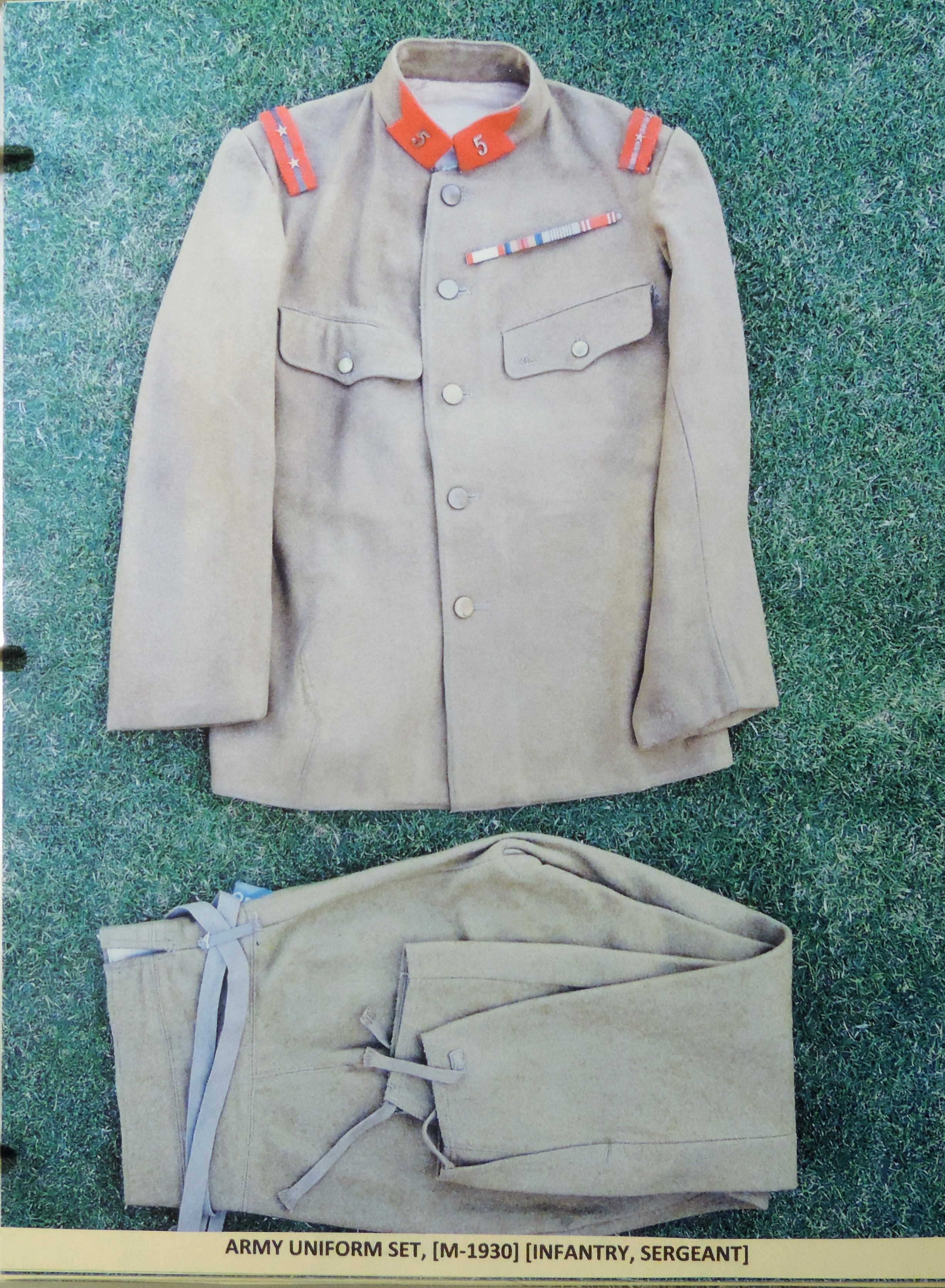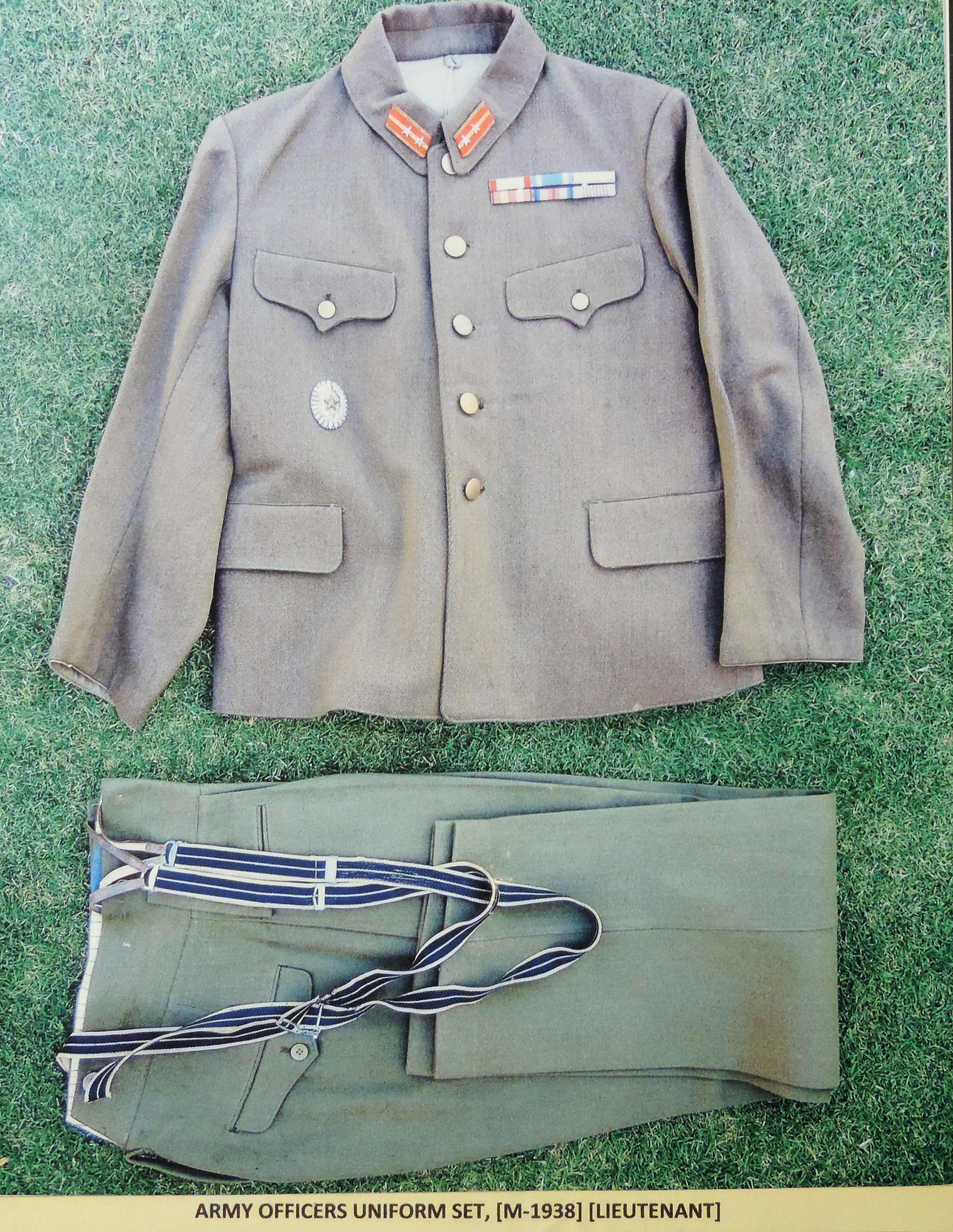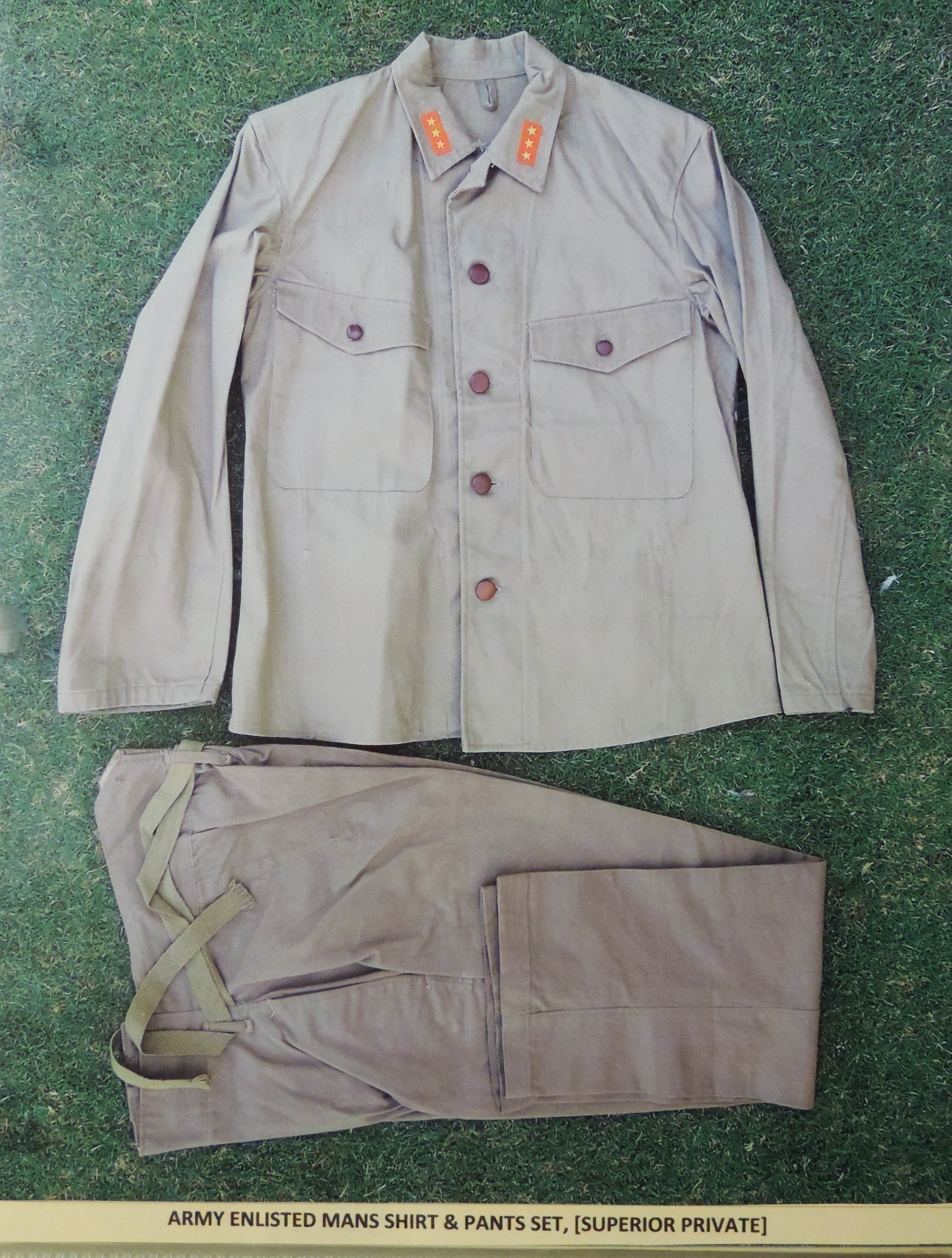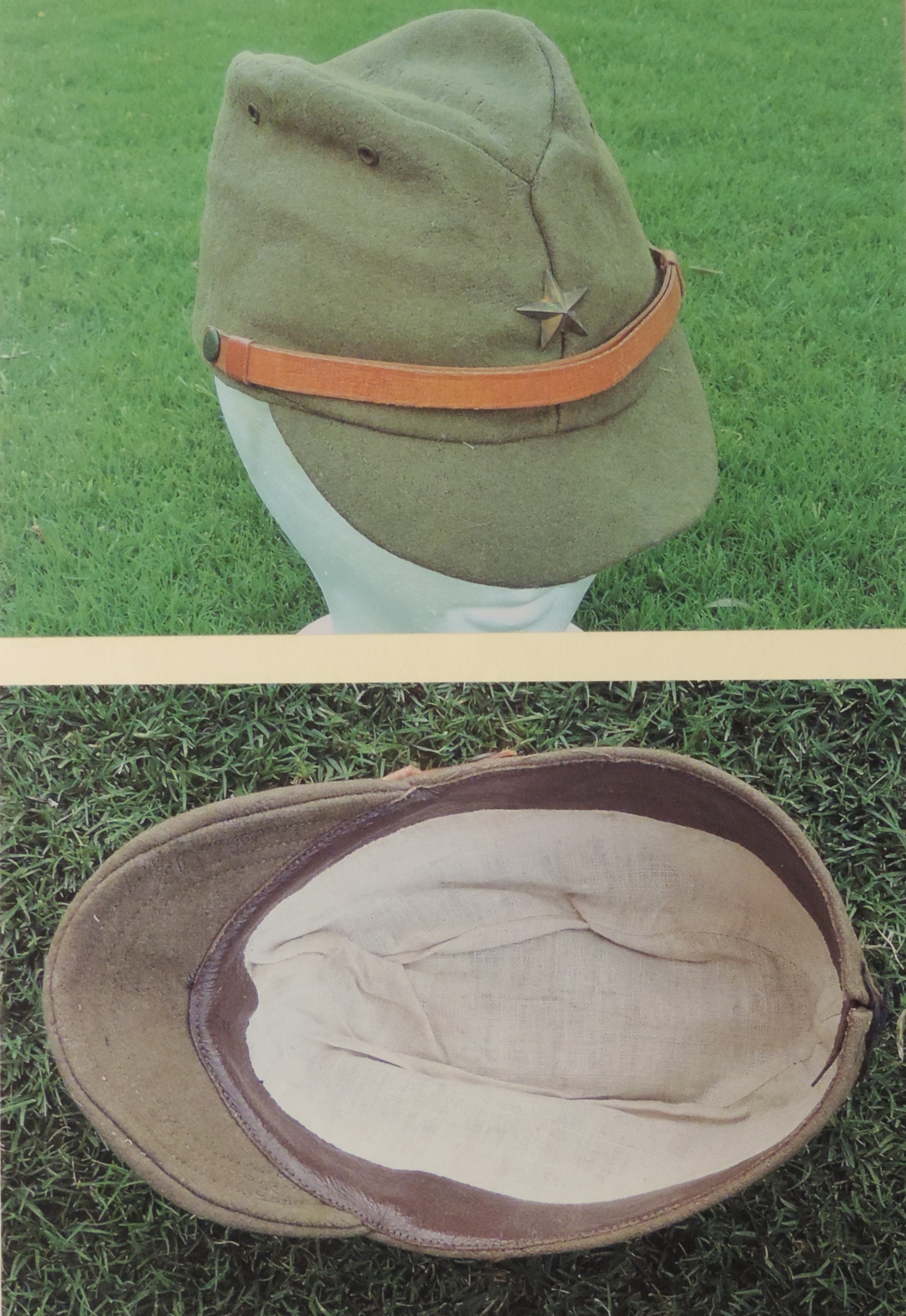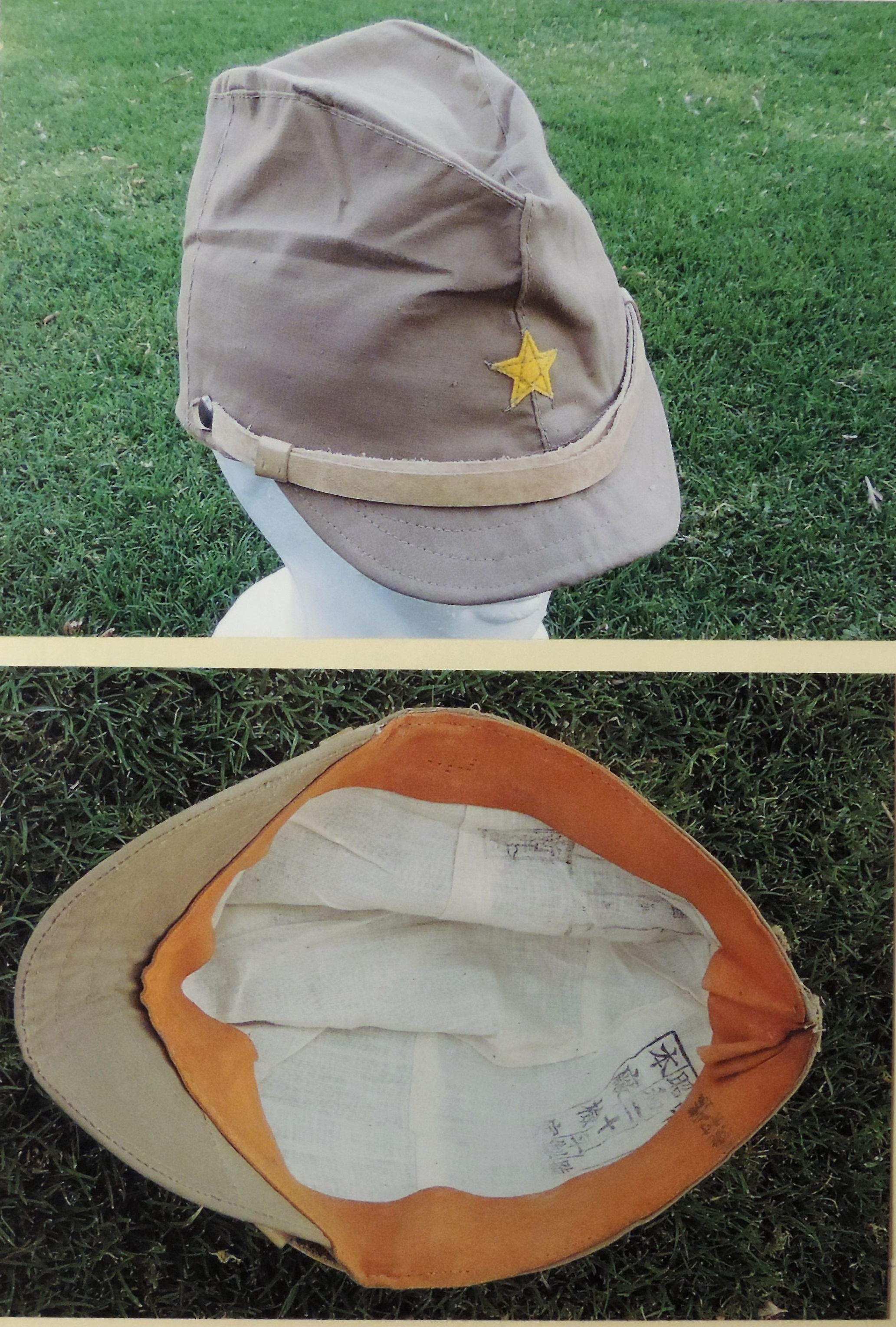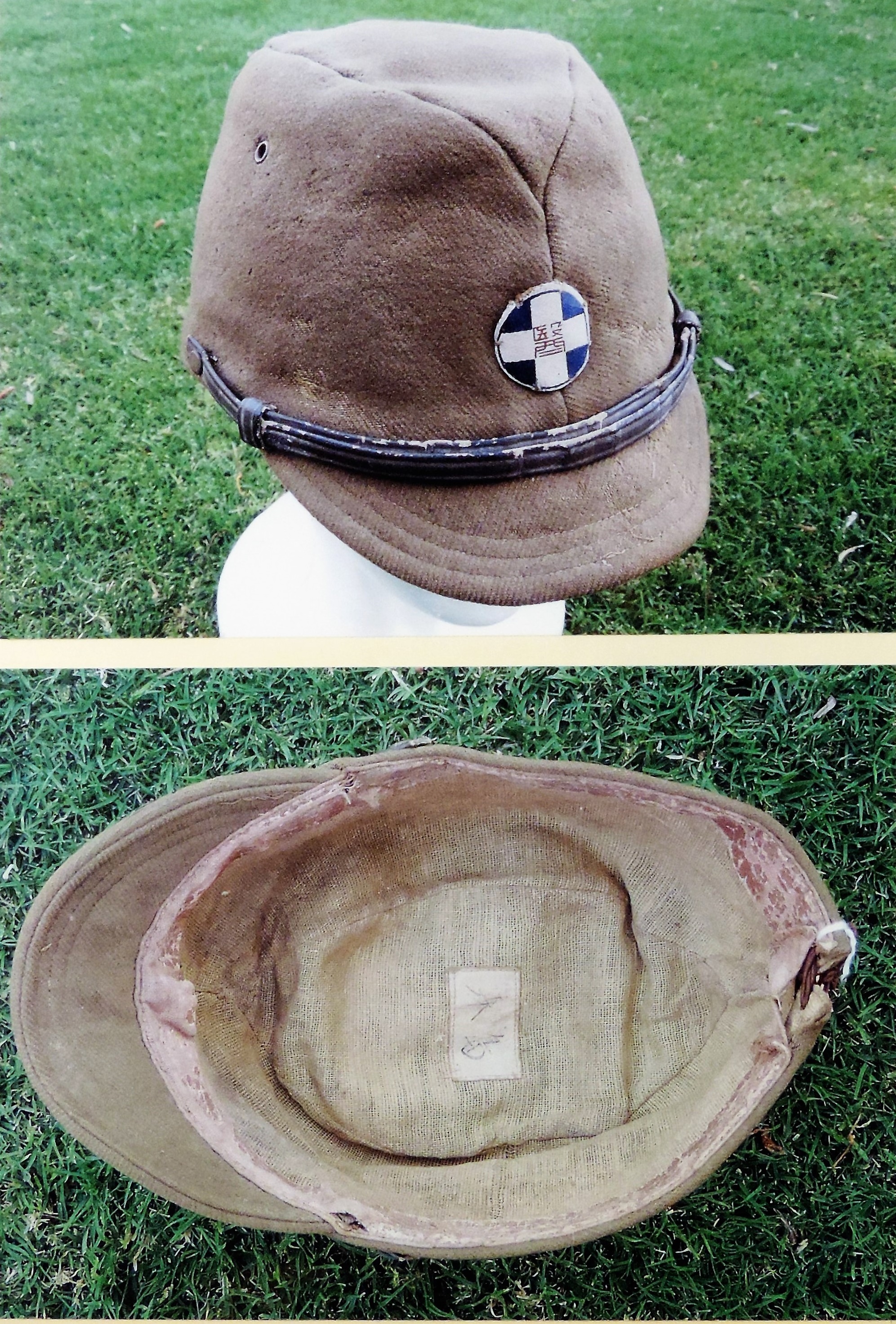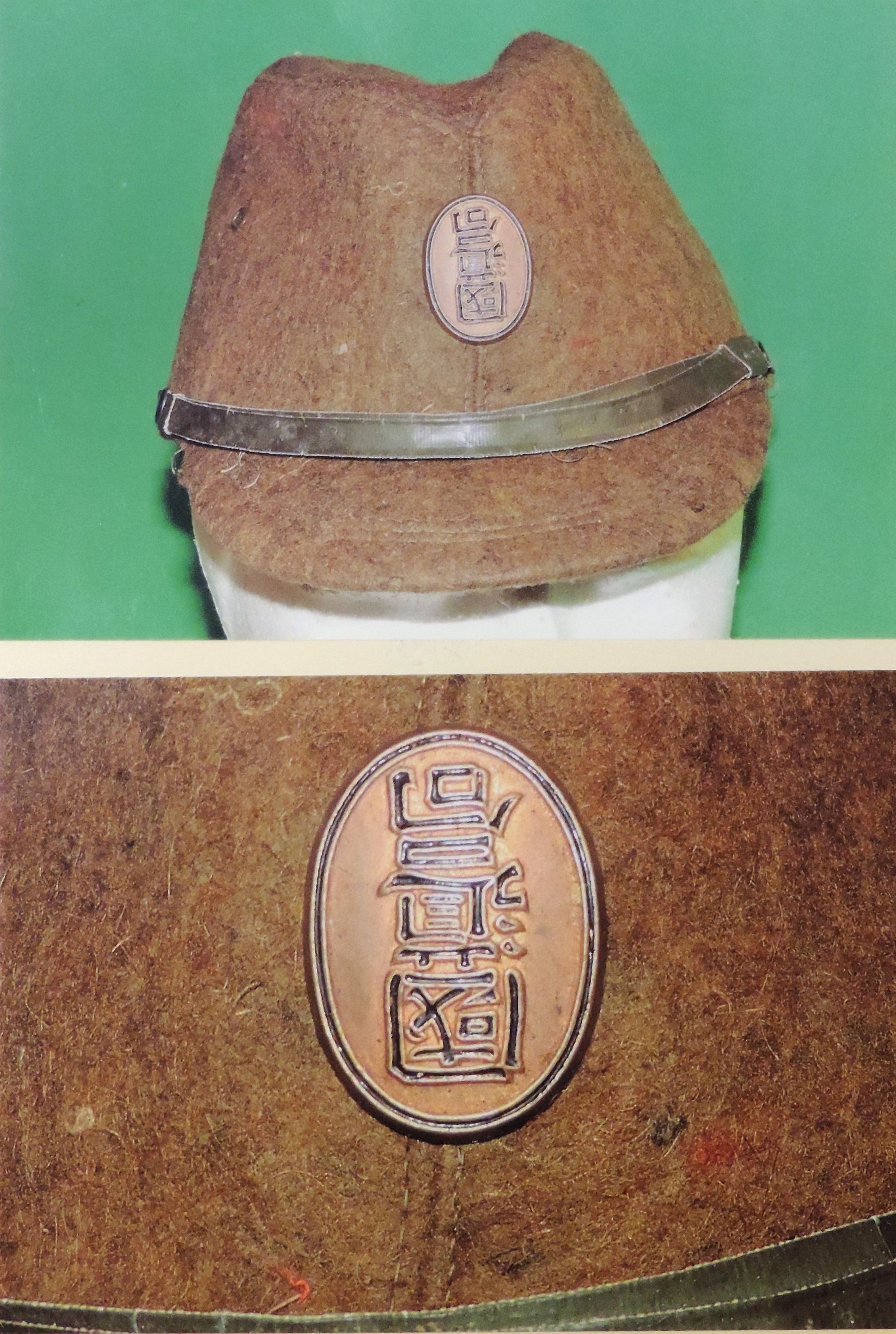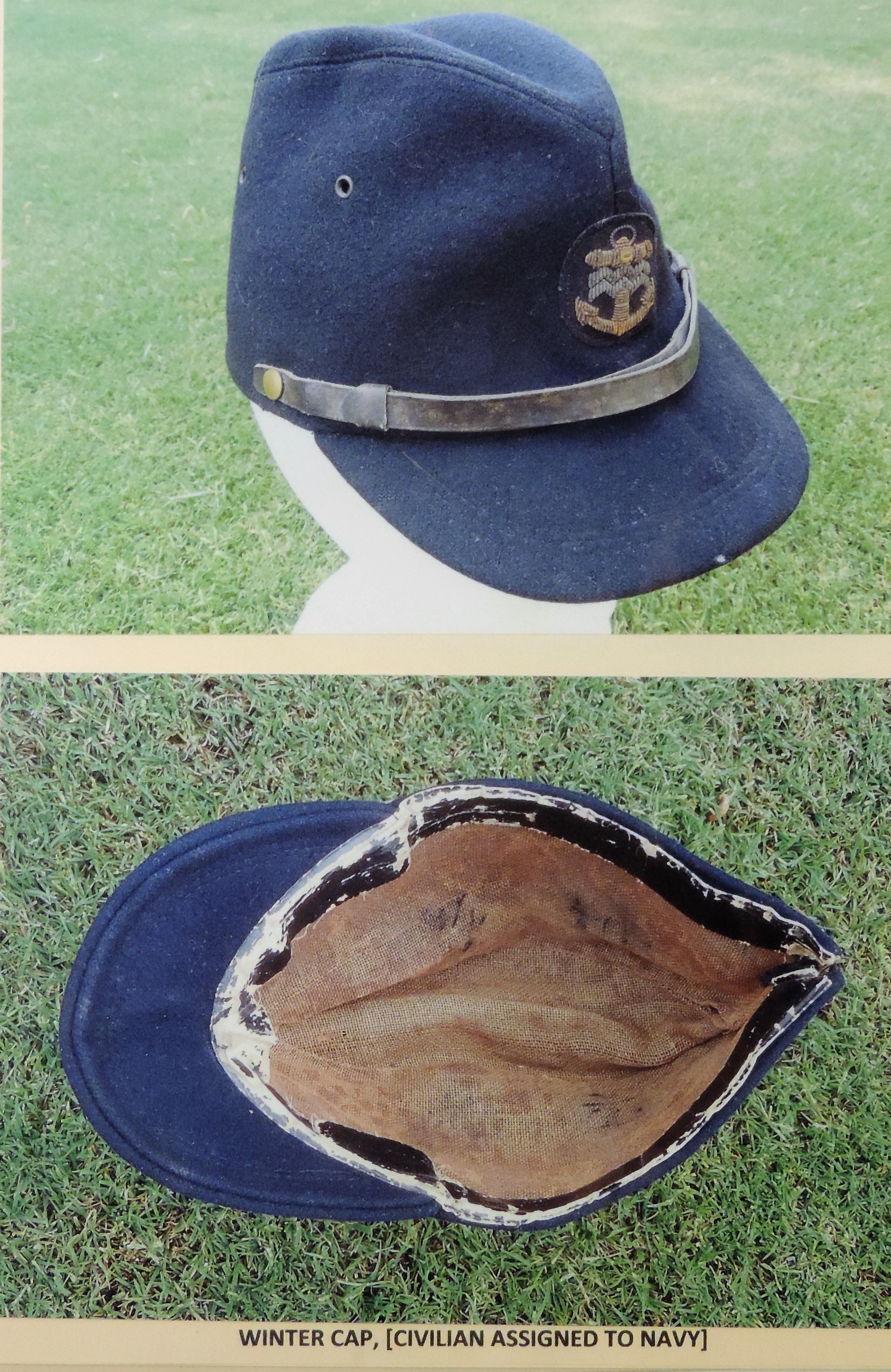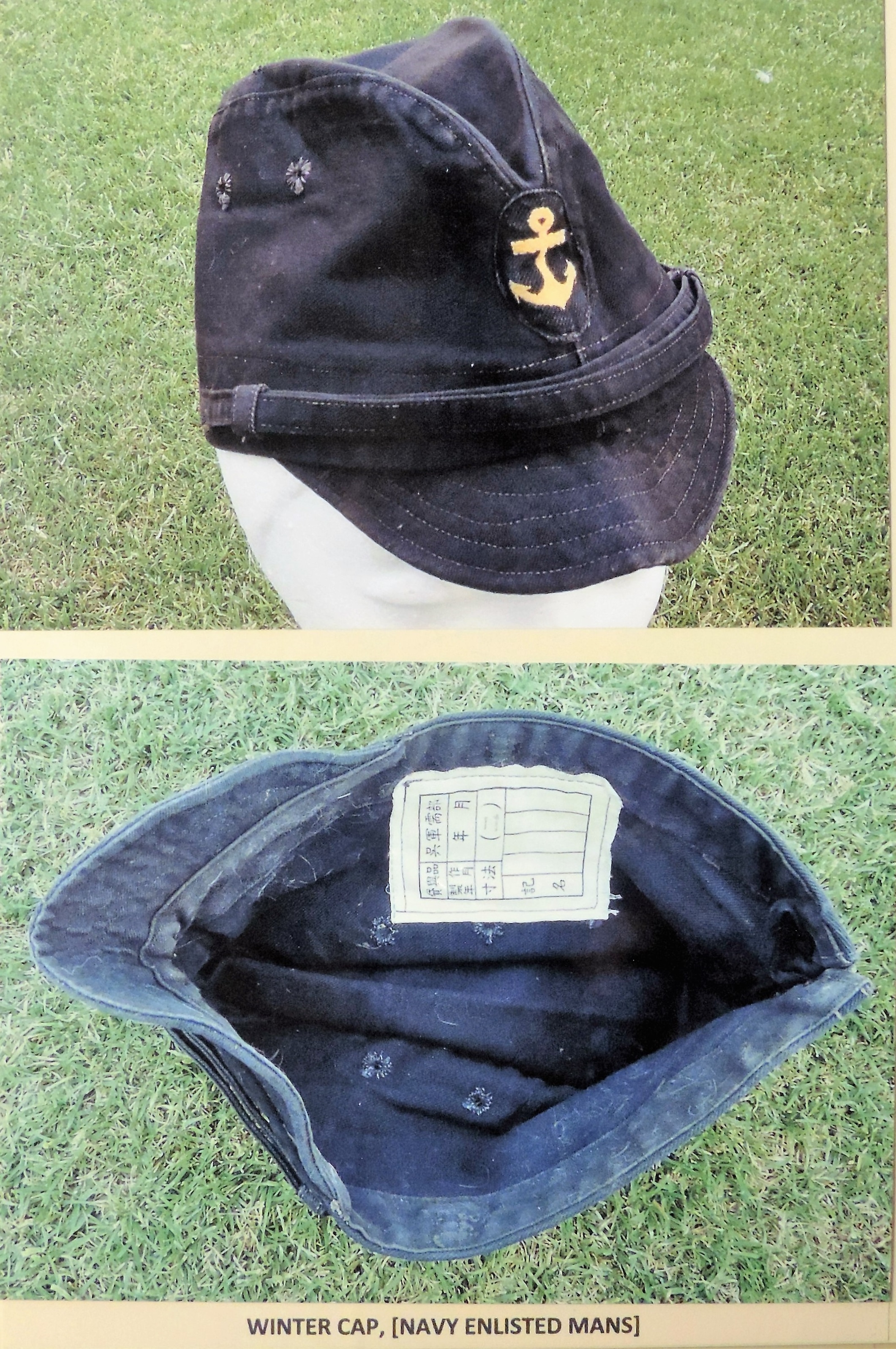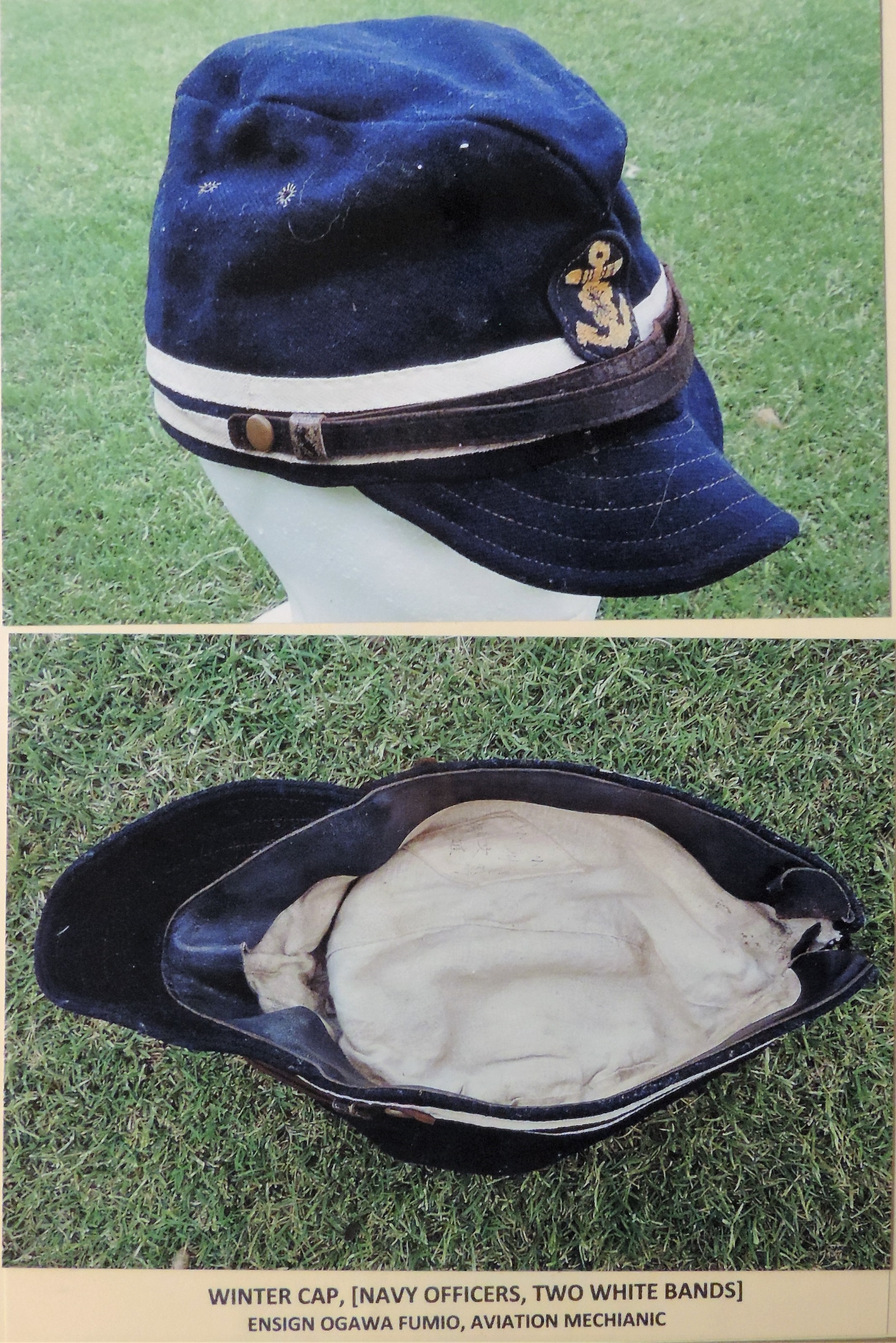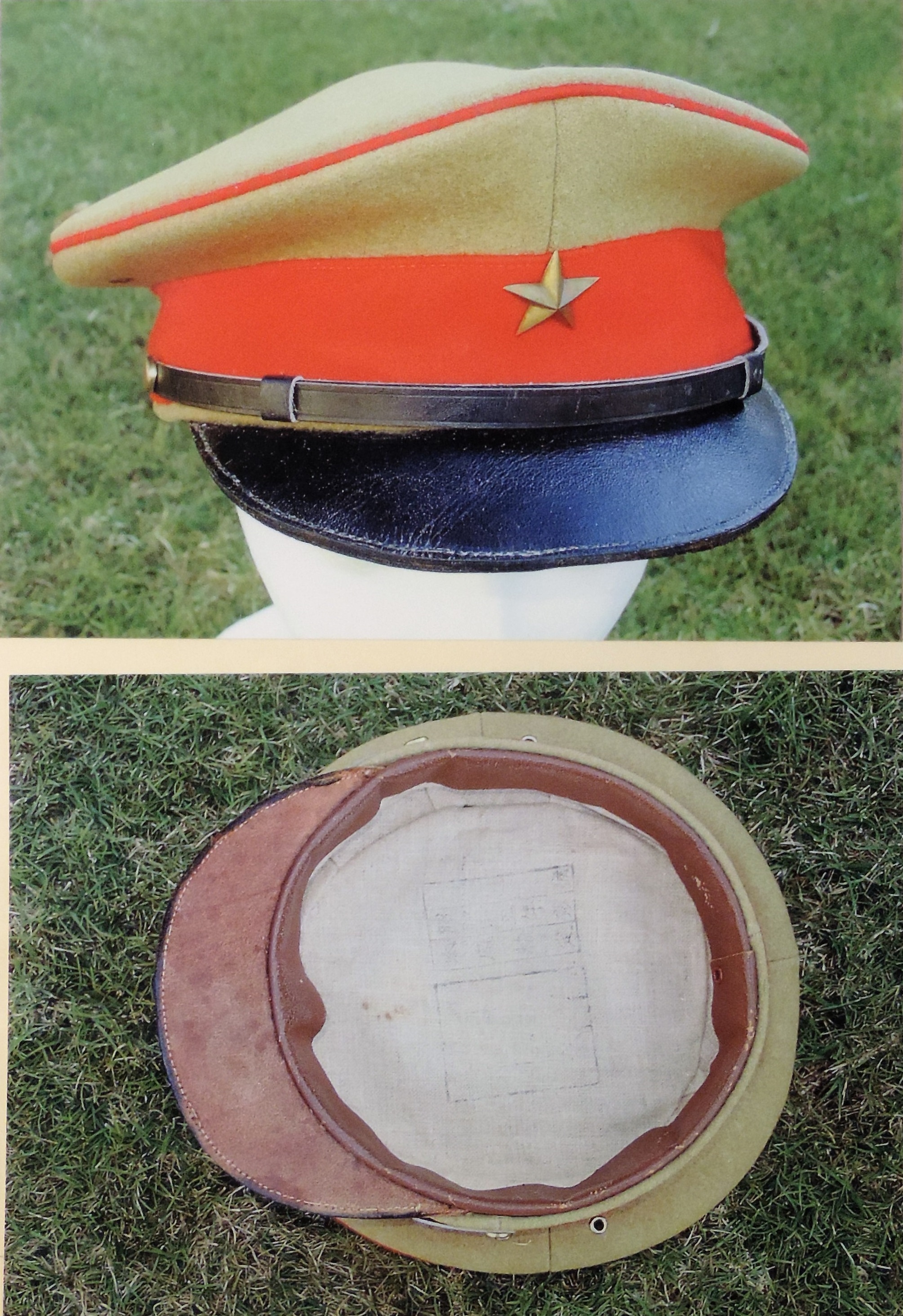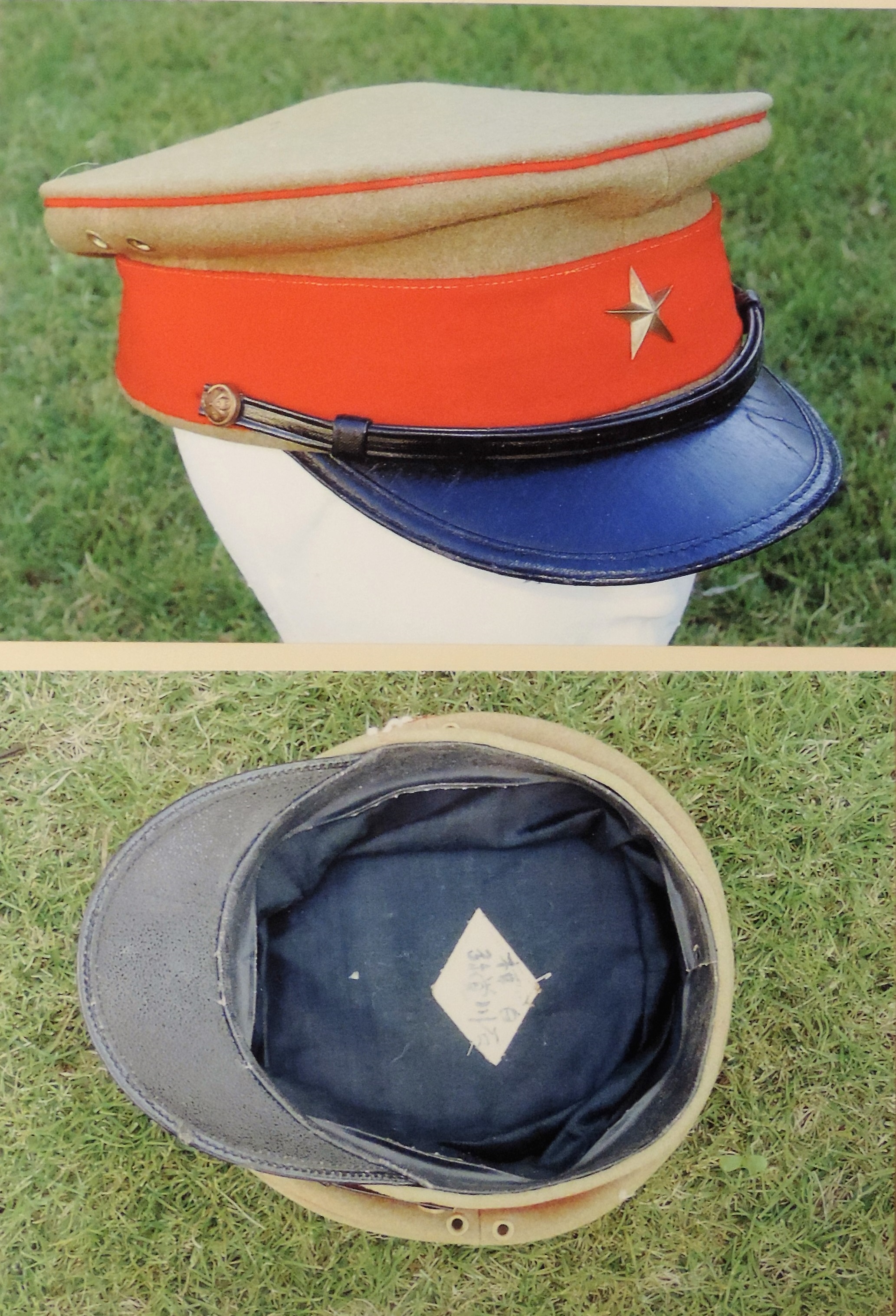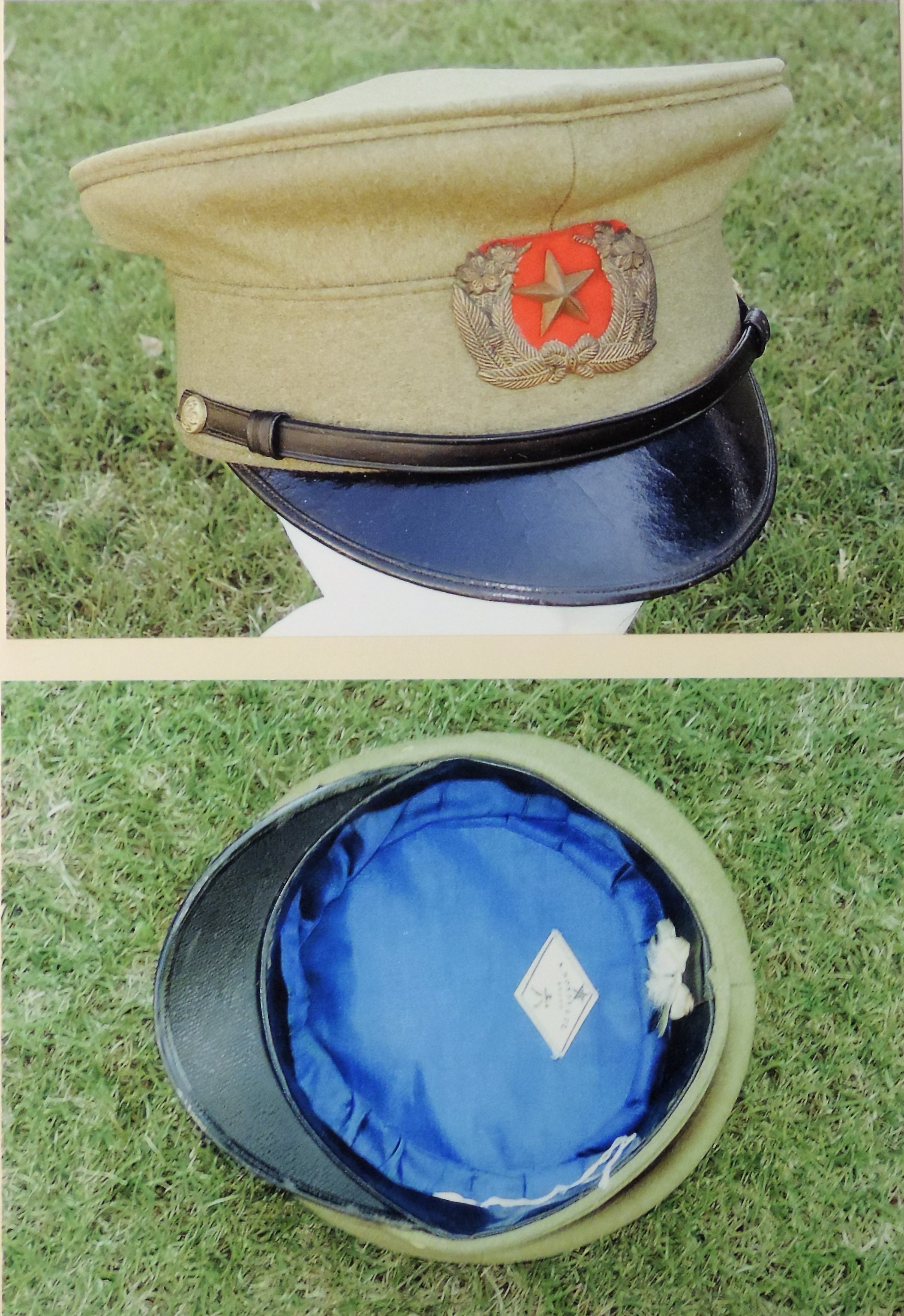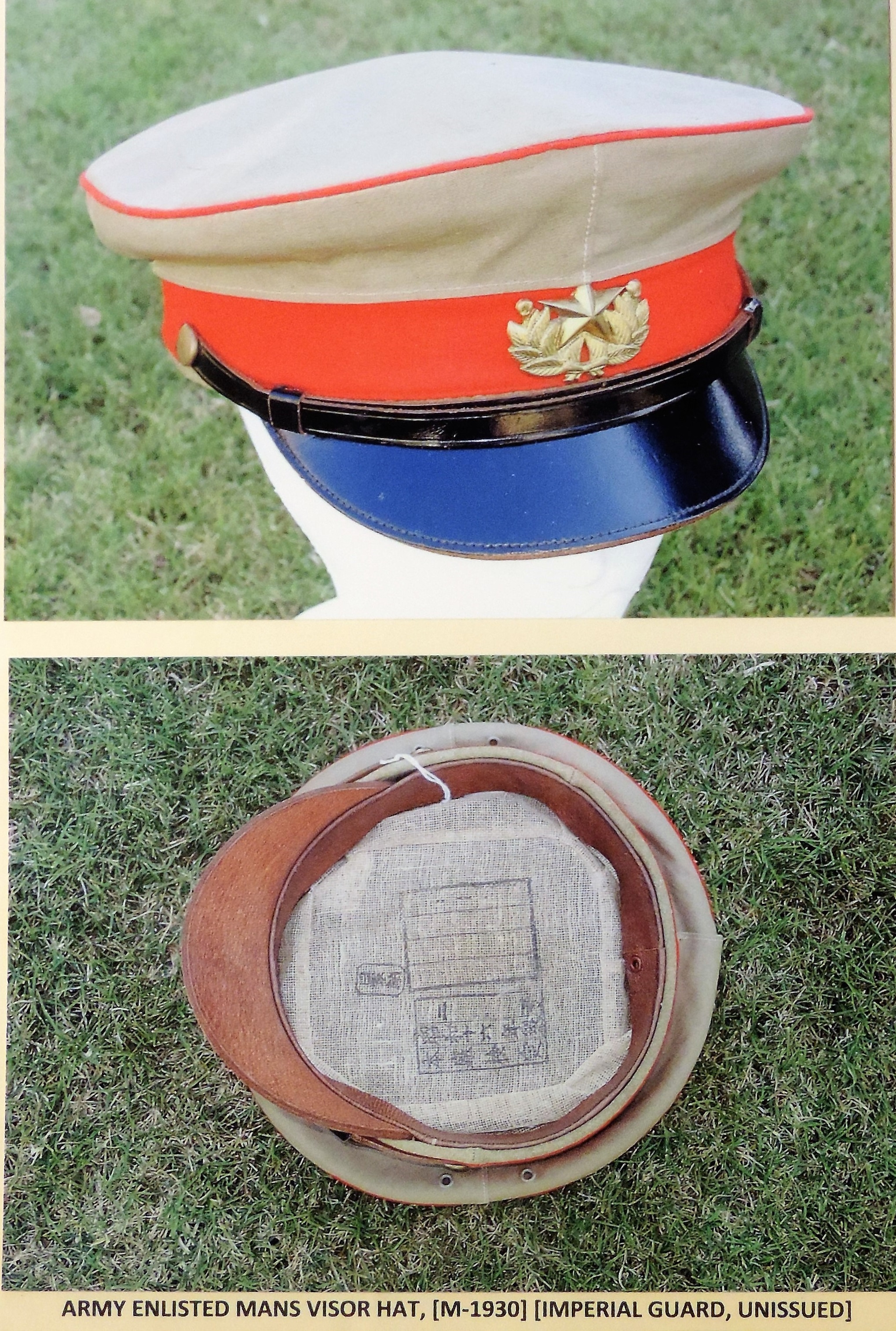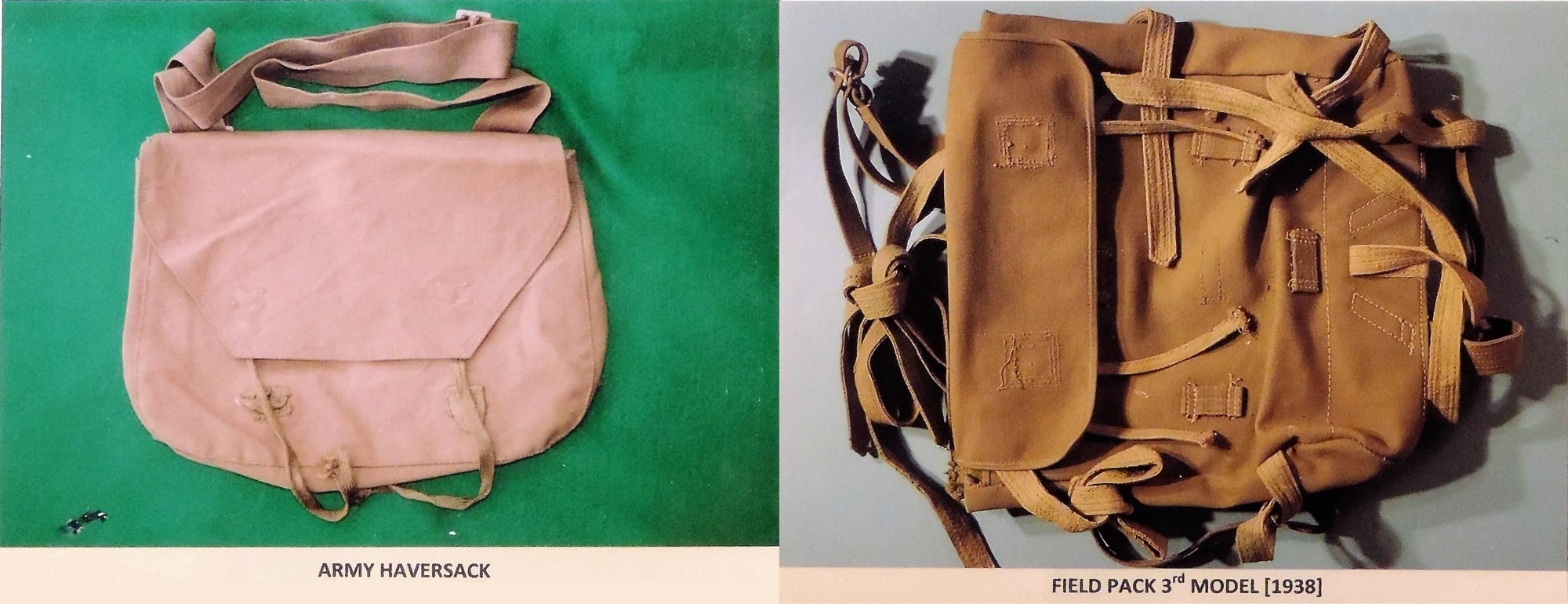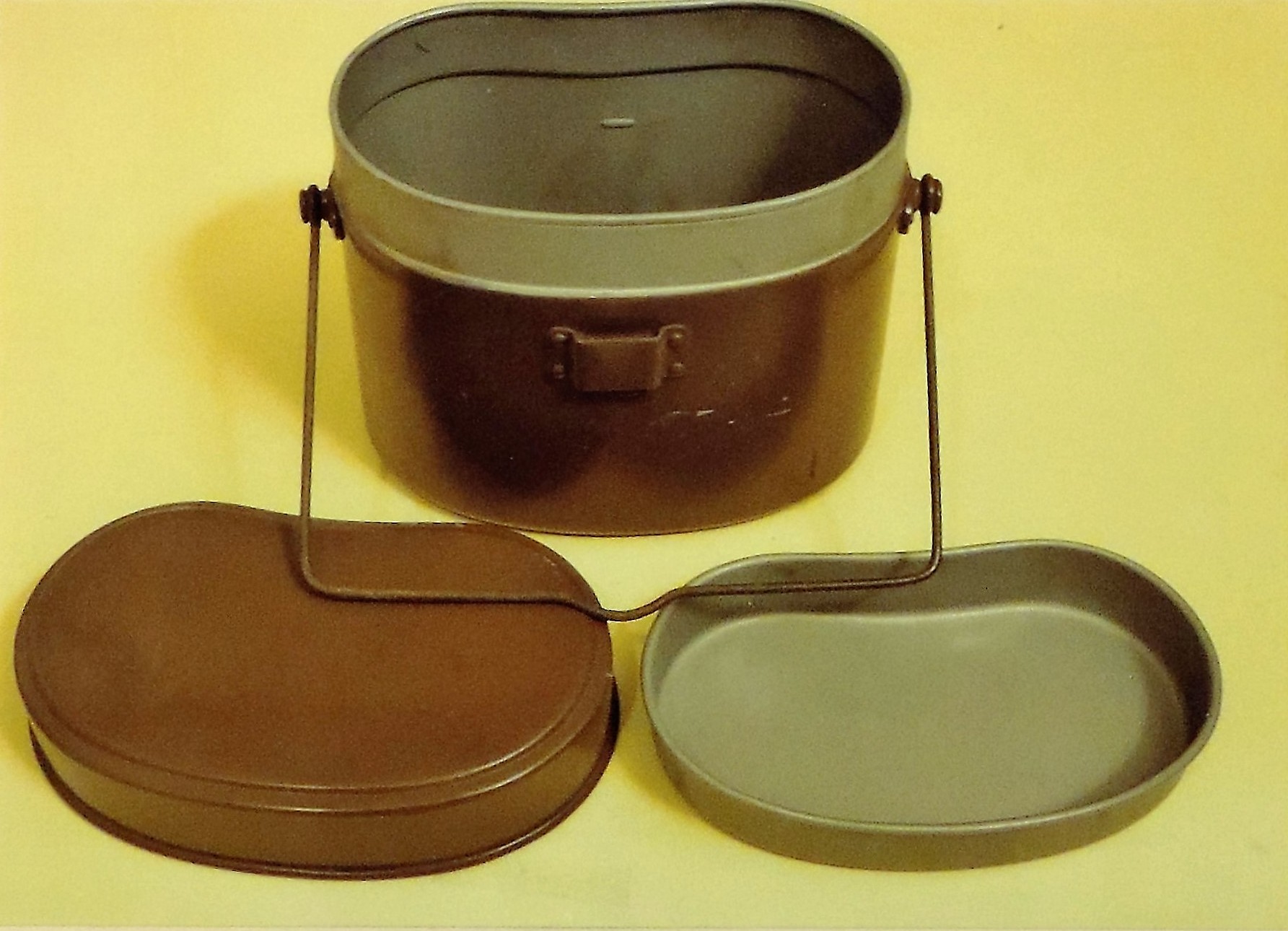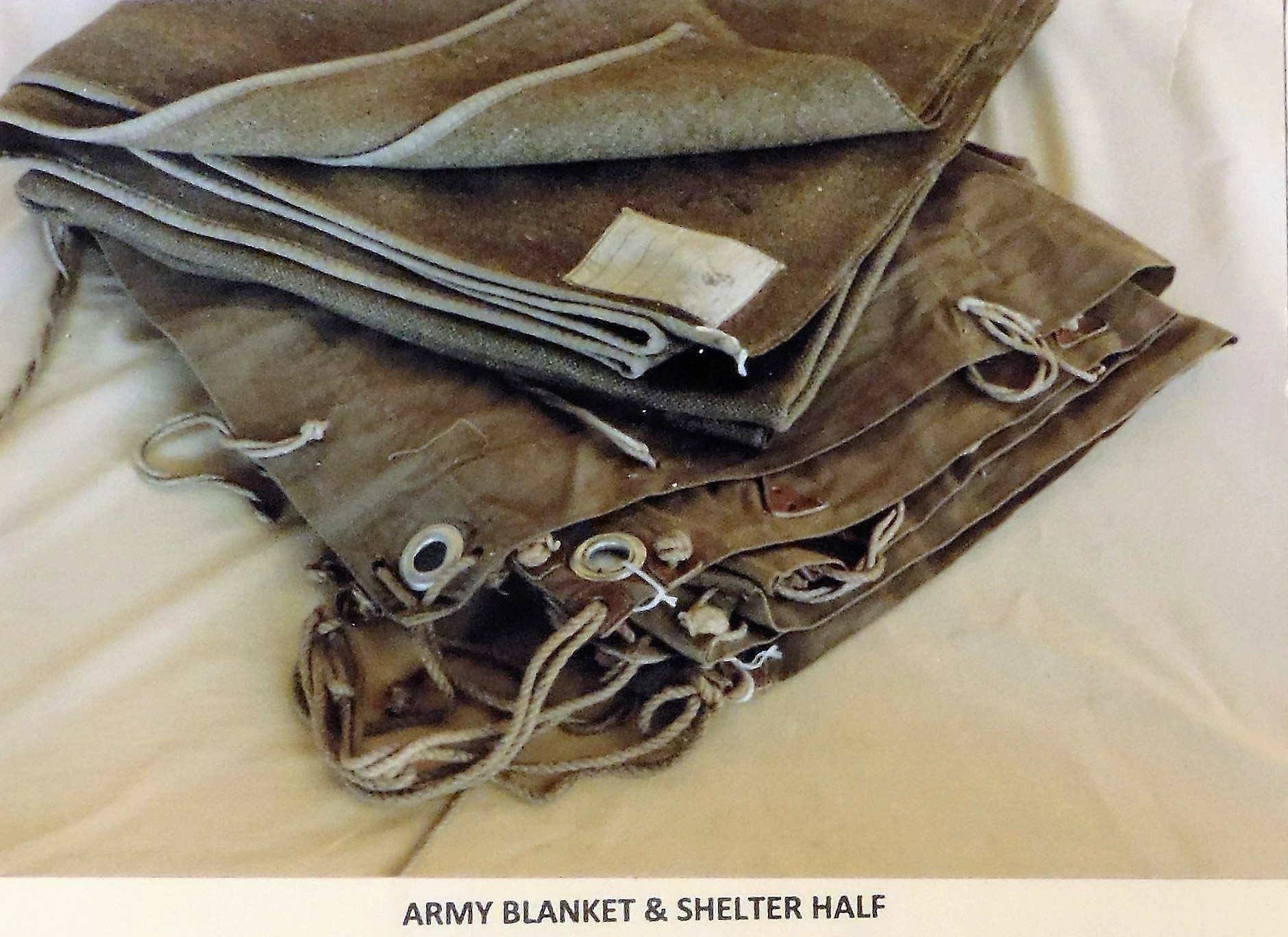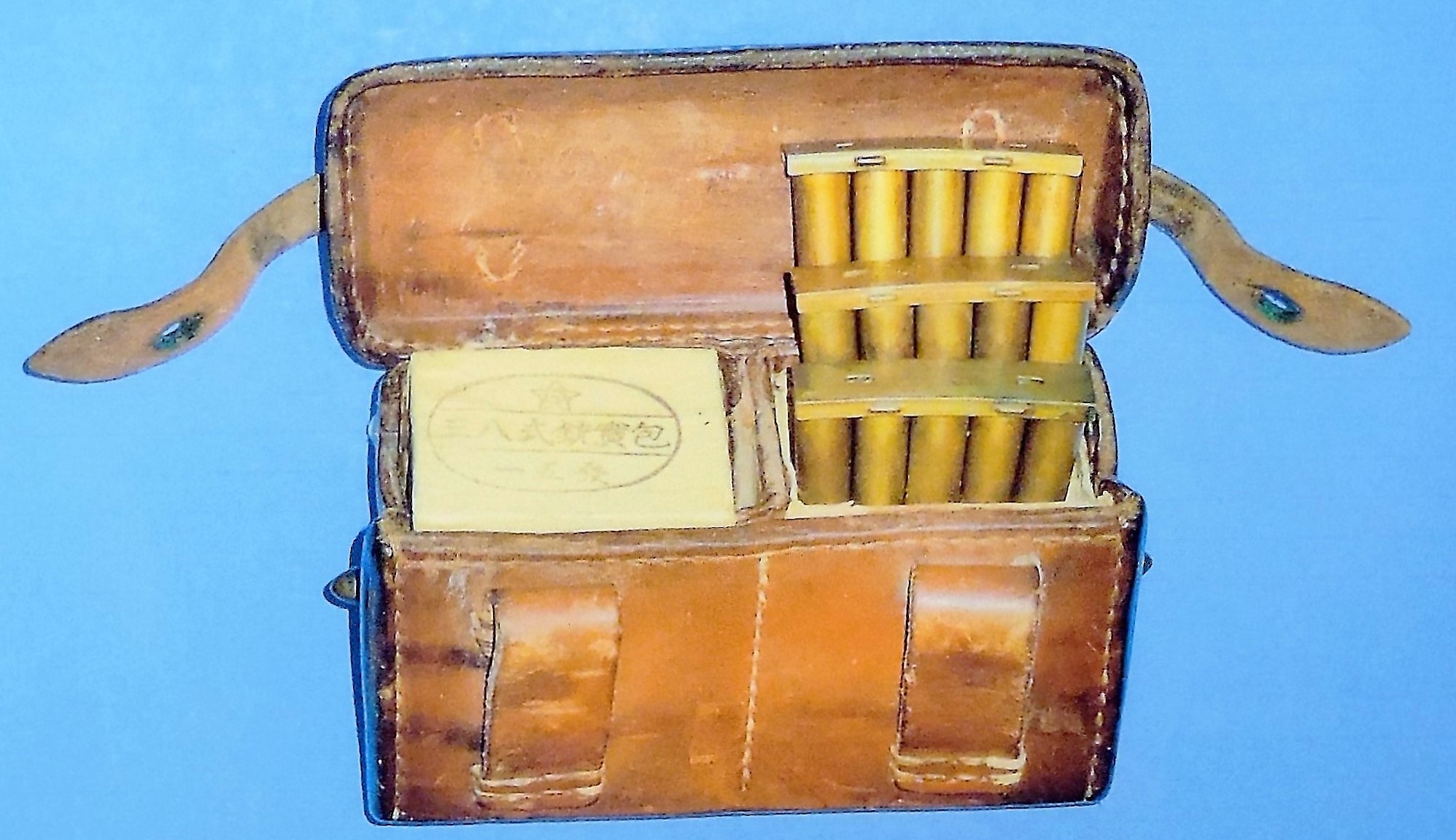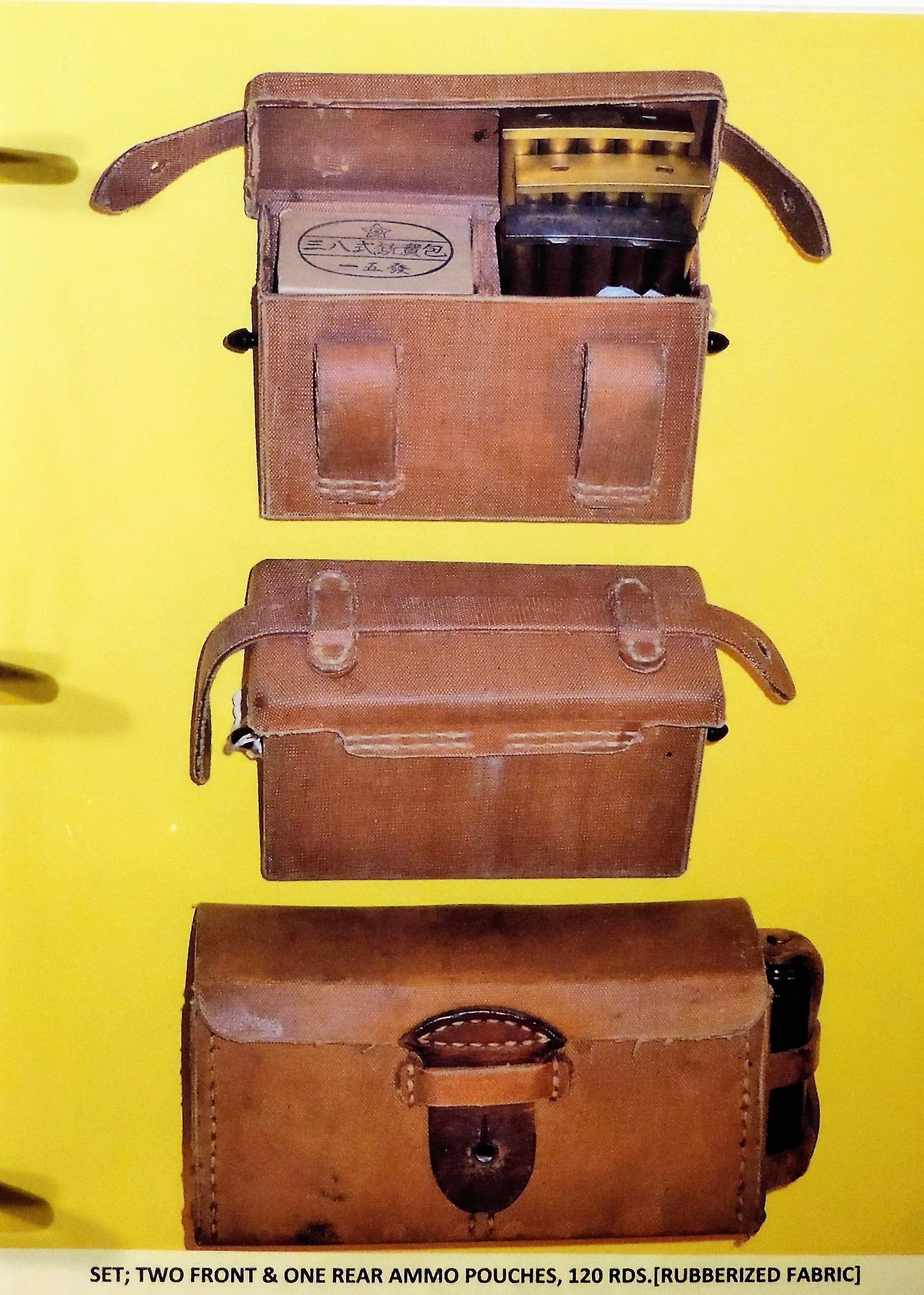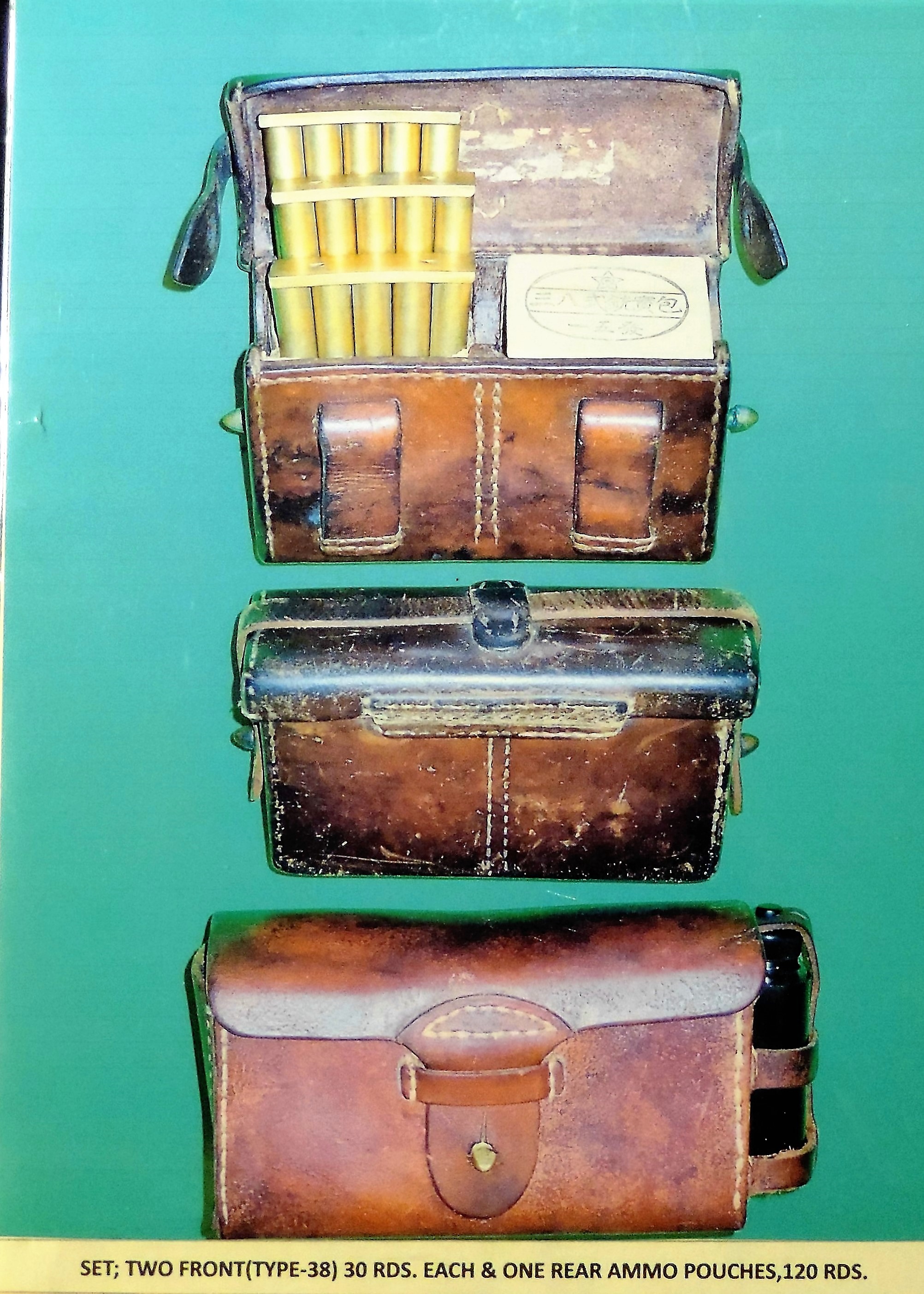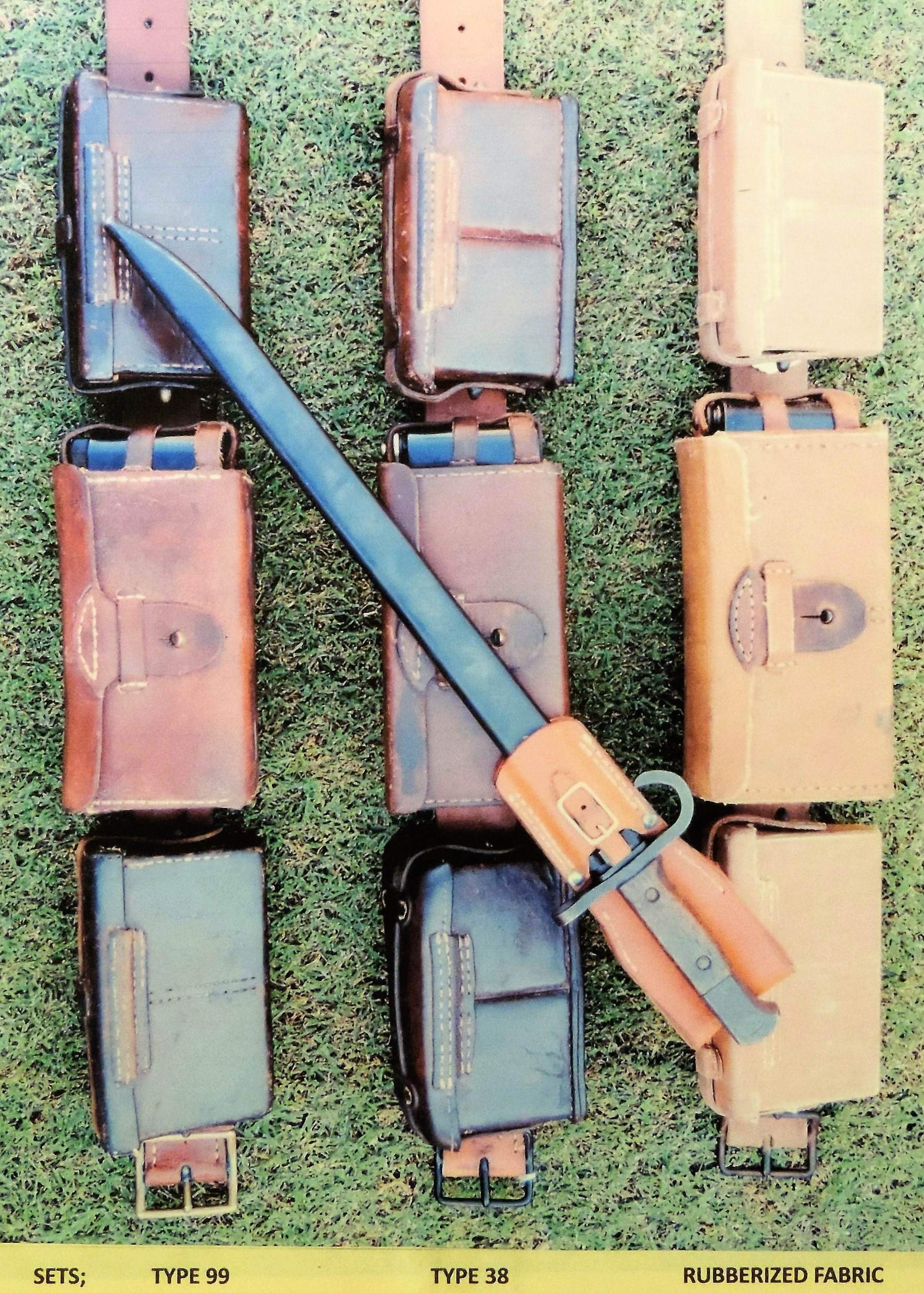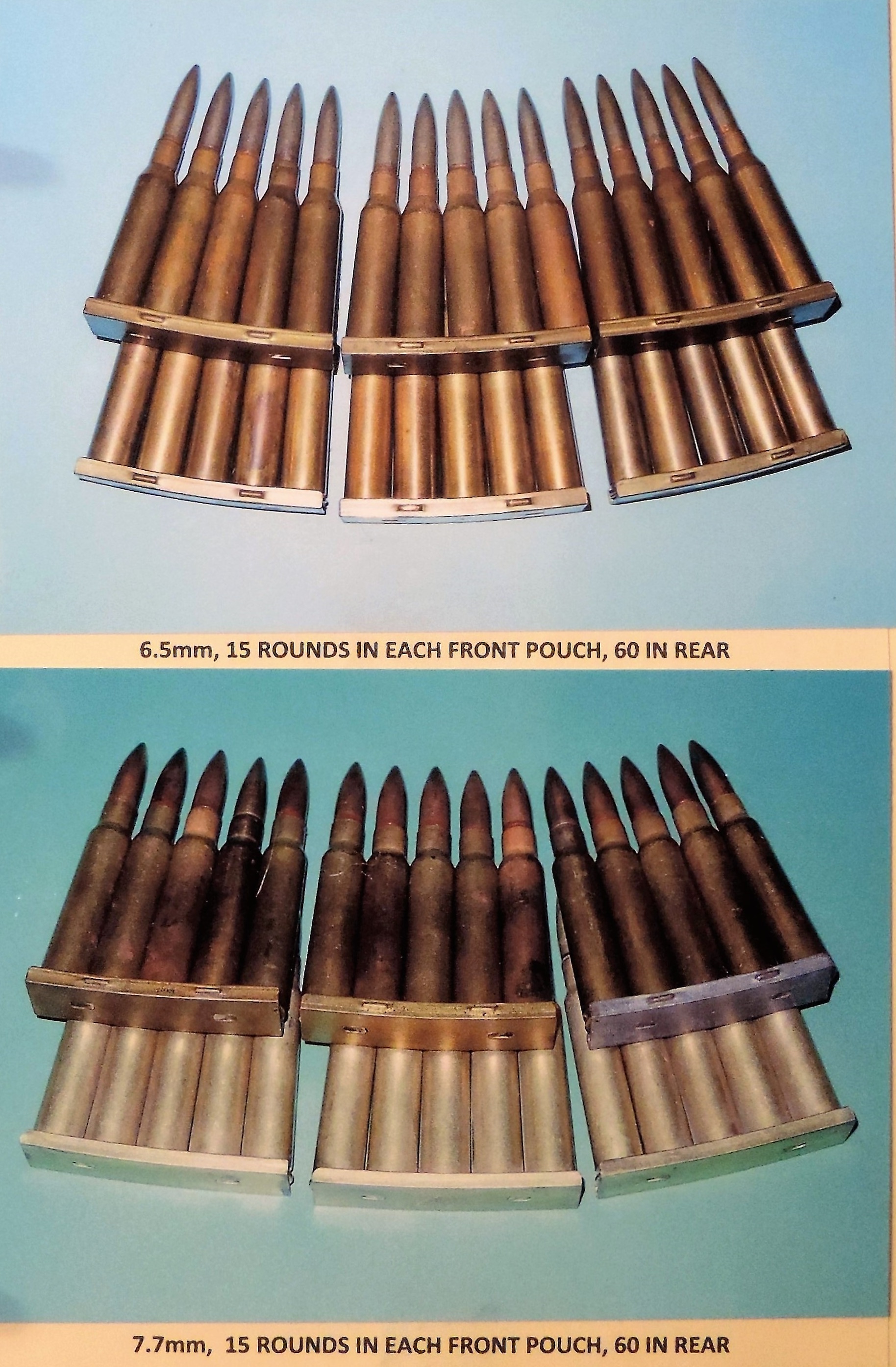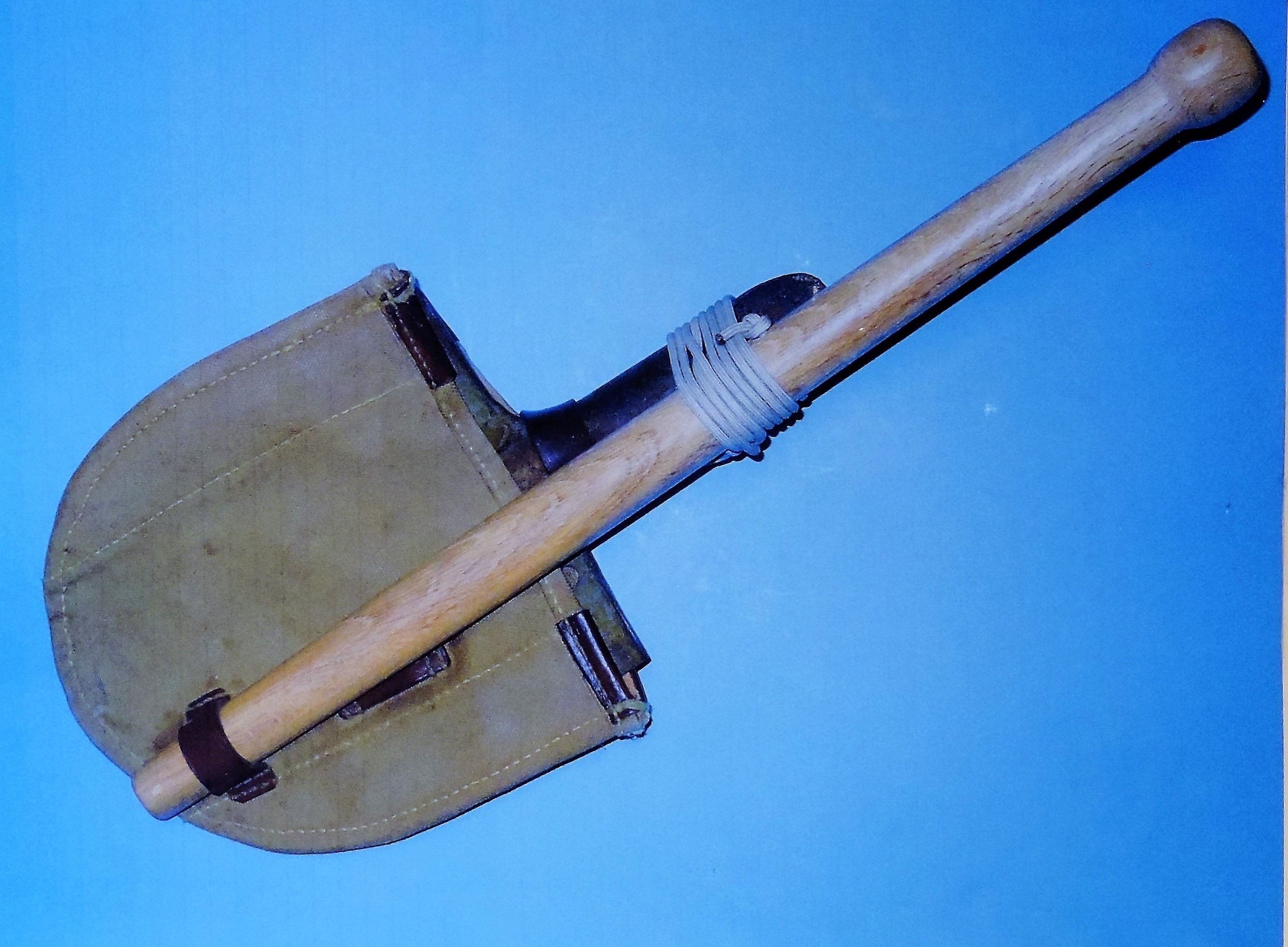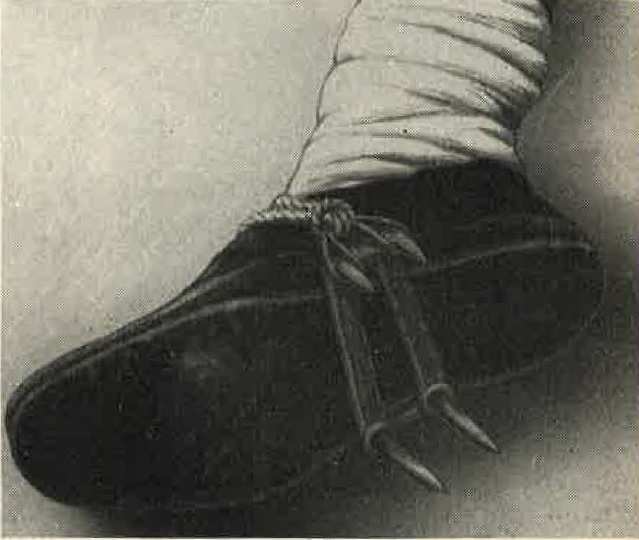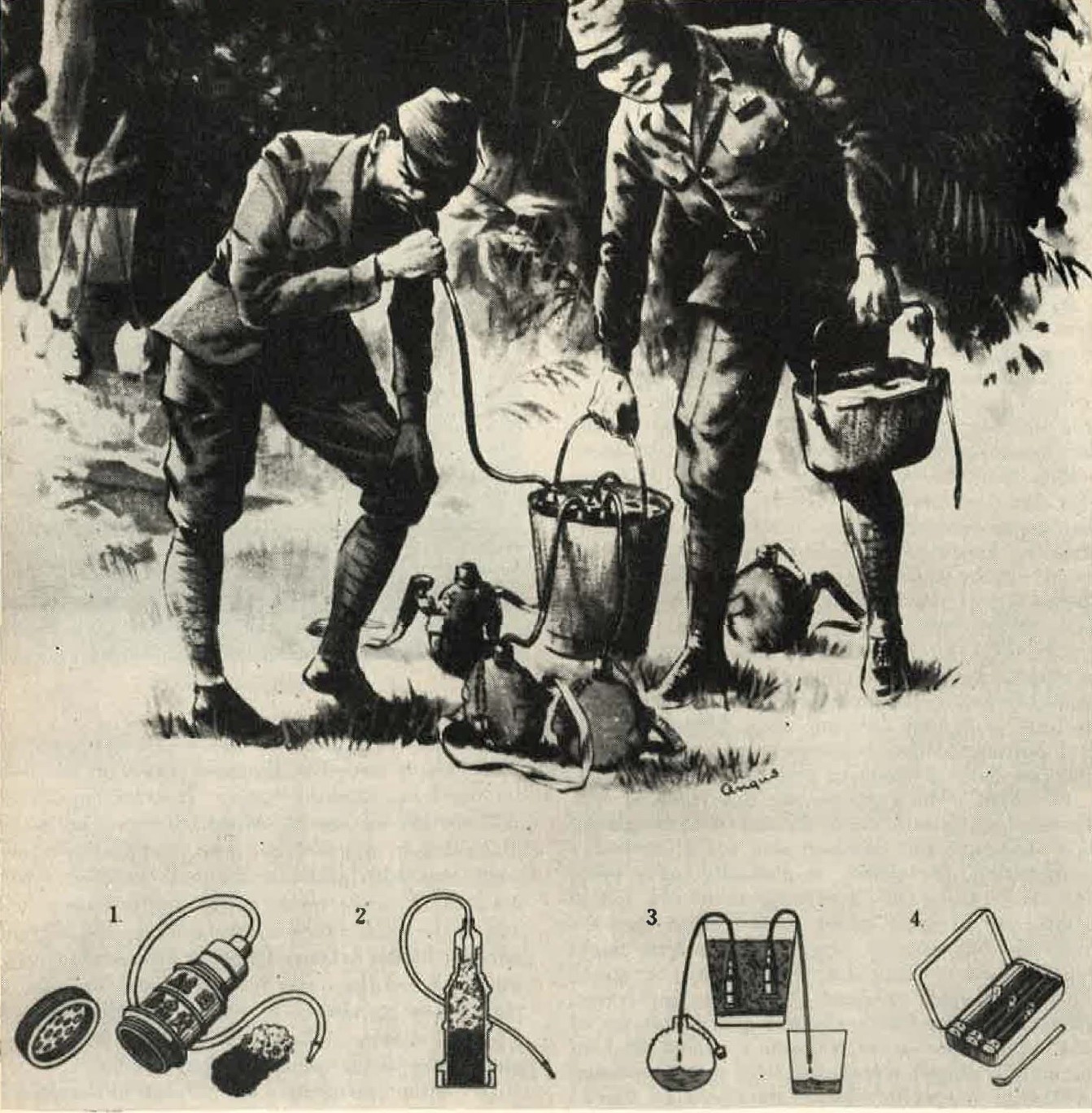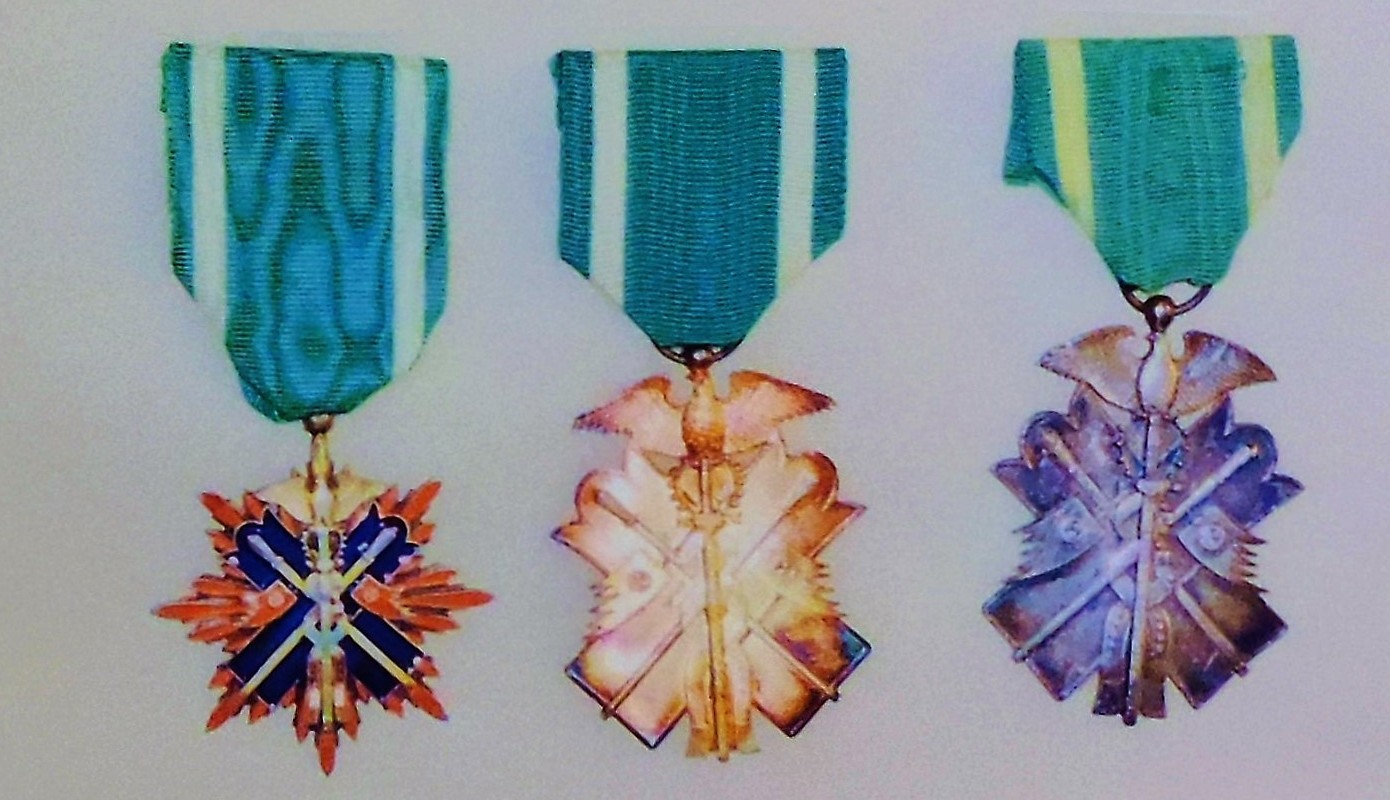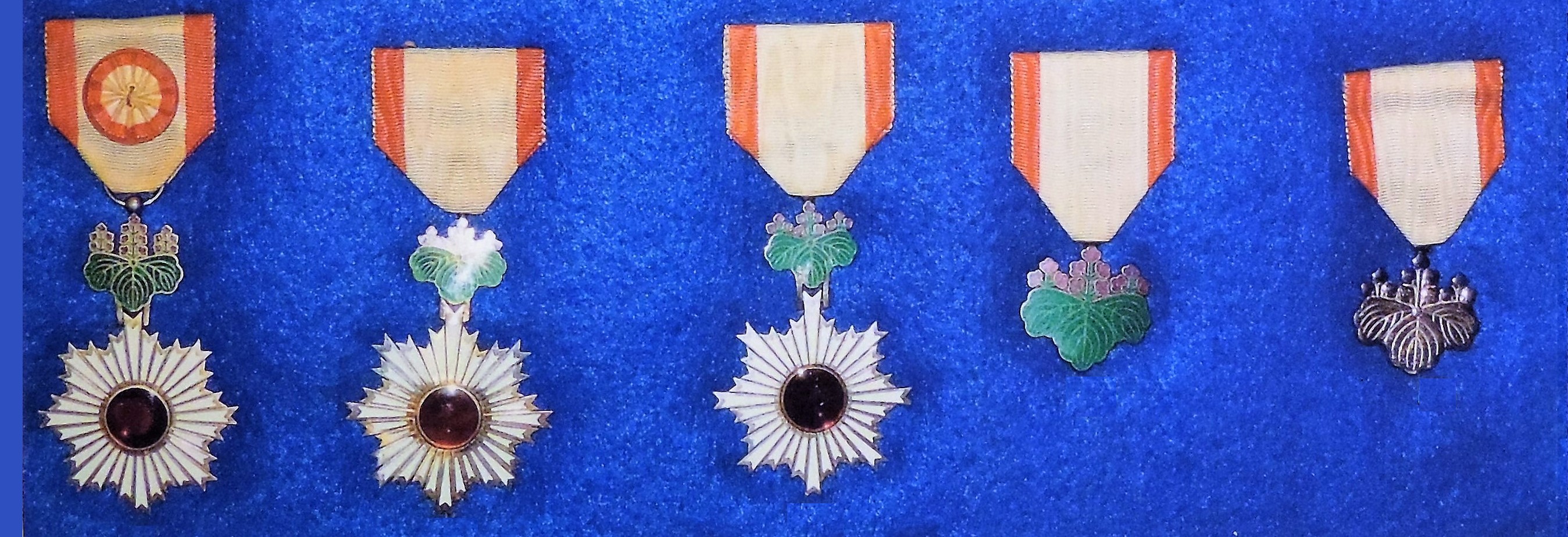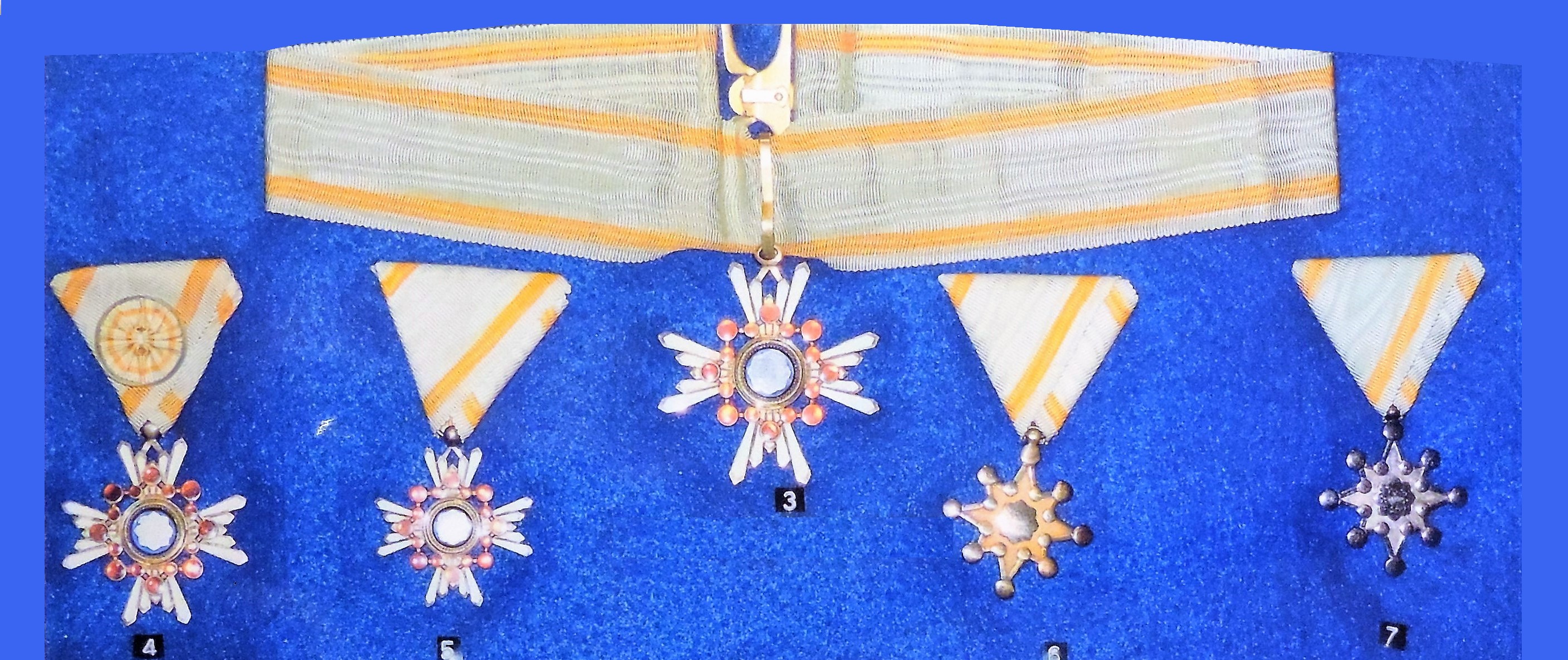CHAPTER 11 - UNIFORMS, PERSONAL EQUIPMENT AND INSIGNIA

1. WWII JAPANESE MILITARY STANDARD UNIFORMS.
a. Types.
Aside from obsolete sundress and special officer summer dress uniforms, there are 2 distinct types of regular Japanese uniforms used in temperate regions: the model 90 (1930) and the model 98 (1938). Both types have woolen winter and cotton summer versions. There are no government issue officer's uniforms; therefore, even within each type, these vary considerably from each other in cut, color, and material. Various types of ]apanese uniforms together with jtems of personal equipment, are illustrated in figures 409 and plates I - VIII.
b. The WWII Japanese M-1930 coat.
The older typ M-1930 uniform is still worn by some Japanese soldiers, is made of heavy, mustard-colored, woolen cloth. The coat is not unlike the American coat of World War I. It has a high stand-up collar, to which the insignia of arm and unit are attached except when in the field.
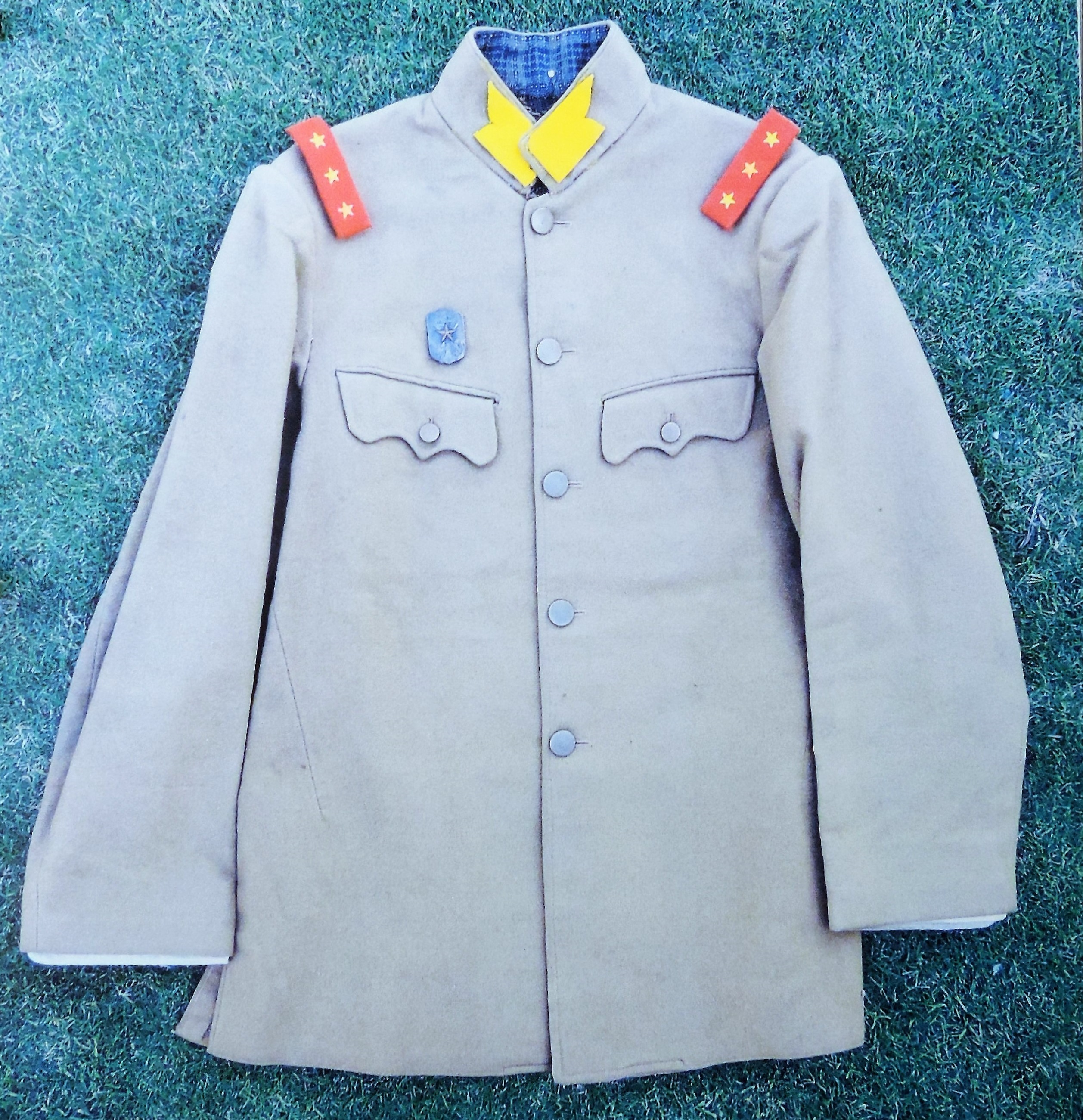
Figure 115. Japanese Army M-1930 artillery superior private tunic. |
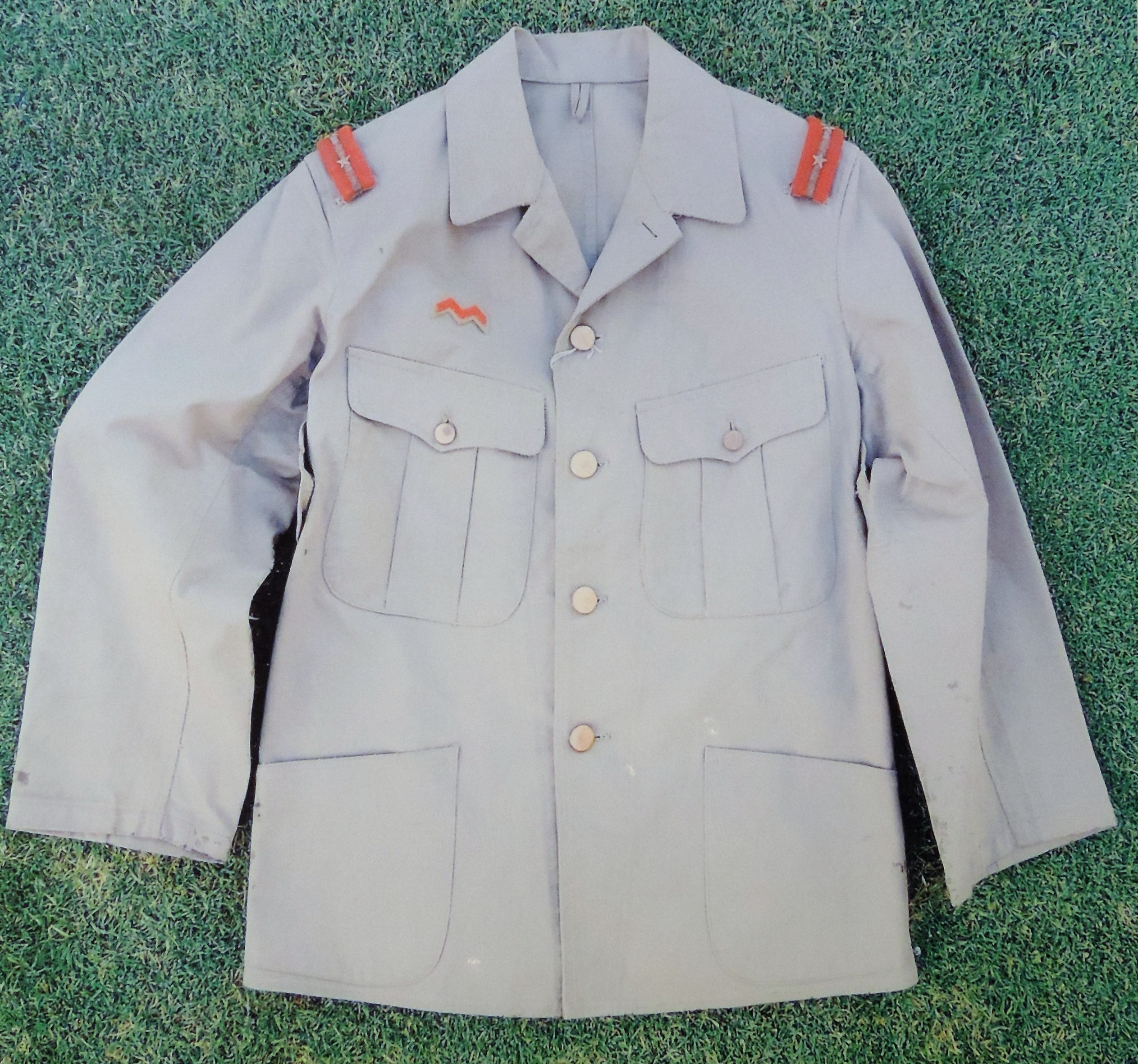
Figure 116. Japanese Army M-1930 infantry sergeant tunic. |
c. The WWII Japanese M-1938 coat
The newer type M-1938 uniform is olive drab in color and is made either of cotton or wool, depending on the season. The coat has a turn-down collar and four pockets with flaps.
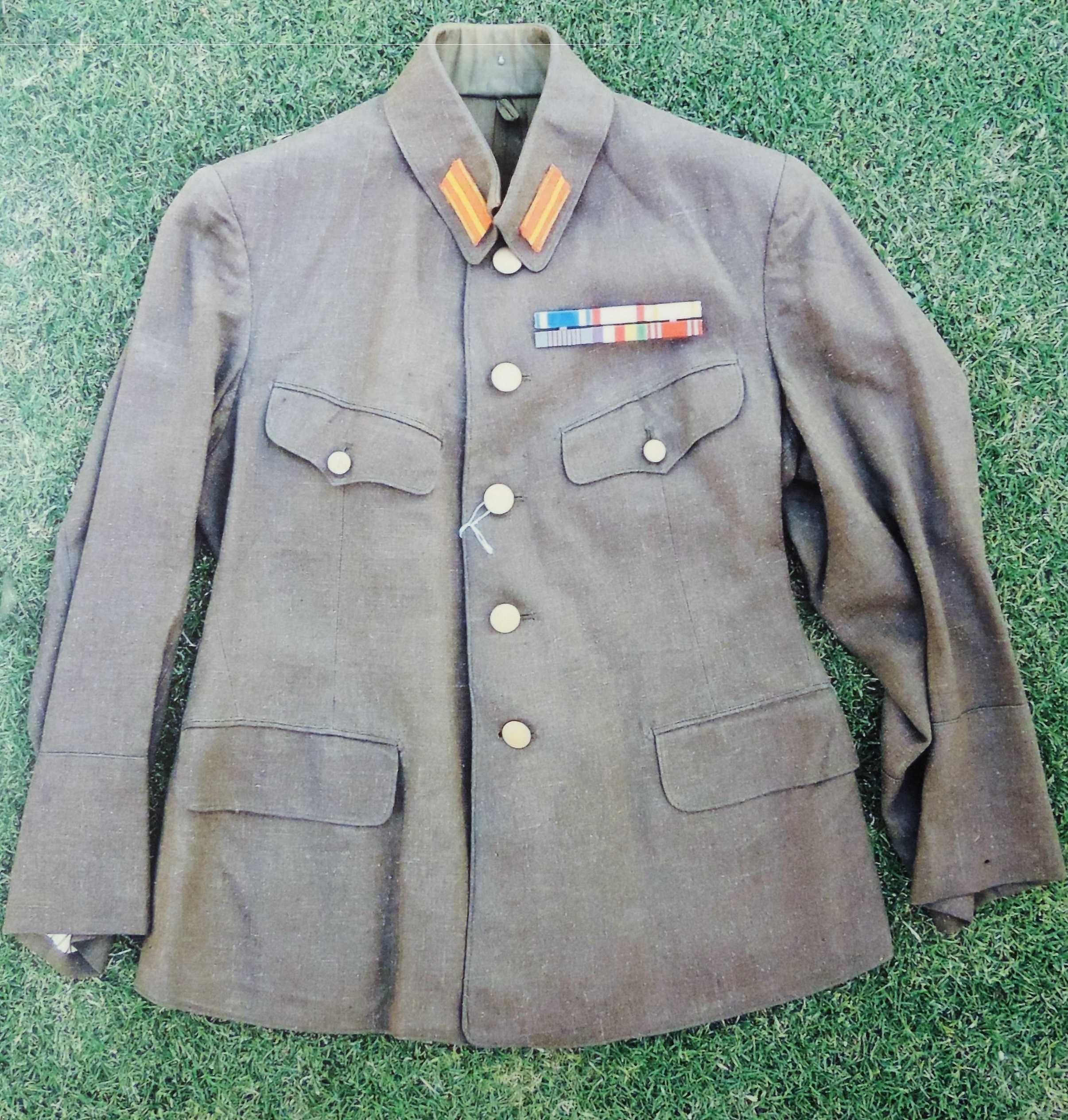
Figure 117. Japanese Army M-1938 artillery warrant officer tunic. |
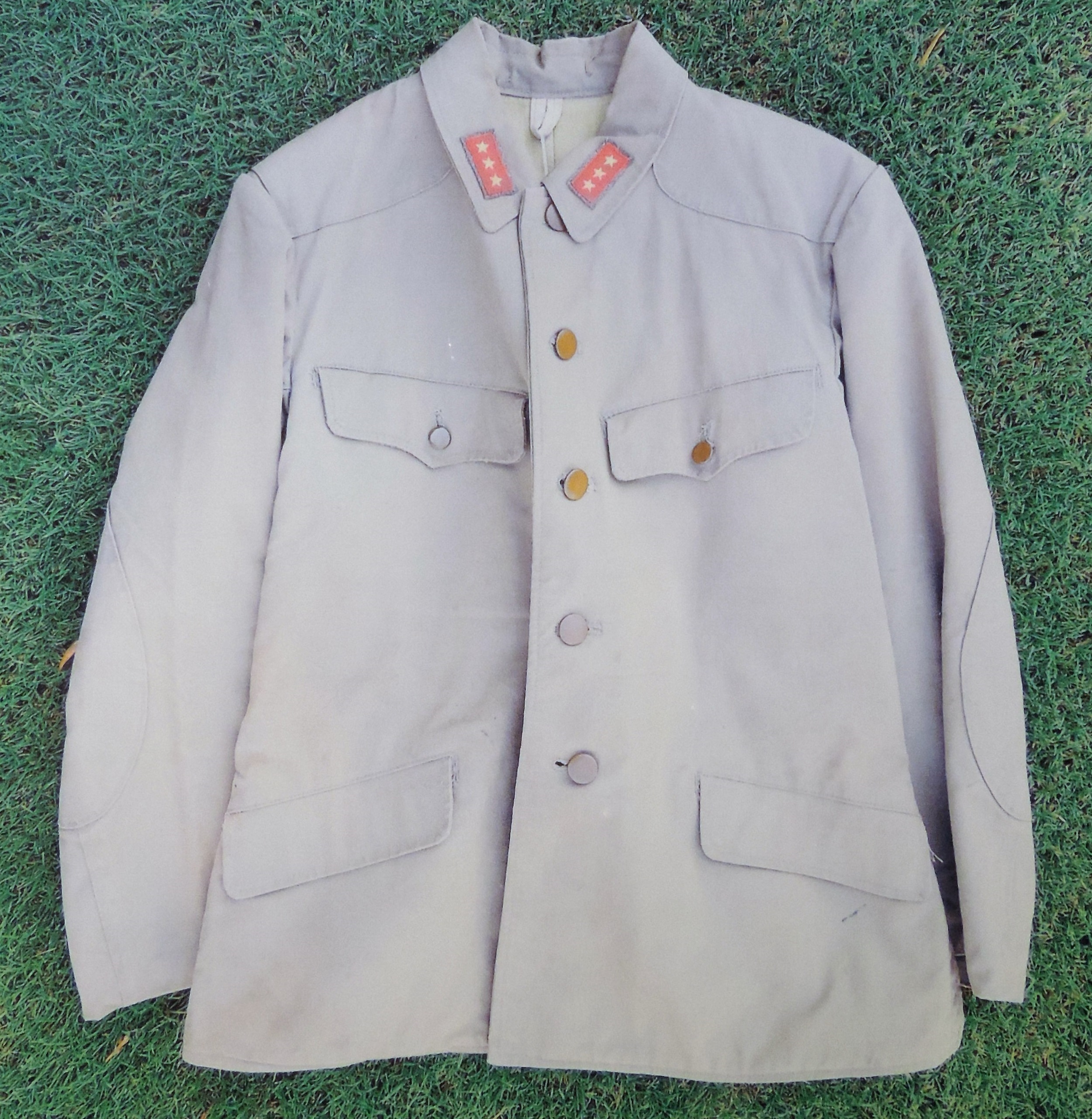
Figure 118. Japanese Army M-1938 tropical superior private tunic. |
d. WWII Japanese Military Trousers.
In the field the Japanese now ordinarily wear semibreeches cut high in the waist and held up by the webbing straps. Wrapped spiral puttees usually are worn by dismounted enlisted men. Officers wear puttees, boots, or leather leggings, with either breeches or semibreeches. Long trousers without cuffs were worn with the M-1930 coat, but were covered with puttees, boots, or leggings in the field.
e. WWII Japanese Military Headgear.
(1) Field cap.
The field cap is made of olive-drab woolen cloth and is generally the shape of the head, with a narrow visor of the same material and a brown leather chin strap. It has a star along the vertical front seam. This cap may be worn under the helmet.
WWII JAPANESE ARMY FIELD CAPS
JAPANESE NAVY FIELD CAPS
(2) Steel helmet.
Steel helmets are generally worn during combat. Webbing tapes tie under the chin or at the back of the neck. The star insignia also are worn on metal helmets. The steel is of inferior quality and the helmets are easily pierced or shattered.

Figure 108. WWII Japanese army helmet. |
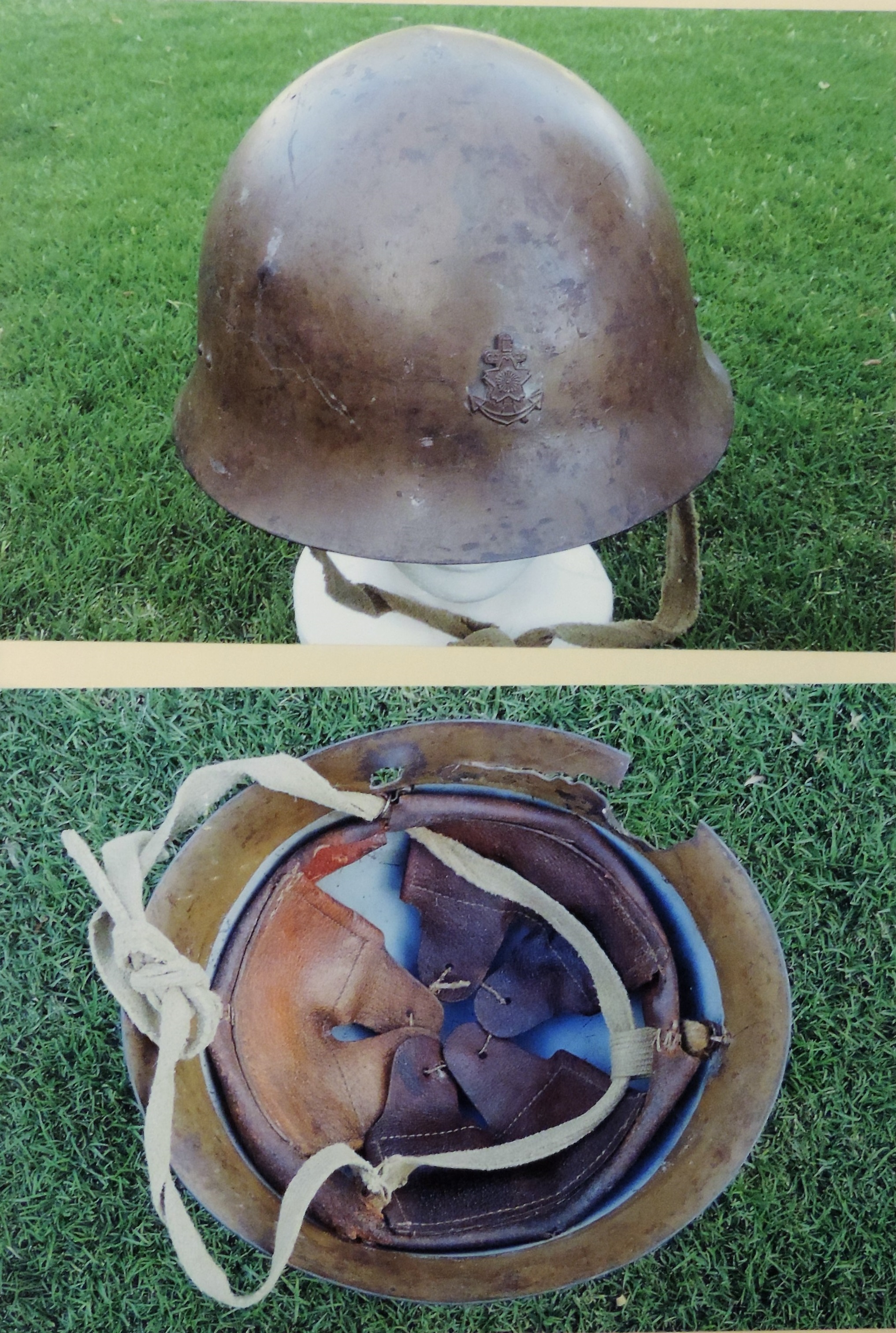
Figure 109. WWII Japanese landing forces helmet. |
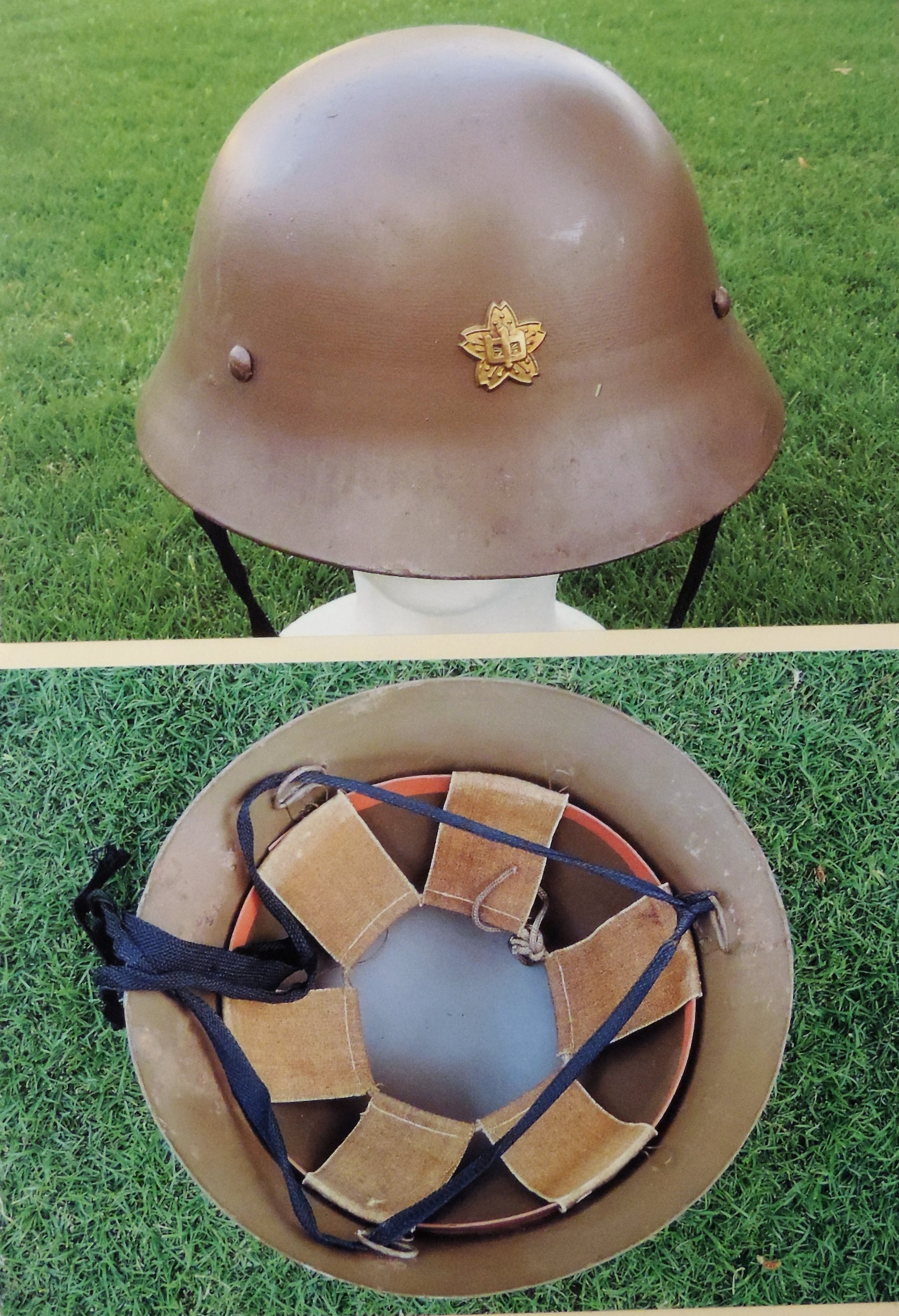
Figure 110. WWII Japanese civil defense helmet. |
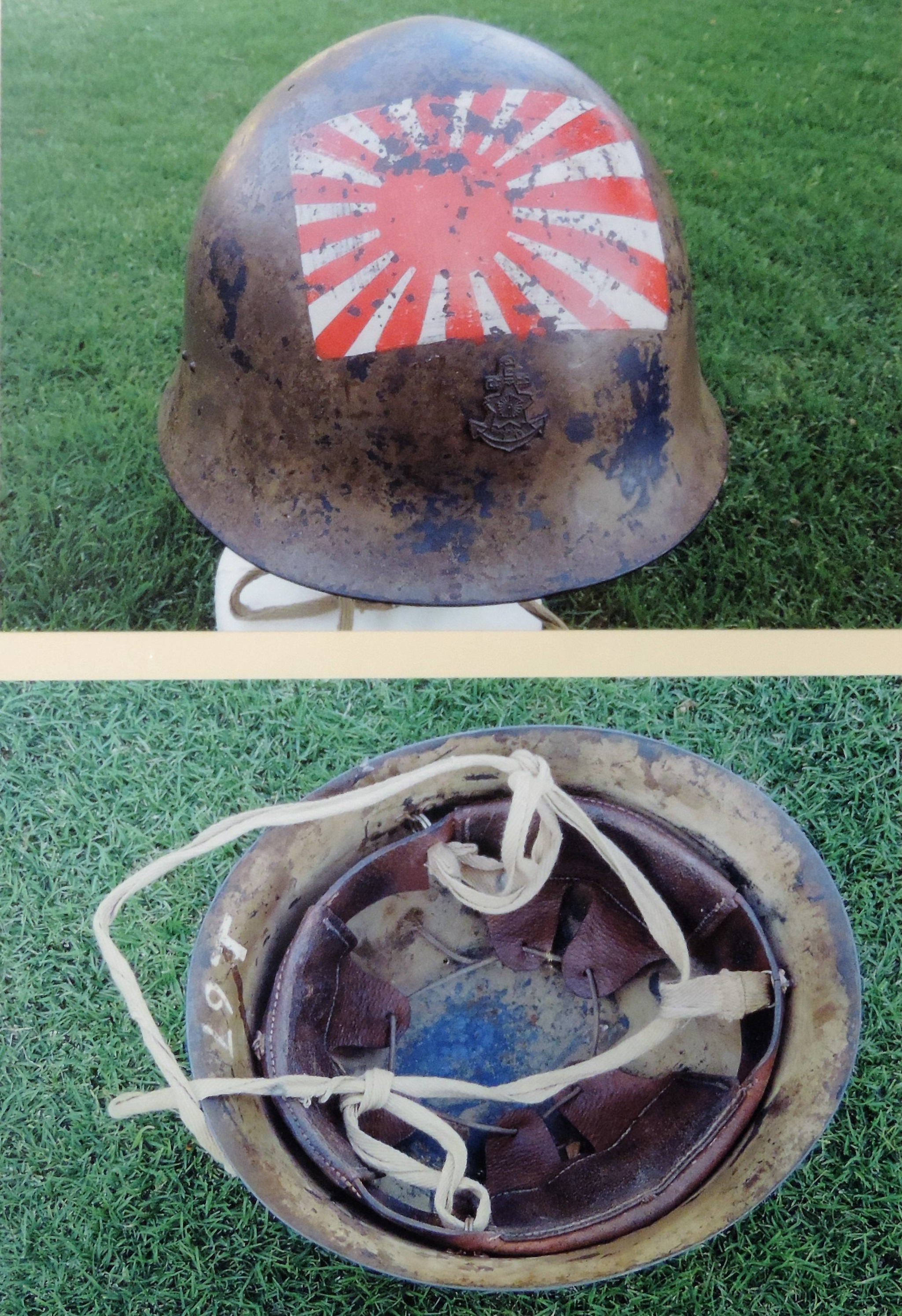
Figure 111. WWII Japanese landing forces painted helmet. |
(3) WWII Japanese military service cap.
The service cap is olive drab in color and similar in shape to that of the United States Army, but it has a smaller crown and shorter visor. A red piping is inserted at the outer edge of the crown and the headband is encircled with a strip of red felt about 1 ½ inches wide. At the front of the headband is a gold star. For officers and men of the Imperial Guards a semicircular wreath of leaves is fastened just below the star. The visor and chin strap are of black leather in standard military design.
JAPANESE ARMY SERVICE CAPS
f. WWII Japanese military footgear.
The dismounted enlisted man wears russet service shoes of pigskin or cowhide. The shoes are hobnailed and have a metal rimmed heel. Men of the mounted services wear russet riding boots or leather leggings and shoes. Officers boots and shoes are similar in design, but are usually black. Rubber soled black canvas tabi often are carried as a second pair of shoes, especially in warm weather. Most, although not all, tabi have split toes which serve uo special ptll'pose but are characteristic of many Japanese shoes. The soles have ridge-like, cleats under the ball of the foot for better traction. Japanese socks are typically heelless. Both woolen and cotton socks are used.

Figure 112. WWII Japanese cavalry boots with spurs. |

Figure 113. WWII Japanese taby and army quarter boots. |
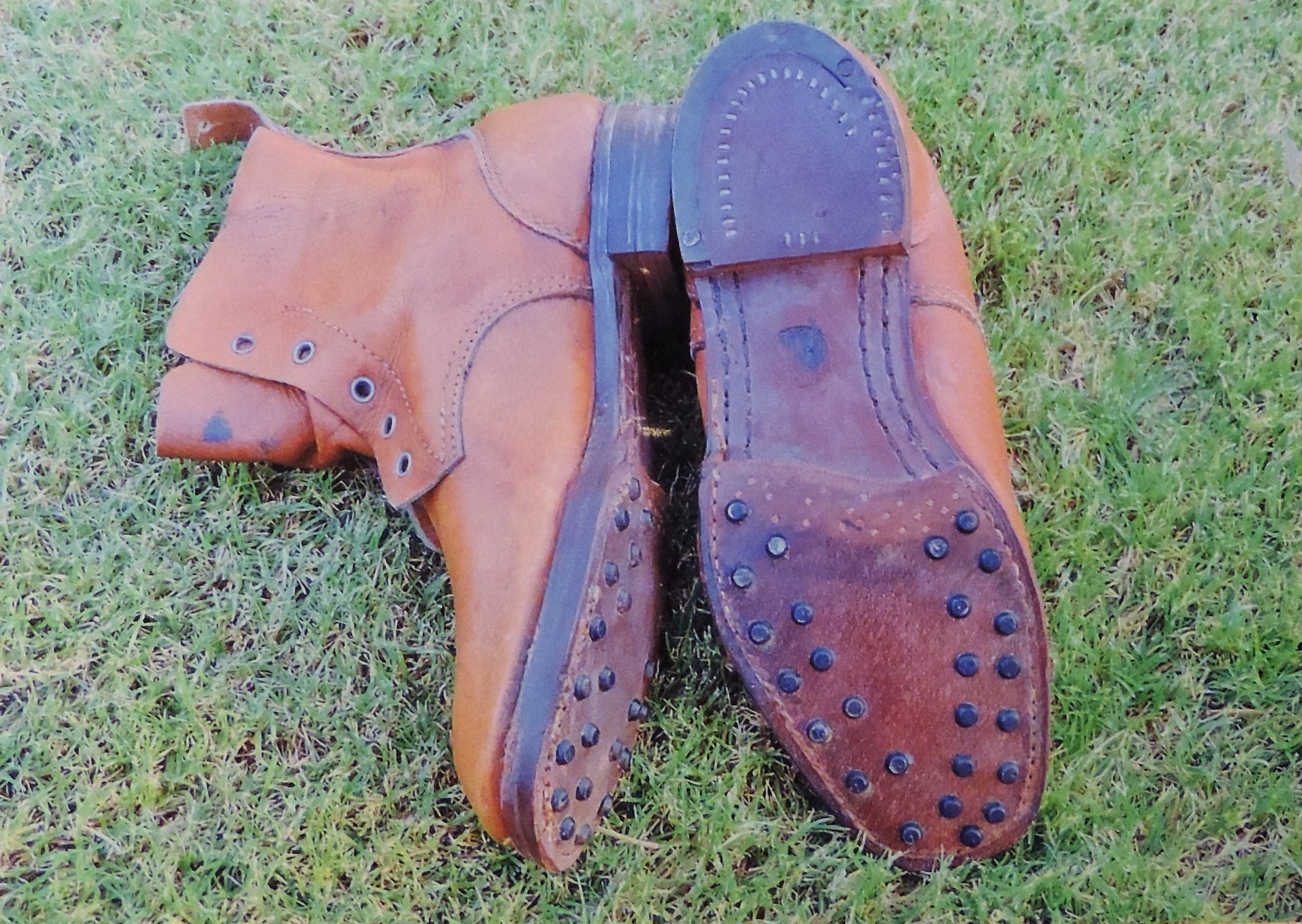
Figure 114. WWII Japanese army quarter boots hobnail soles. |
g. WWII Japanese Military Overcoat and cape.
The M-1938 overcoat for enlisted men is made of olive drab woolen material. It is single breasted and has a turn-down collar. For marching the lower corners of the coat buttons back behind the side pockets. Equipment is worn outside over the coat. An older type of overcoat is double breasted.
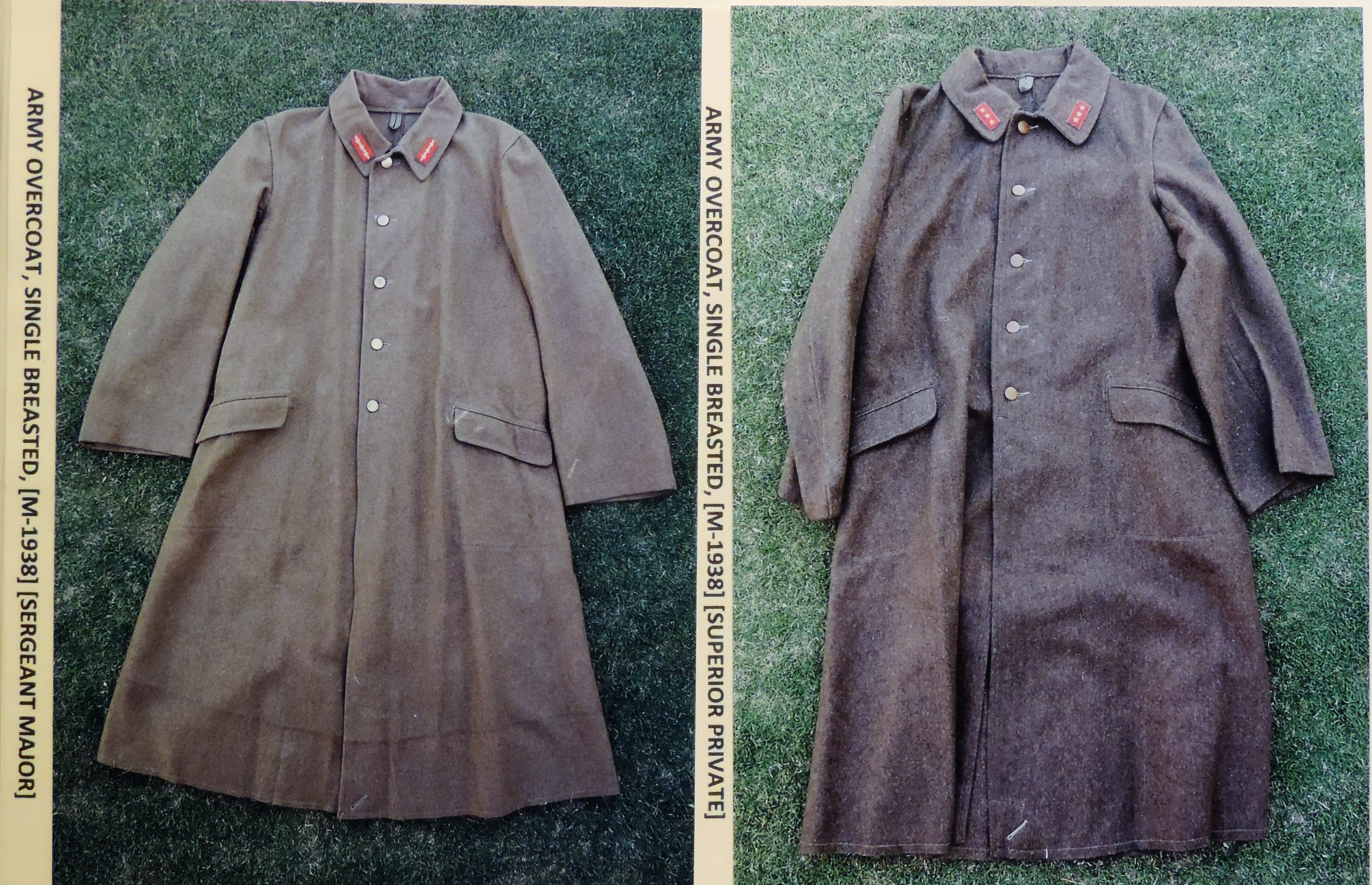
Figure 123. Japanese Army M-1938 overcoats. |

Figure 131. Japanese Army capes. |
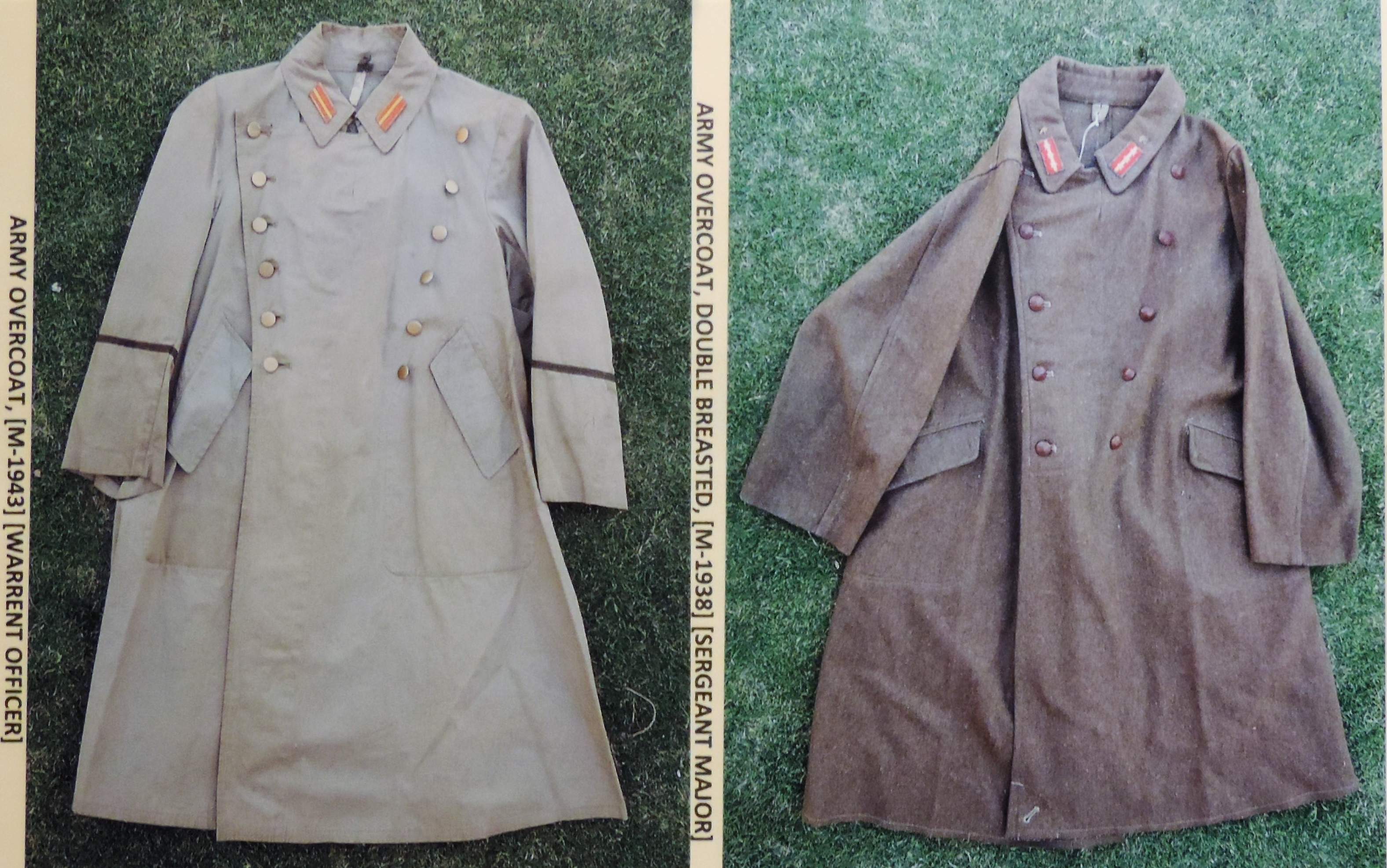
Figure 133. Japanese Army M-1938 and M-1943 overcoats. |
Officers wear overcoats of similar design, but have sleeve insignia consisting of l, 2, or 3 stripes of dark-brown braid qn or above the cuff to indicate company, field or general officers' grades respectively. Sometimes service dress capes also are worn by officers. All overcoats and capes are equipped with detachable hoods which button on The throat piece, which gives good c1osure across the neck, carries 2 or 3 strips as an indication of company, field, or general officer ranks.
h. WWII Japanese The Raincoat.
Cotton raincoats with hoods are issued to Japanese troops, but in most theaters they prefer to use the shelter half as rain protection.
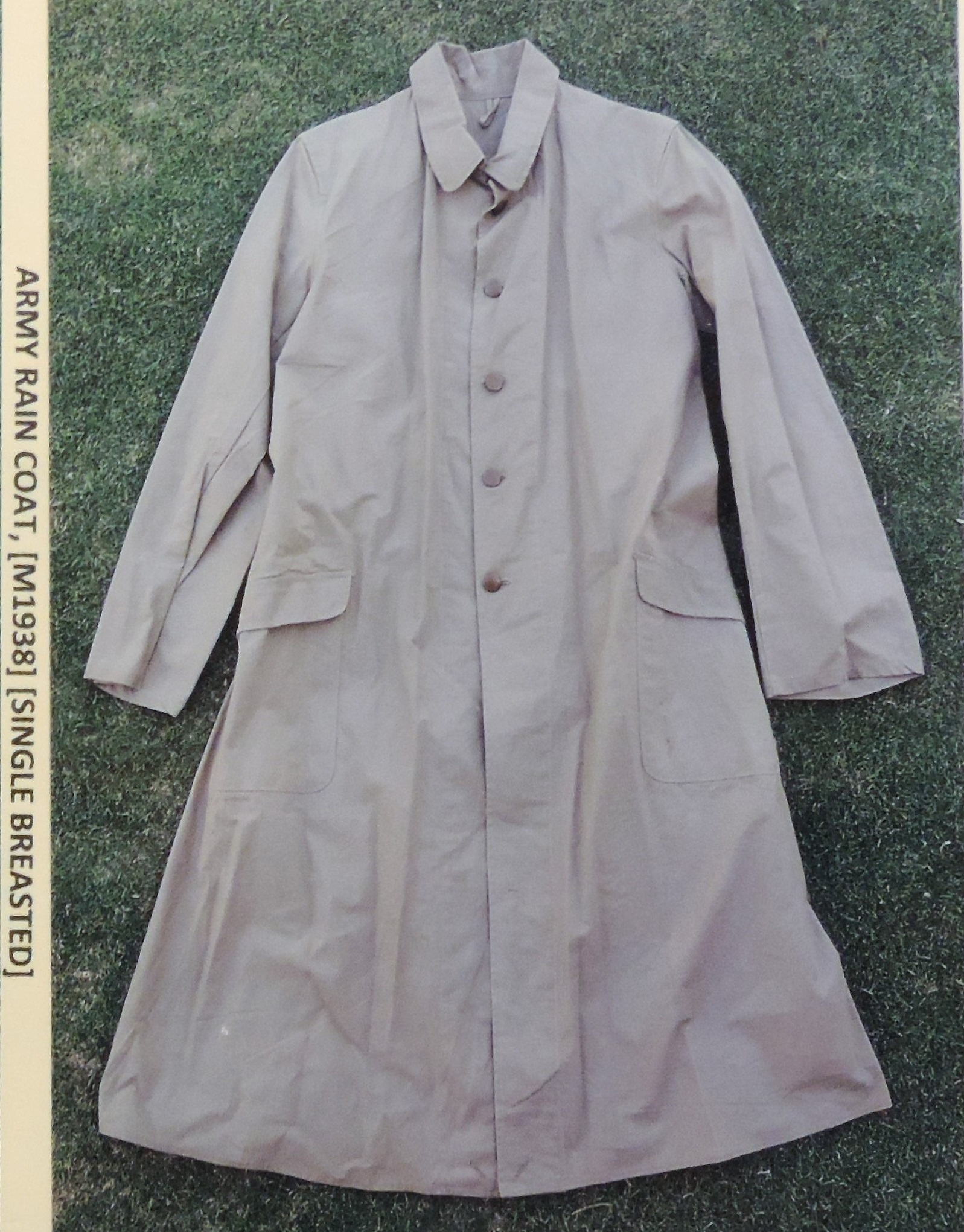
Figure 134.
Japanese Army M-1938 single breasted raincoat.
i. WWII Japanese Clothing worn under the uniform.
The Japanese often wear a breech clout, cotton or cotton and wool underwear, and cotton or cotton and wool shirts. Usually only the officers' shirts have collars. In hot climates, the breech clout sometimes is worn alone.
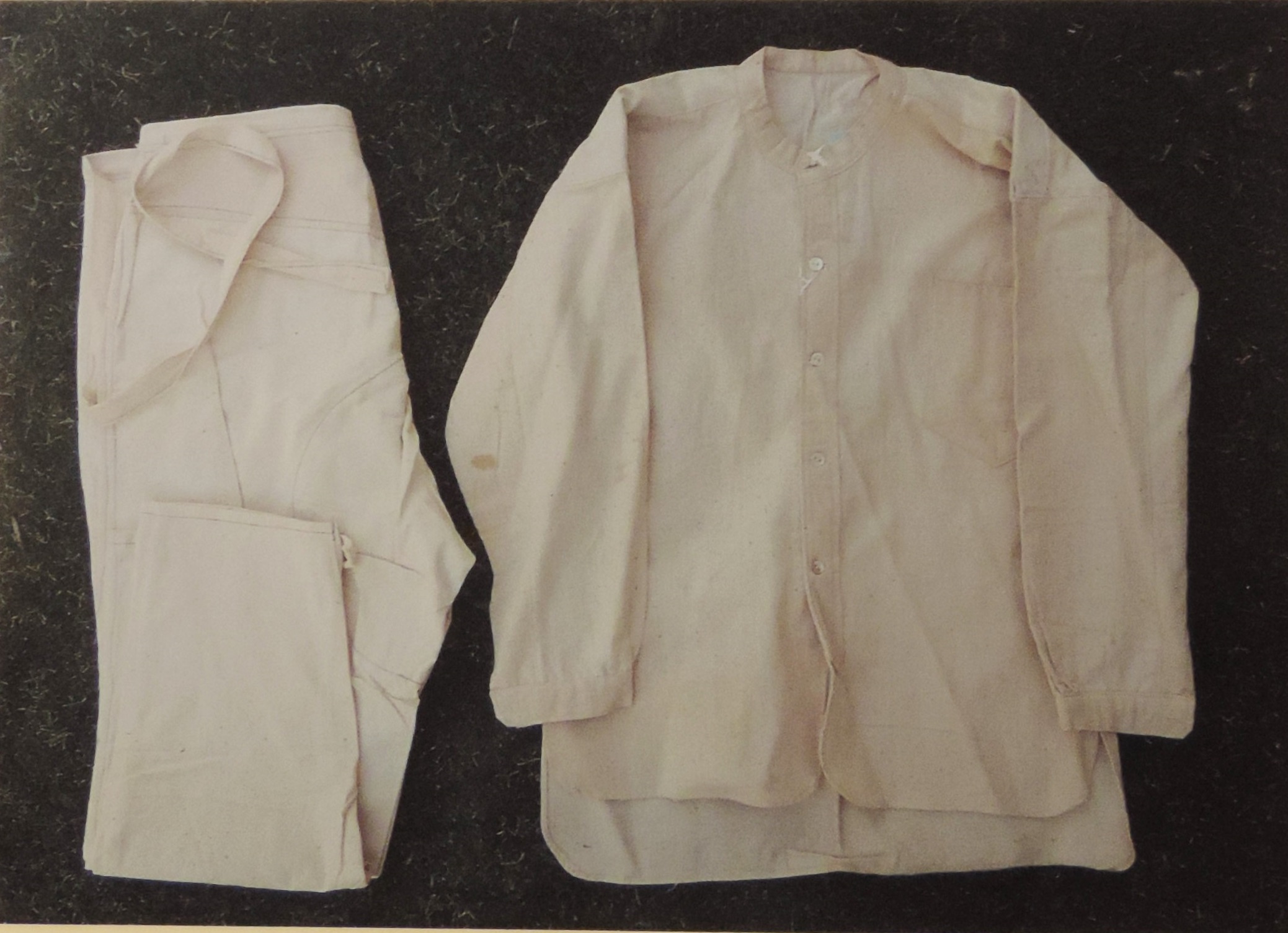
Figure 125. Japanese Army enlisted men long underwear. |
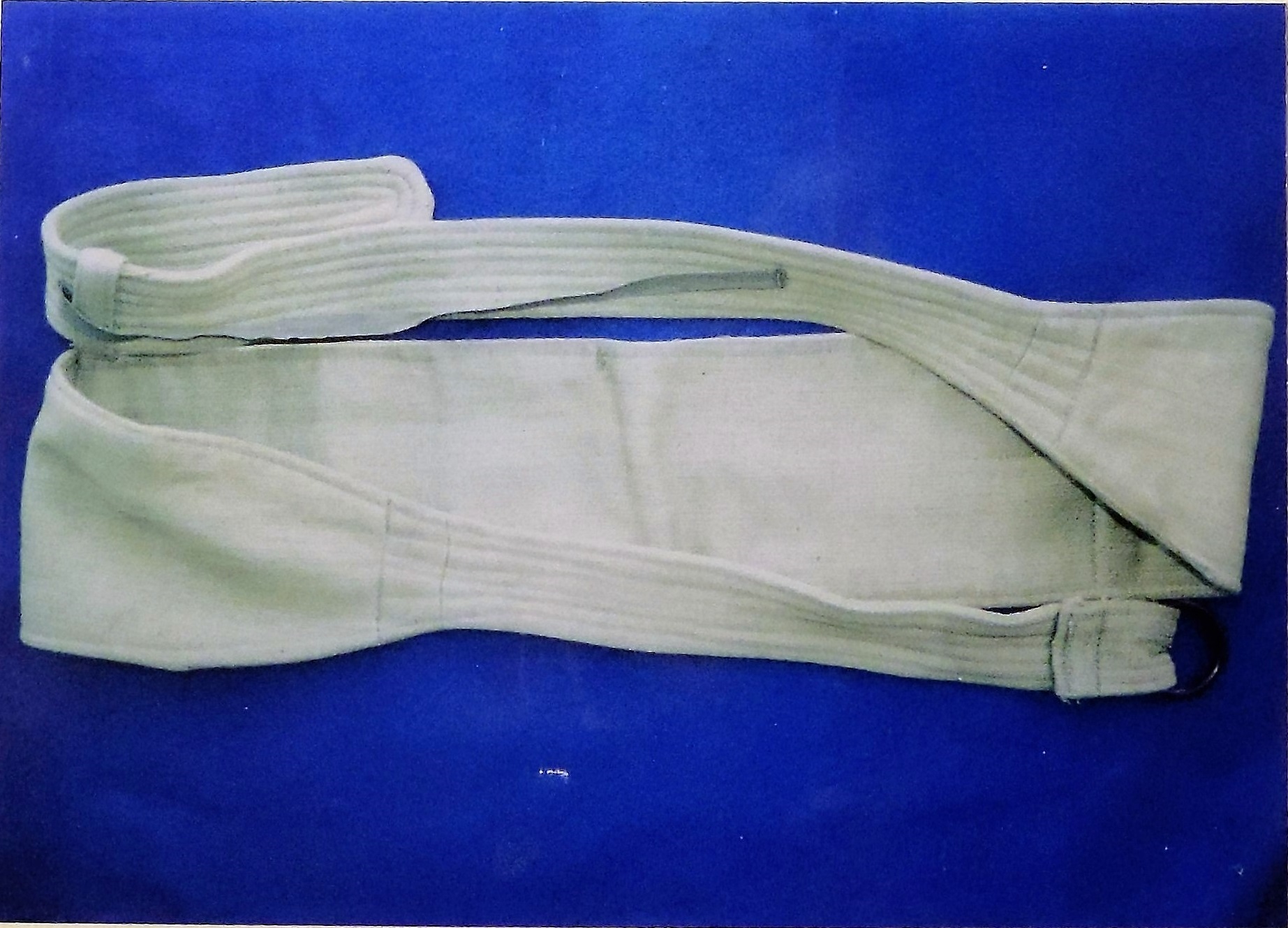
Figure 124. Japanese Army NCO money belt. |
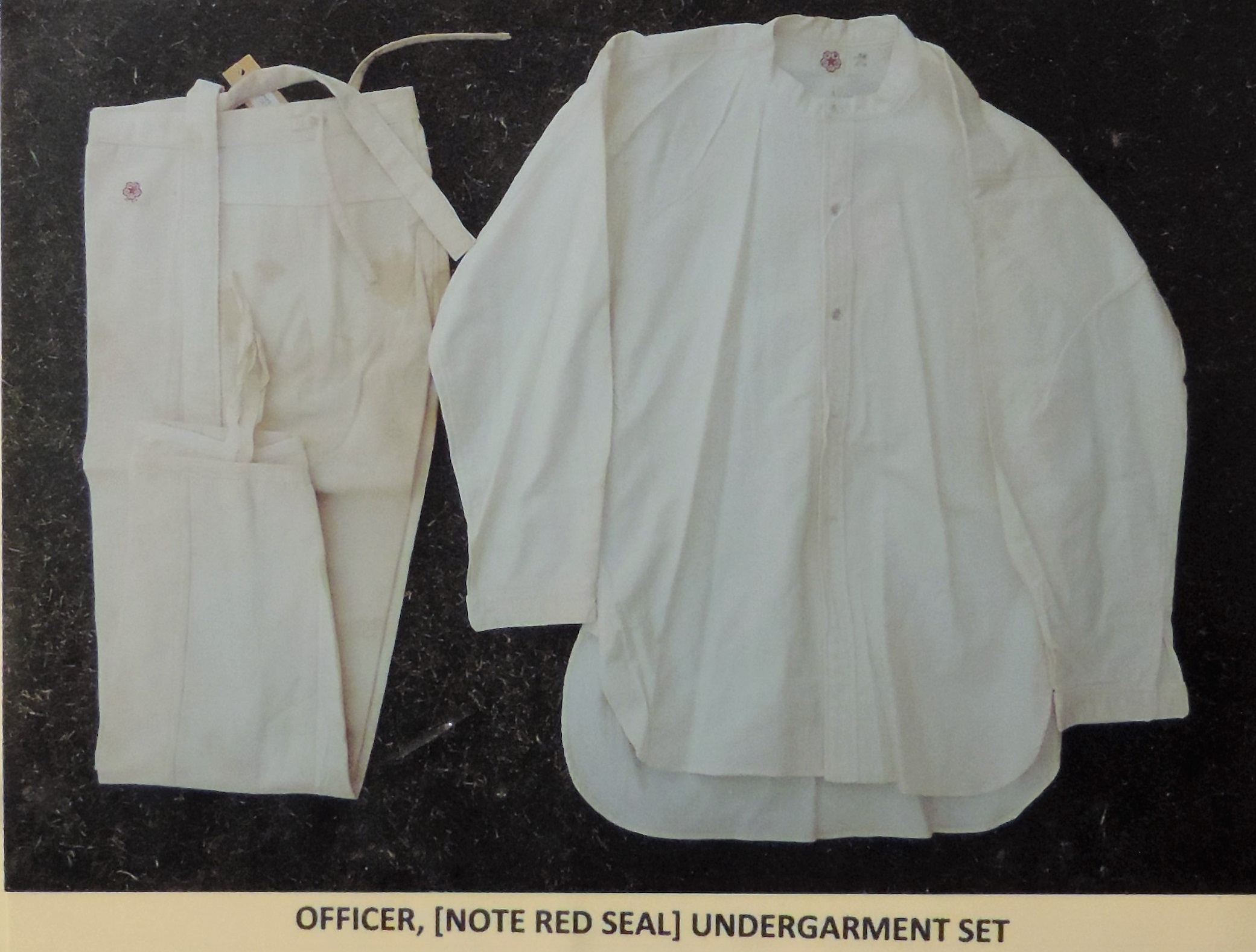
Figure 132. Japanese Army officer undergarment set. |

Figure 135. Japanese Army enlisted men socks. |
j. Senninbari
(1000-stitch good luck belt). This is a red sash, made with 1,000 stitches and sometime worn by Japanese soldiers around the waist under the uniform. It is supposed to confer luck, courage and possible immunity from enemy fire.
2. WWII JAPANESE UNIFORMS FOR SPECIAL ARMS.
a. WWII Japanese tank personnel.
Tank troops wear coveralls of a material similar to that used in the summer cotton uniform. The suit which buttons up the front has a turn-down collar and a left breast pocket.
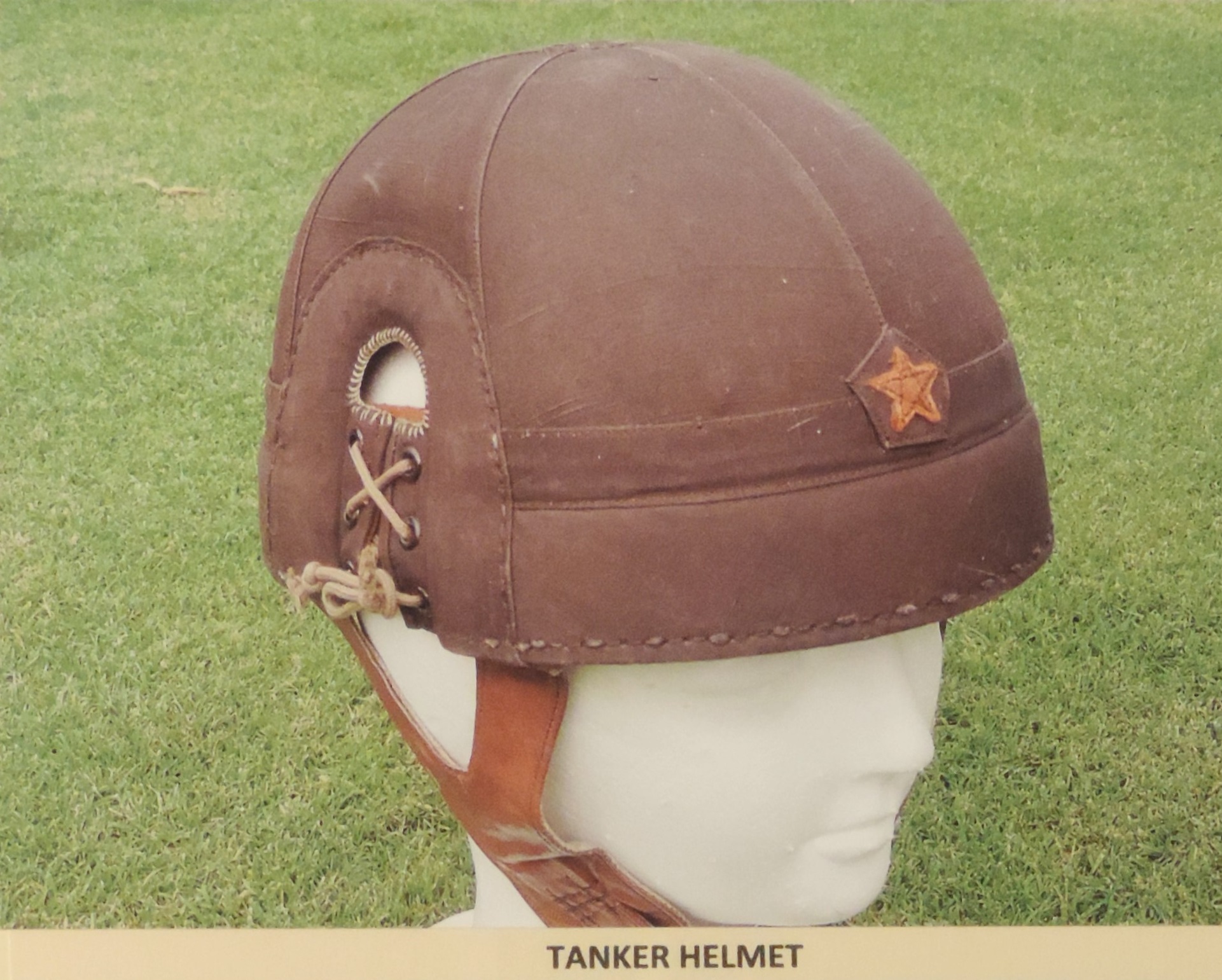
Figure 140. Japanese Army tanker helmet. |
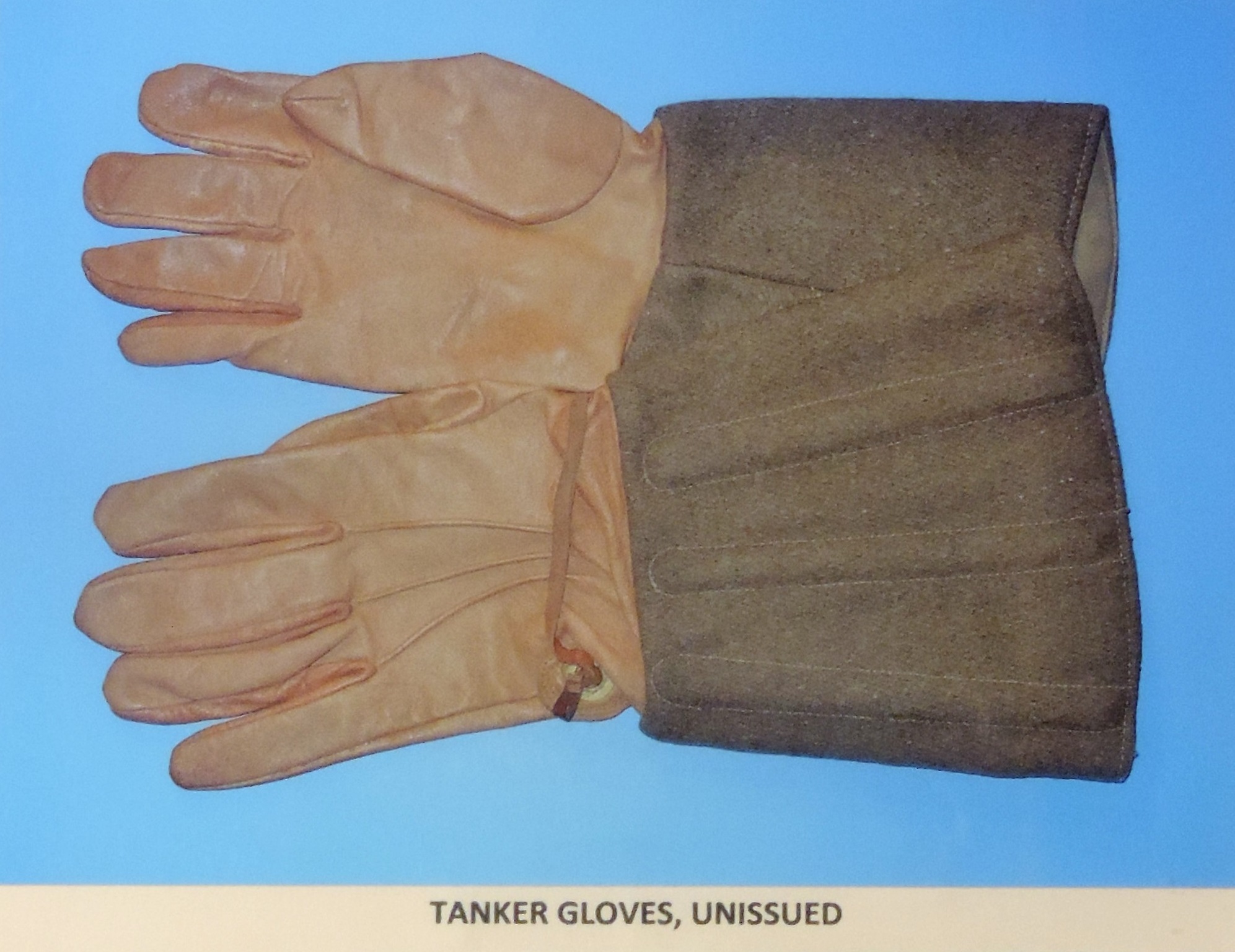
Figure 141. Japanese Army tanker gloves. |
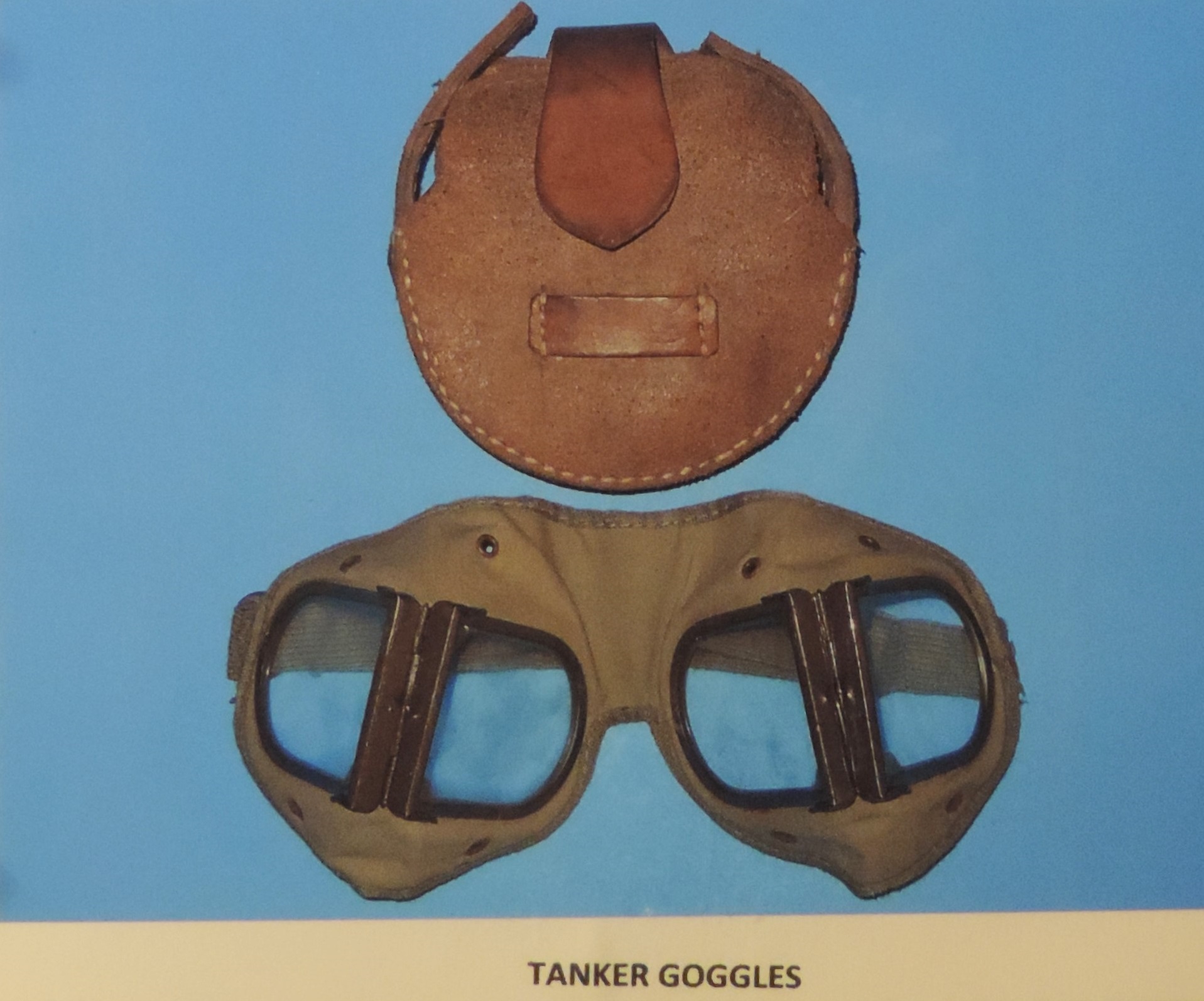
Figure 142. Japanese Army tanker goggles. |
b. WWII Japanese Paratroops.
The sleeveless cotton paratroop coverall is worn over the uniform and field equipment. It reaches to the knees and snaps tightly around the legs.
c. WWII Japanese army Individual camouflage.
The Japanese rely to a great extent on the individual to improvise his own camouflage methods. Troops are taught how to attach leaves, wisps of grass, and foliage to helmet and body camouflage nets. The body nets, some of which have mottled patterns, are used especially as a drape to conceal the outline of the body. In other cases soldiers sew loops of thread over their clothing to use for attaching foliage.
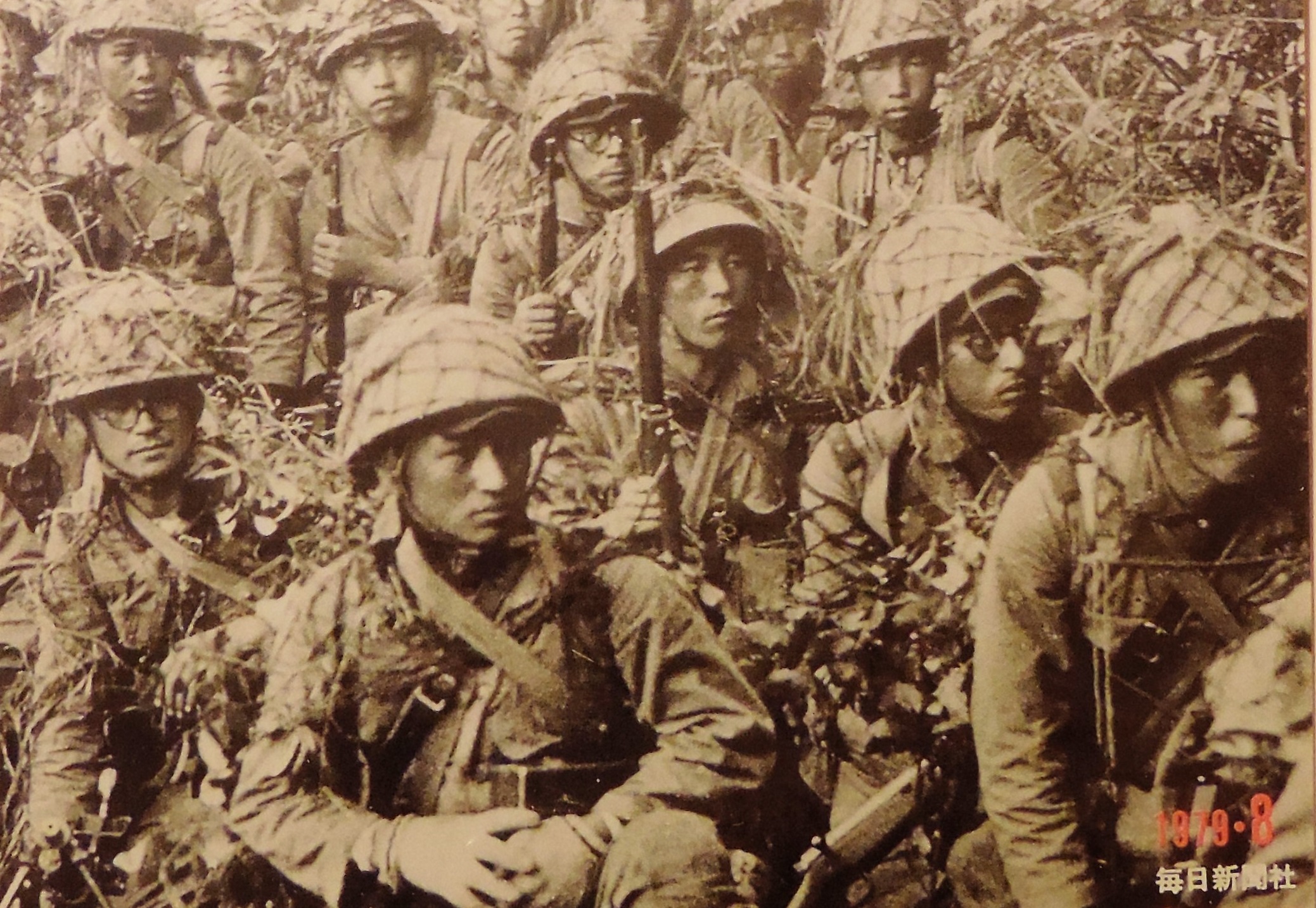
Figure 143.
Japanese Army soldiers in camouflage.
3. SPECIAL COLD AND HOT WEATHER CLOTHING.
Japanese soldiers have been well trained in the use of cold weather clothing, and the different reqruements of each individual are taken into consideration. They are well aware of the "layering" principle, adding or removing a layer of clothing as needed. The Japanese jungle soldier is issued a minimum of clothing and equipment. Open throat cotton shirts, with either short or long sleeves, and cotton trousers, worn with spiral puttees, are the usual clothing. In some areas shorts are worn, but rarely in combat areas.
WWII JAPANESE COLD WEATHER UNIFORMS AND EQUIPMENT
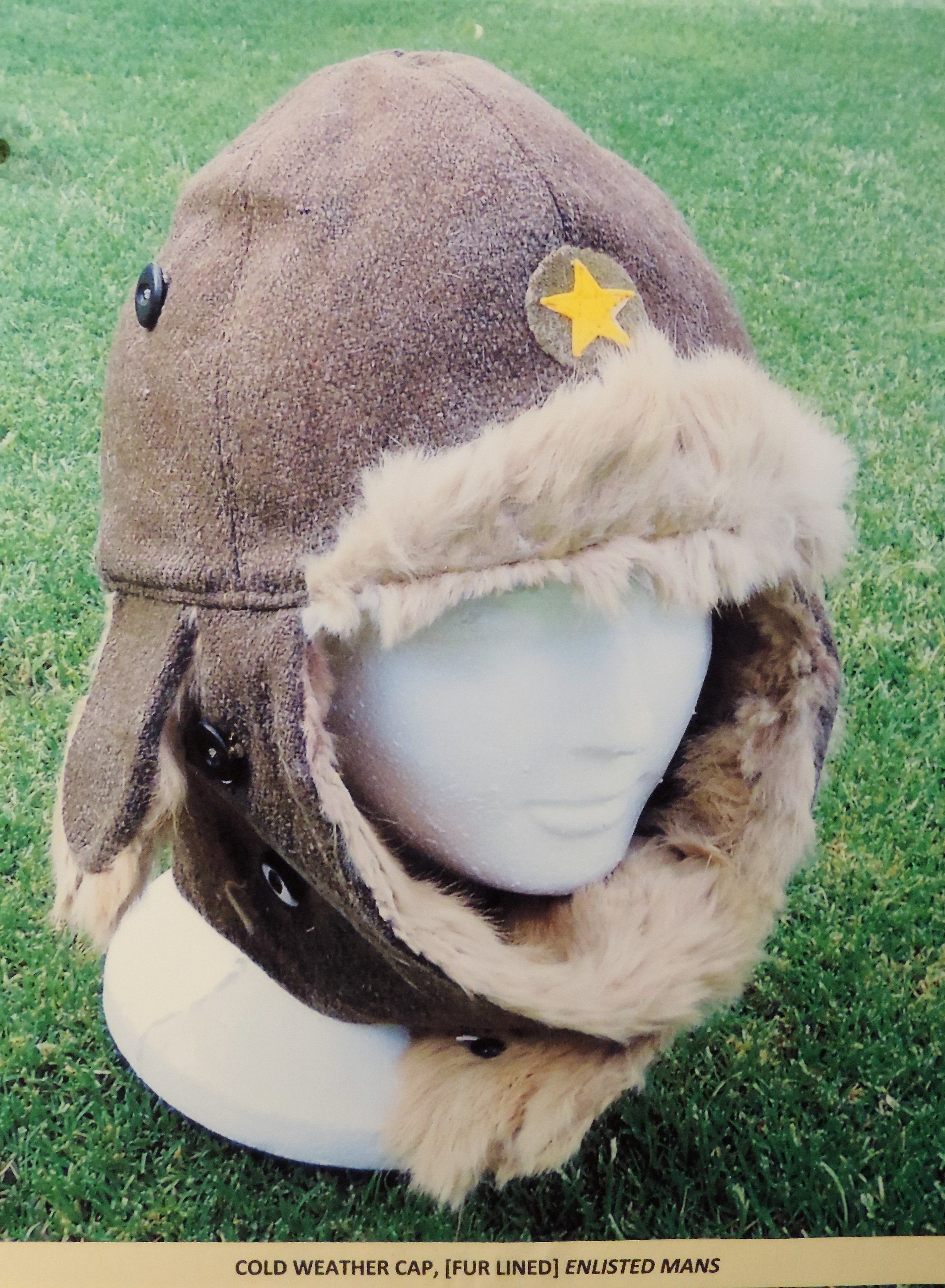
Figure 126. Japanese Army enlisted cold cap. |
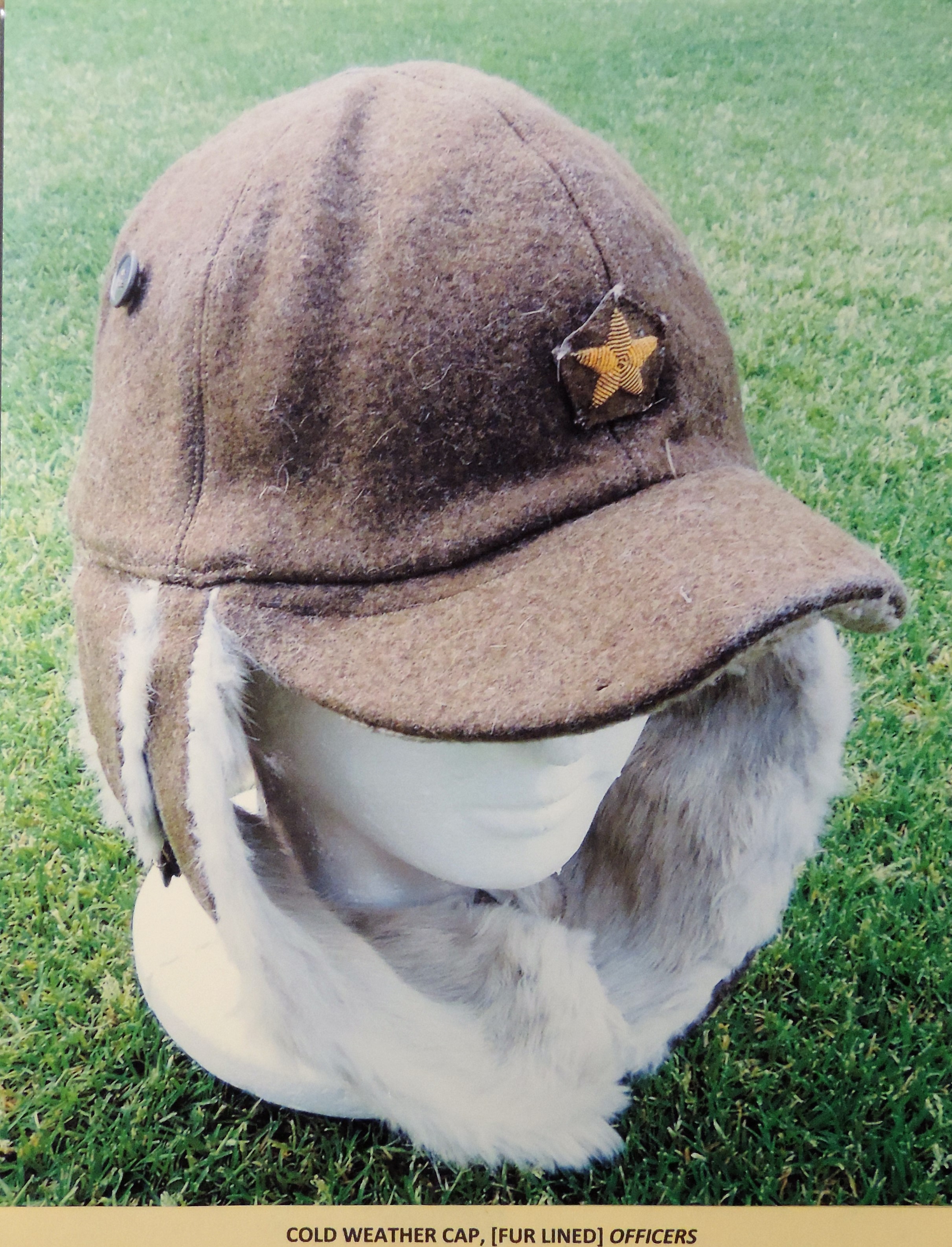
Figure 127. Japanese Army officer cold cap. |
WWII JAPANESE HOT WEATHER (TROPICAL) UNIFORMS & EQUIPMENT
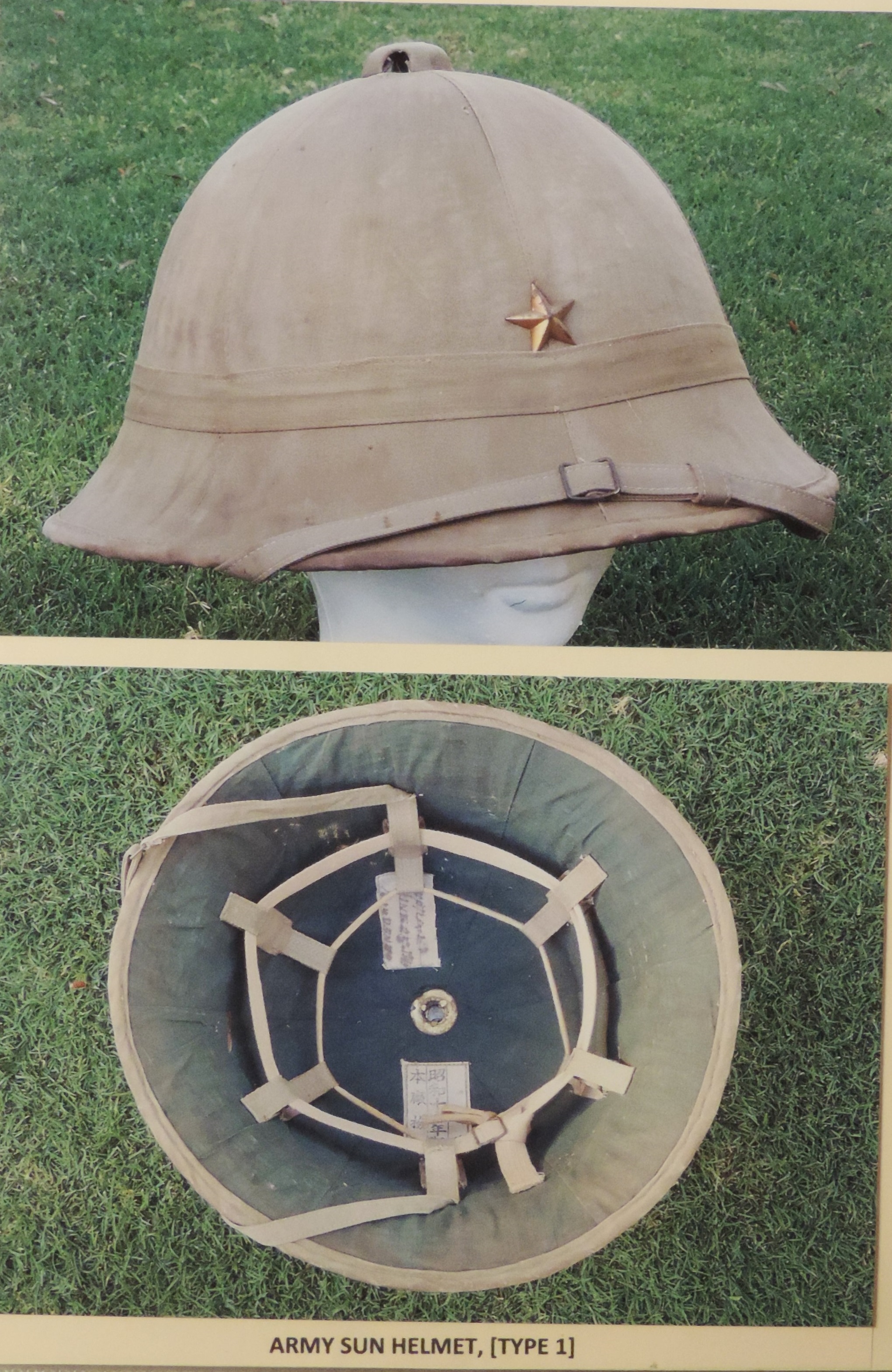
Figure 128. Japanese Army sun helmet Type I. |
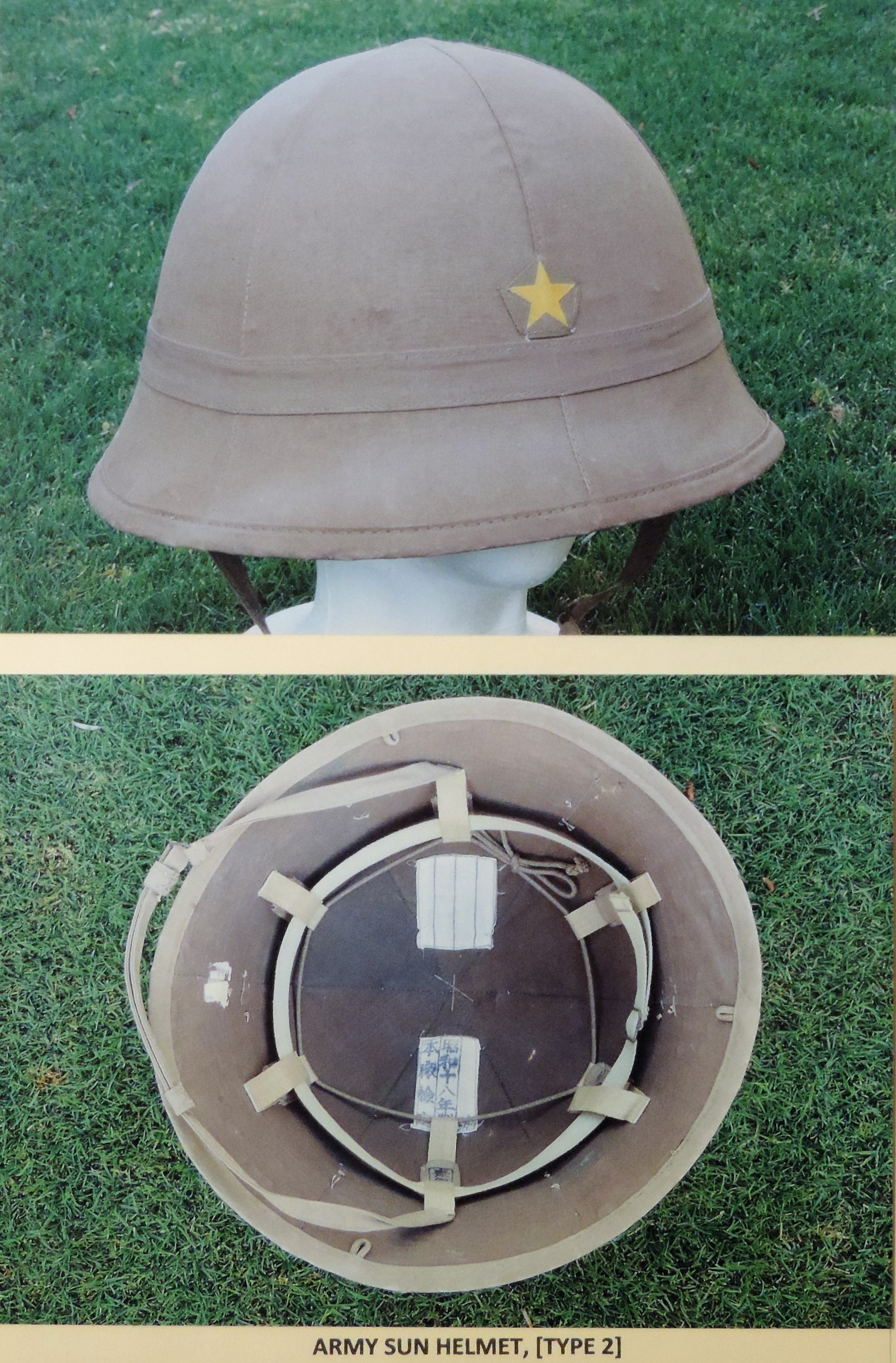
Figure 129. Japanese Army sun helmet Type II. |
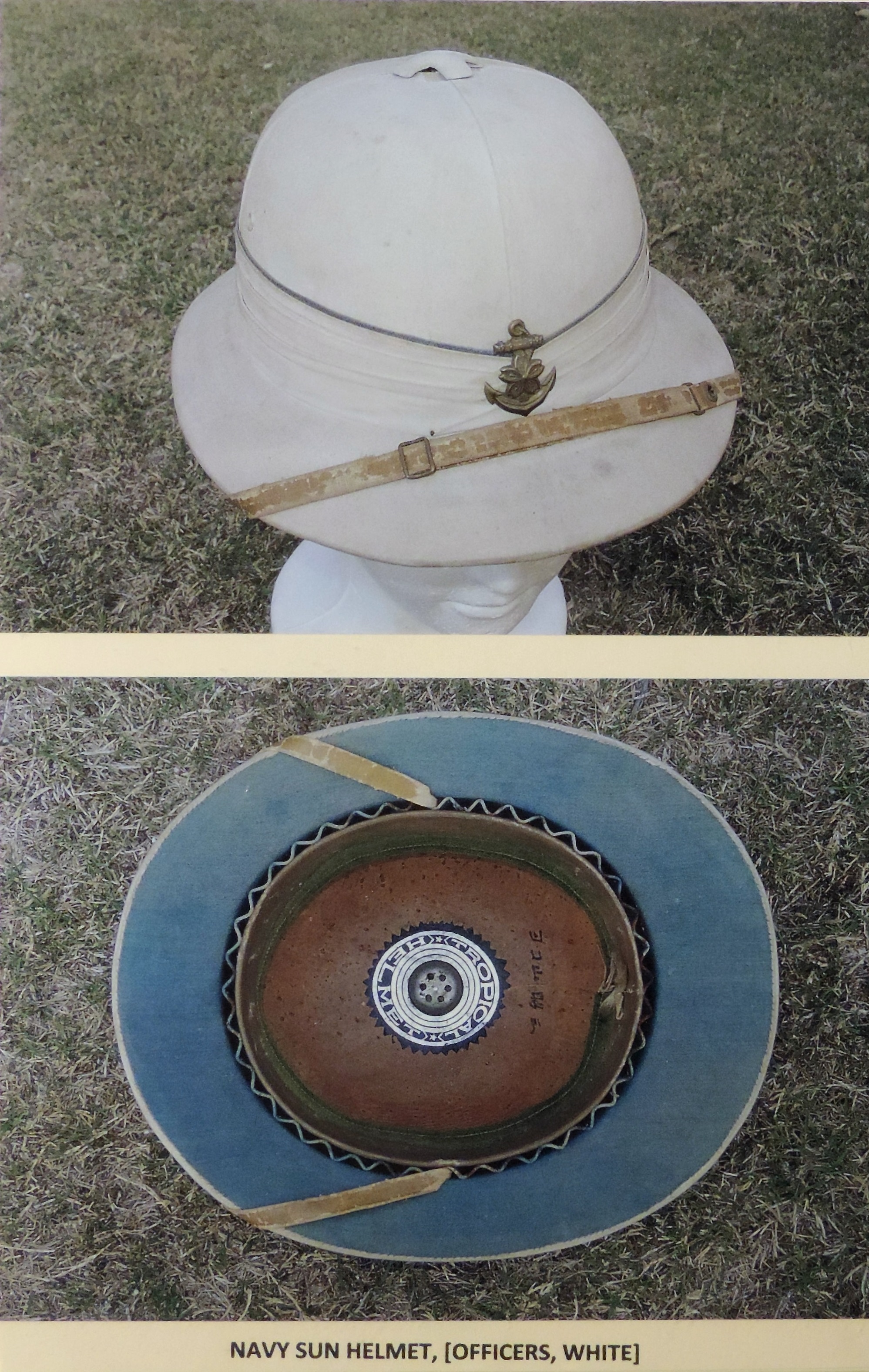
Figure 130. Japanese Navy sun helmet. |
WWII JAPANESE ARMY UNIFORMS PLATES
The following is a comprehensive listing of various uniforms employed by the Japanese army.
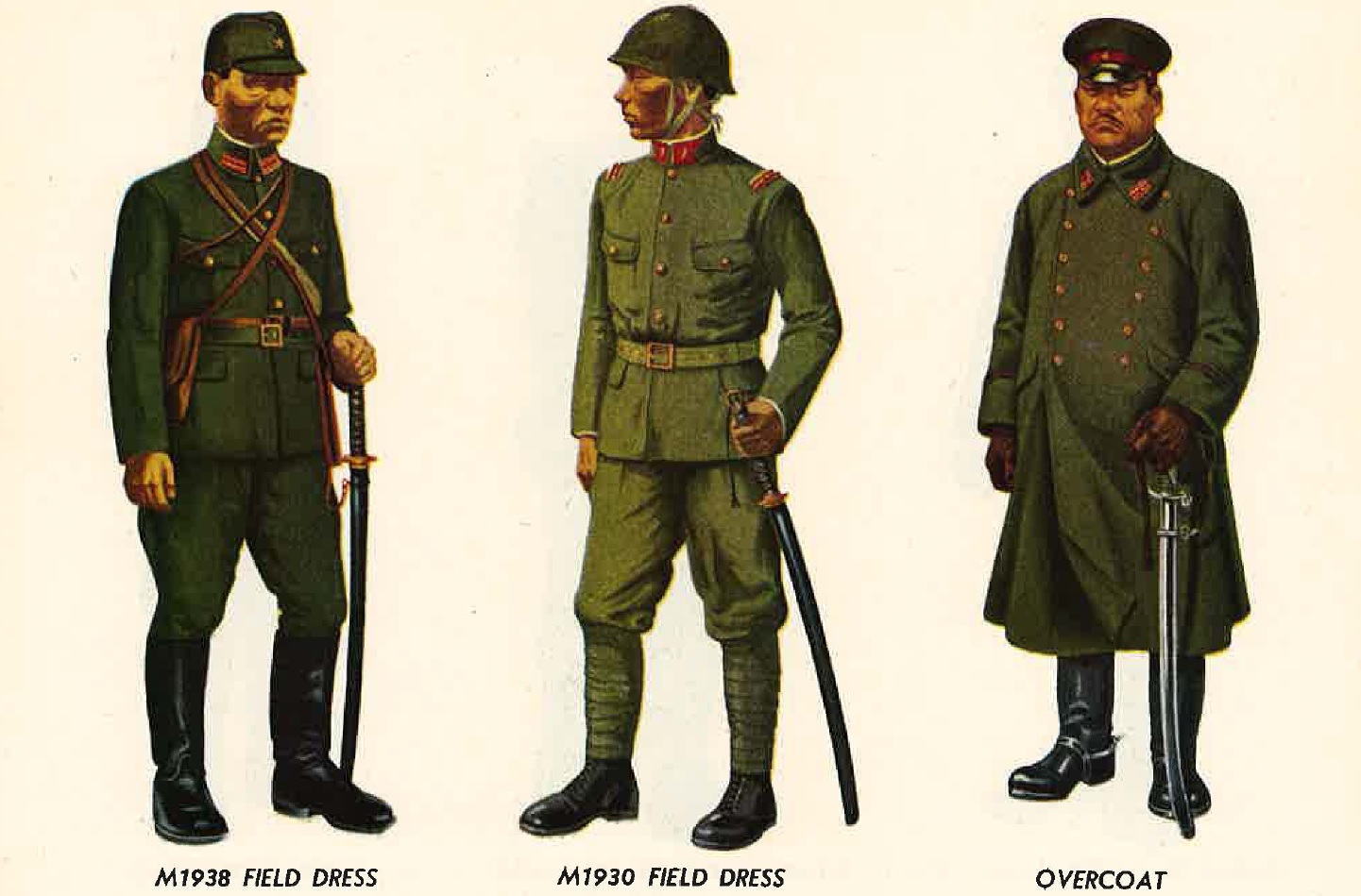
Figure 1. Japanese Army officer uniforms. |
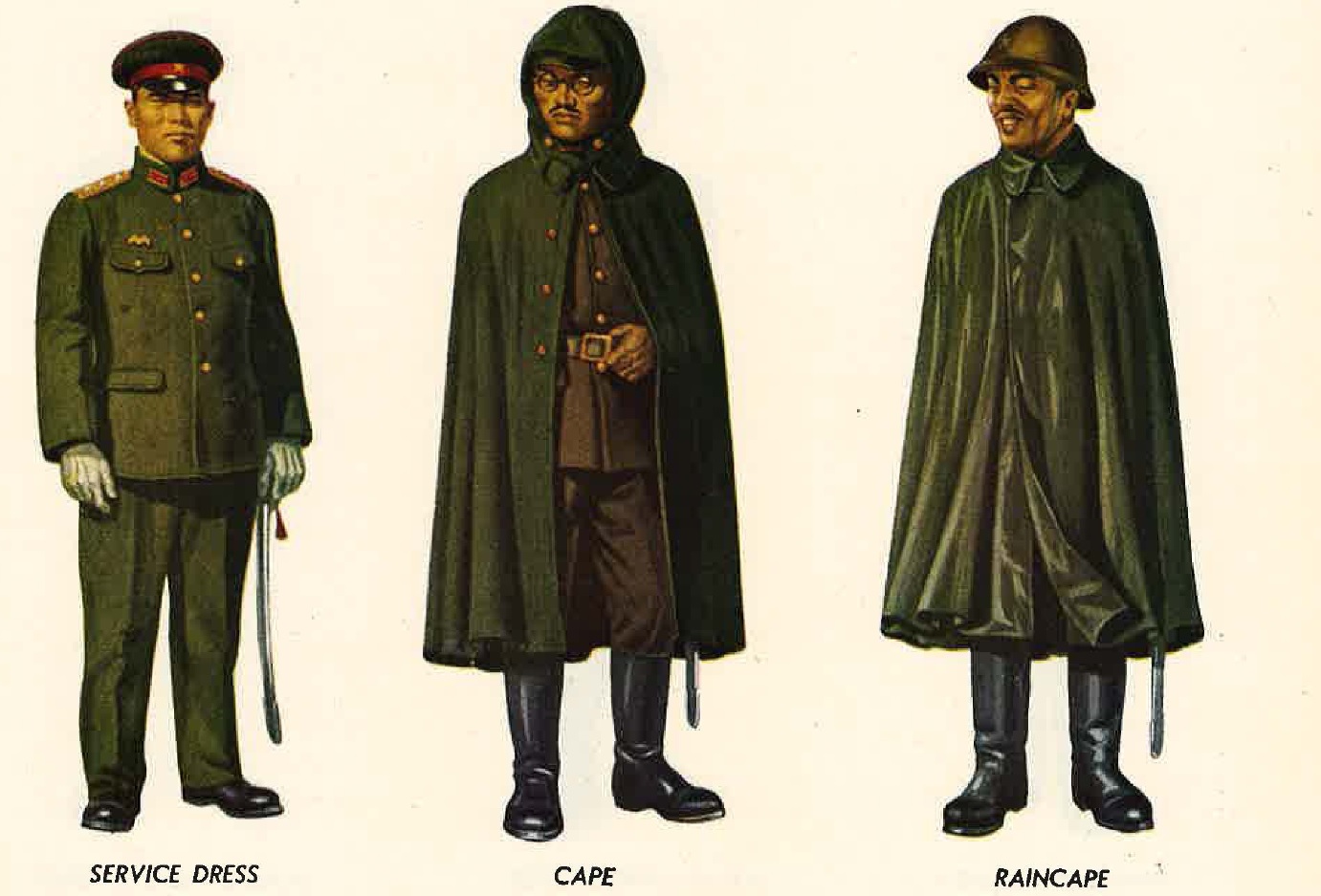
Figure 2. Japanese Army officer uniforms. |
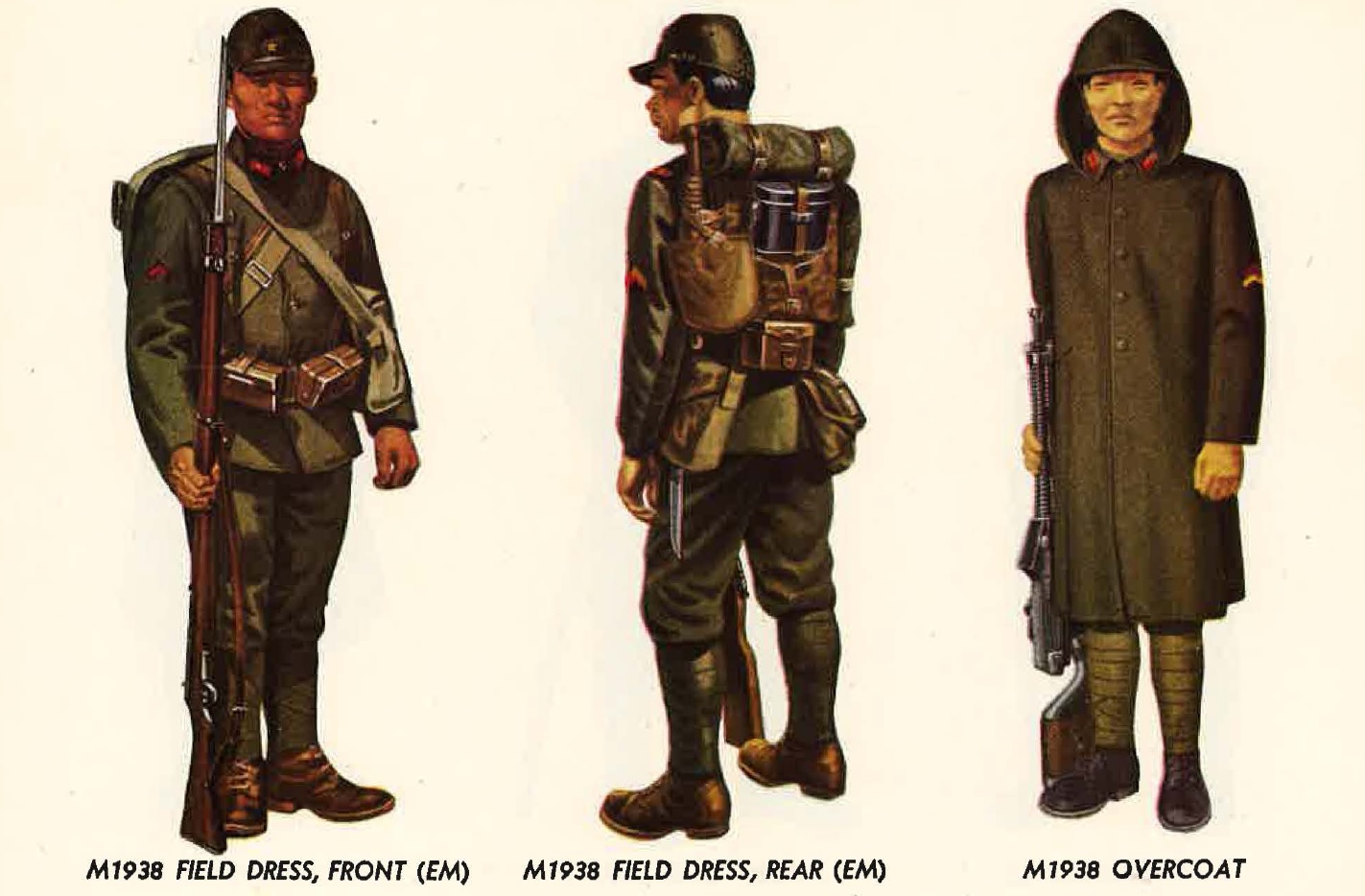
Figure 3. Japanese Army NCO and enlisted men uniforms. |
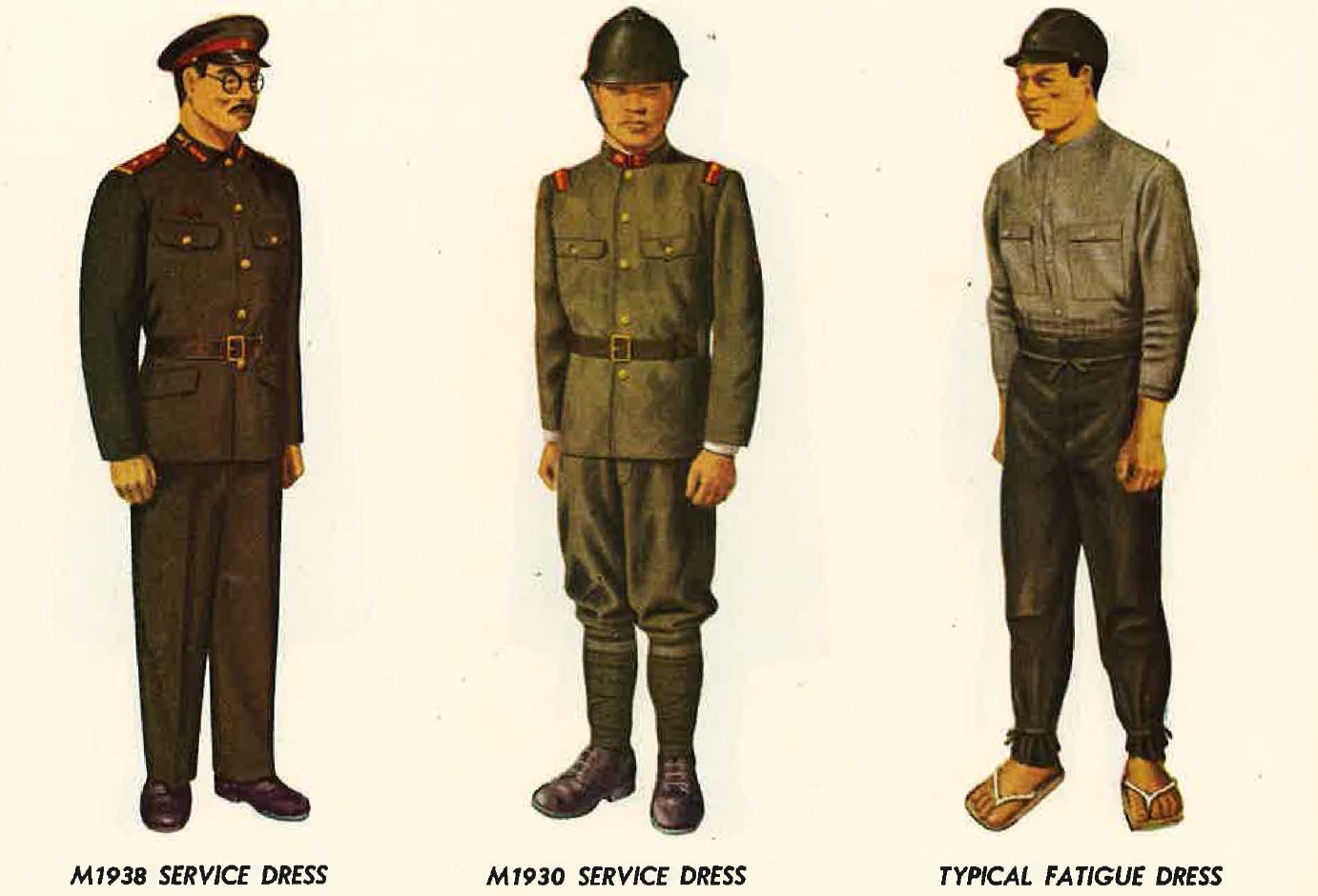
Figure 4. Japanese Army NCO and enlisted men uniforms. |
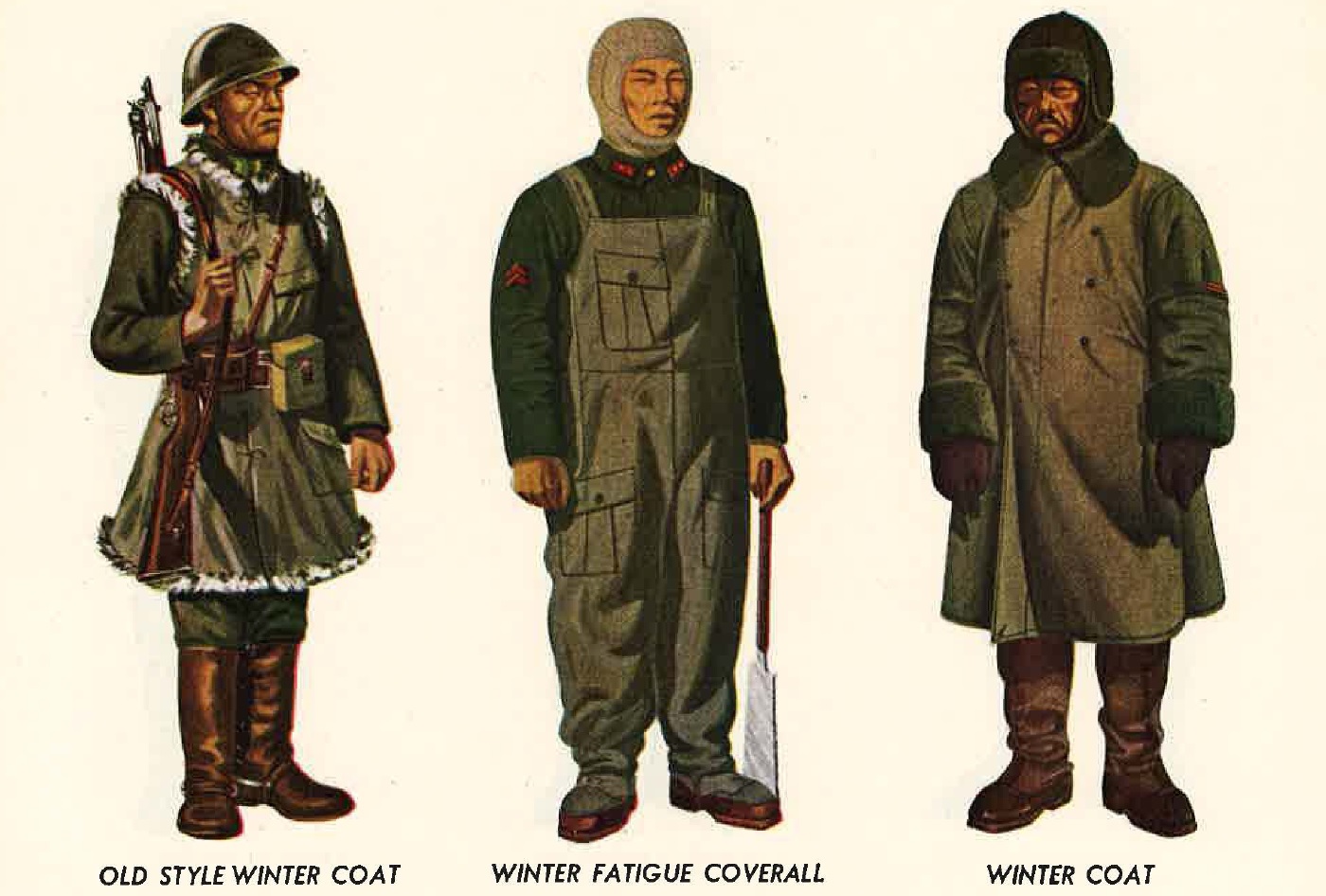
Figure 5. Japanese Army winter uniforms. |
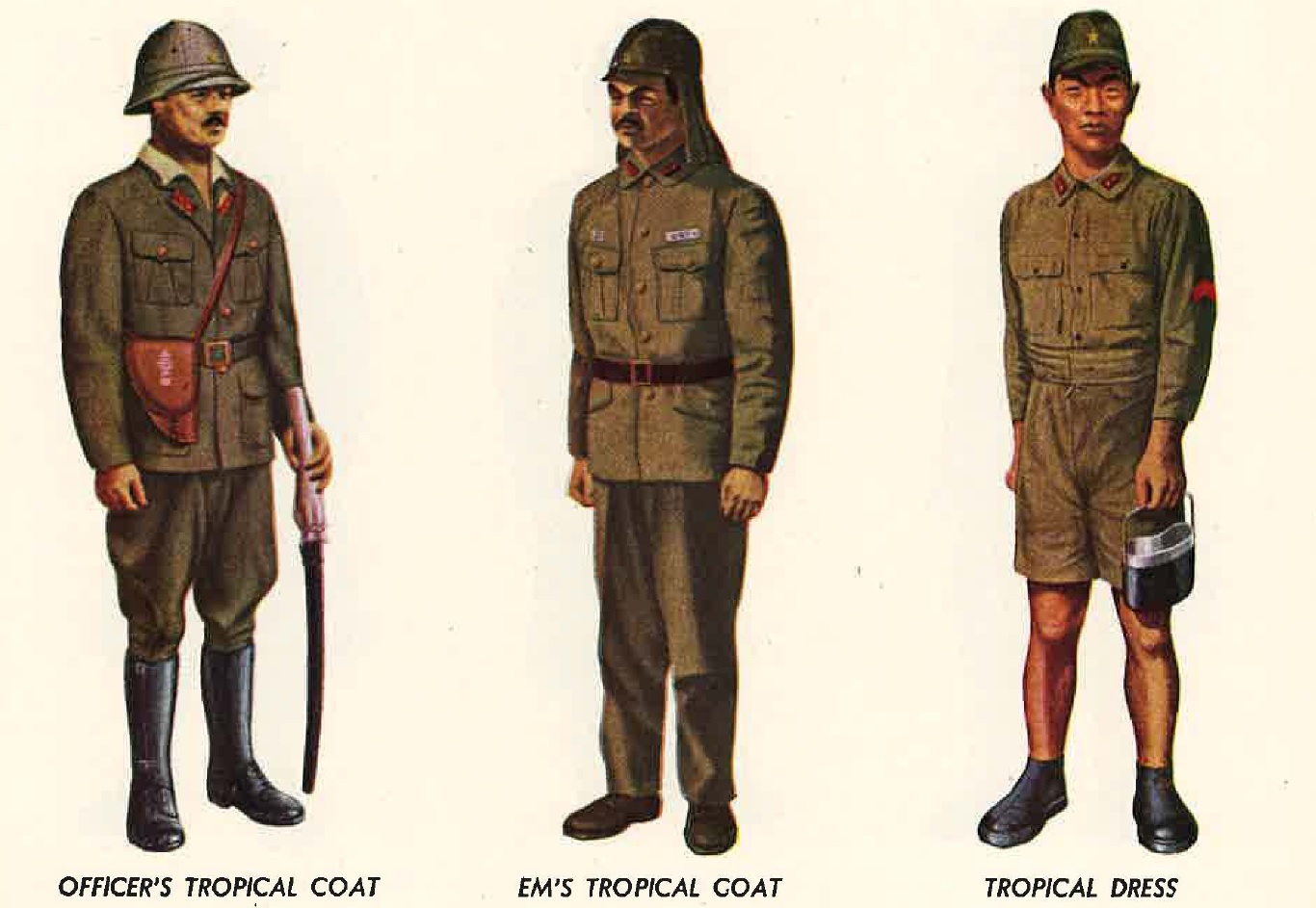
Figure 6. Japanese Army tropical uniforms. |
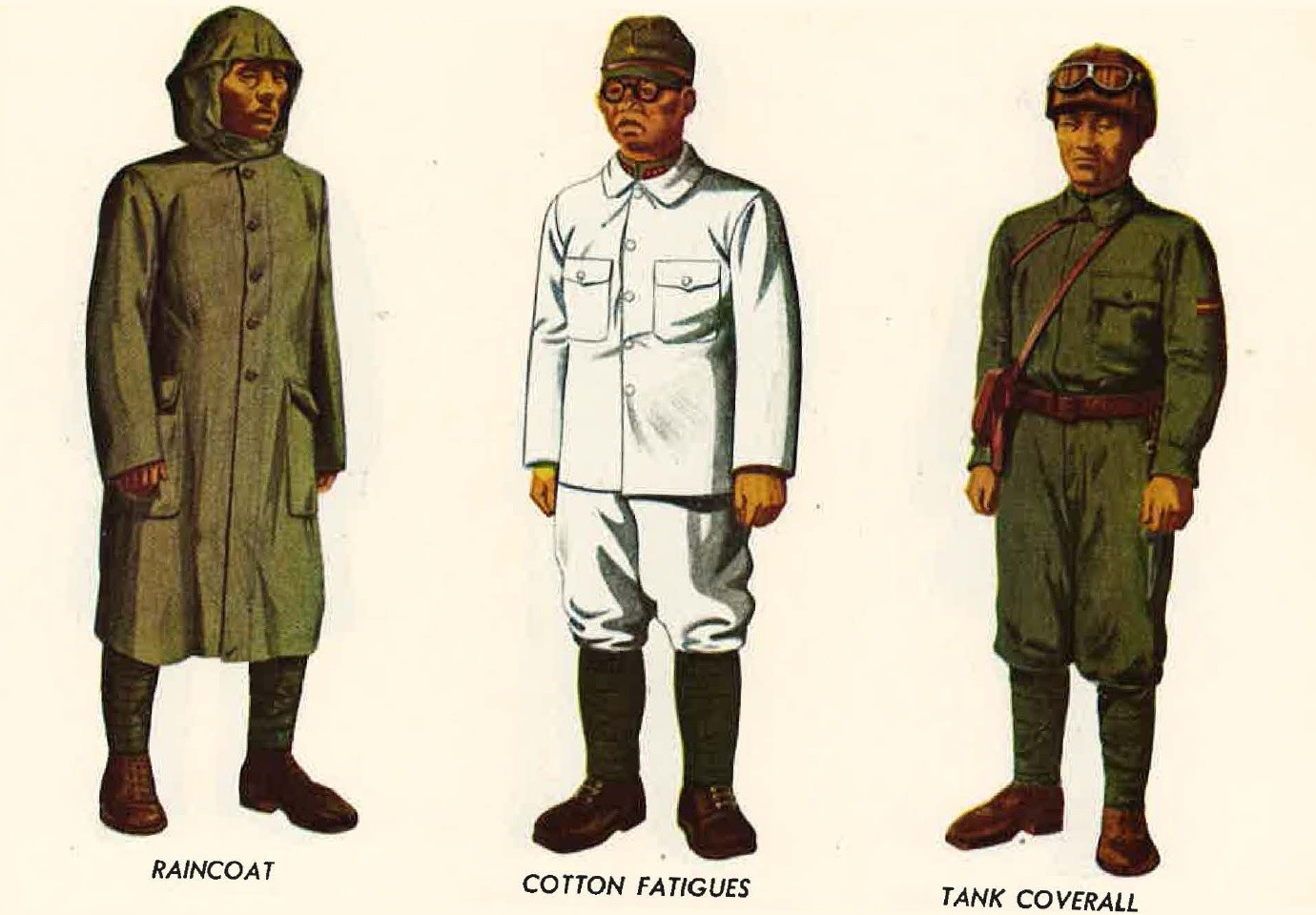
Figure 7. Japanese miscellaneous Army uniforms. |
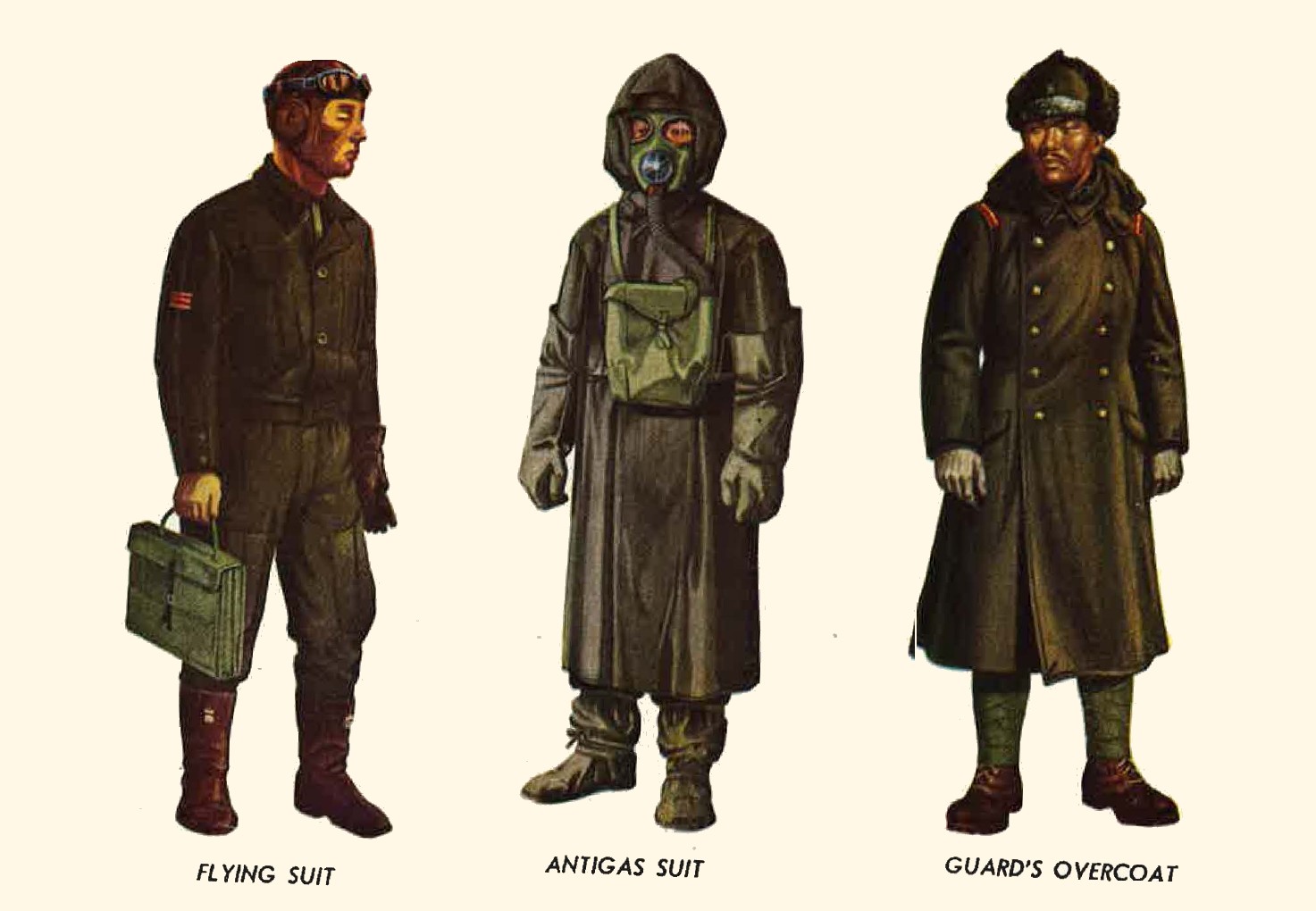
Figure 8. Japanese miscellaneous Army uniforms. |
WWII JAPANESE NAVY UNIFORMS PLATES
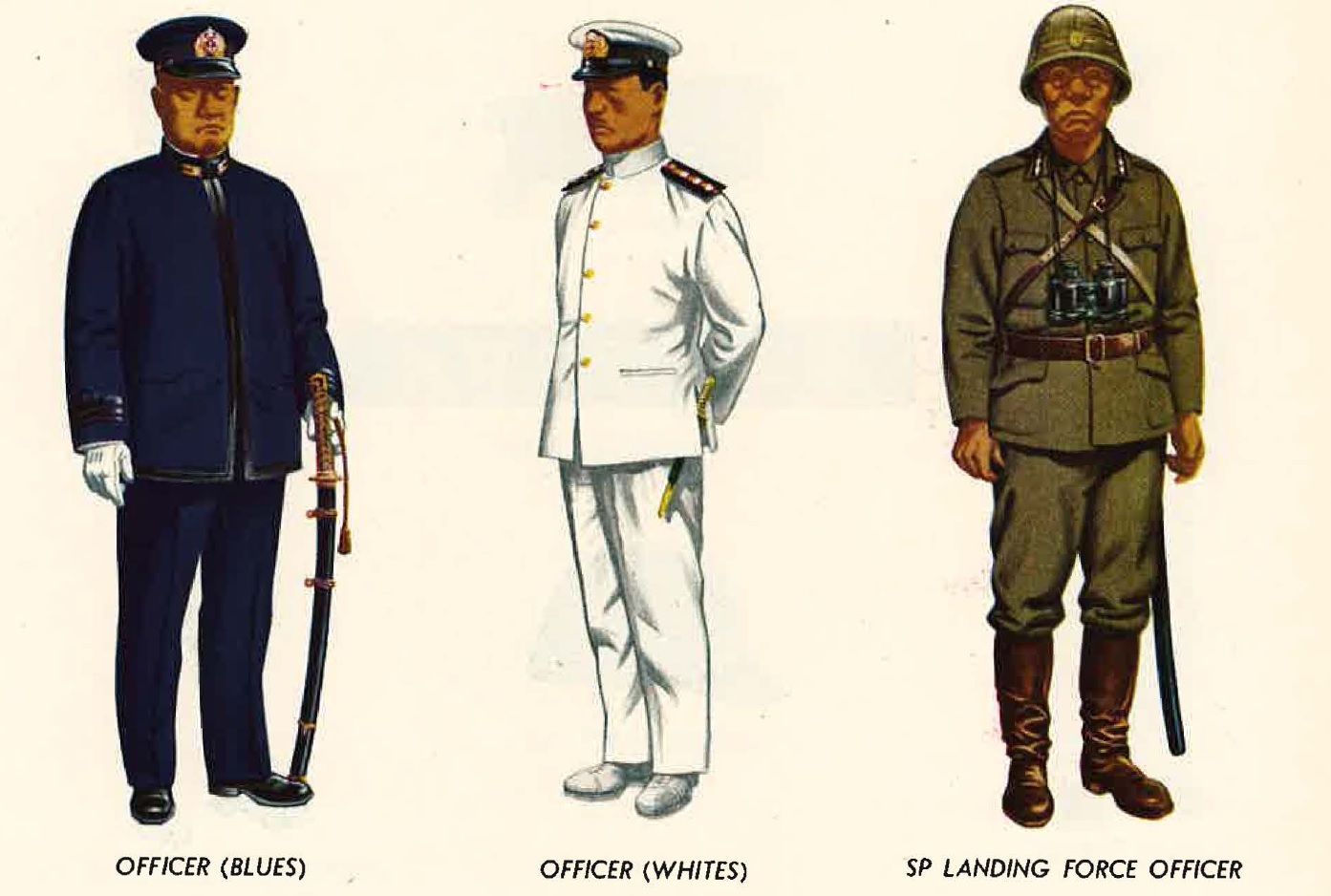
Figure 7. Japanese Navy officers and petty officers uniforms. |
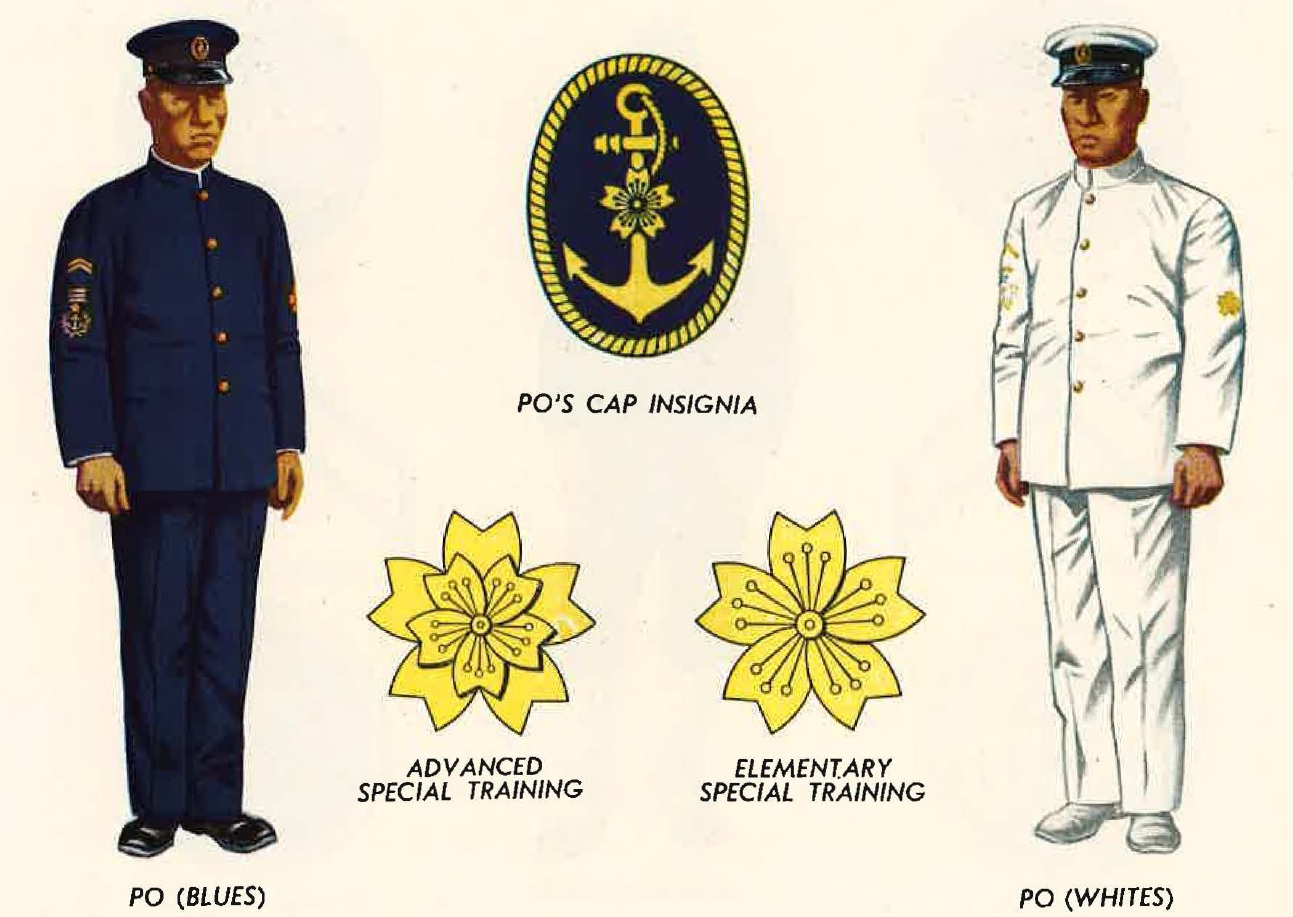
Figure 8. Japanese Navy uniforms. |
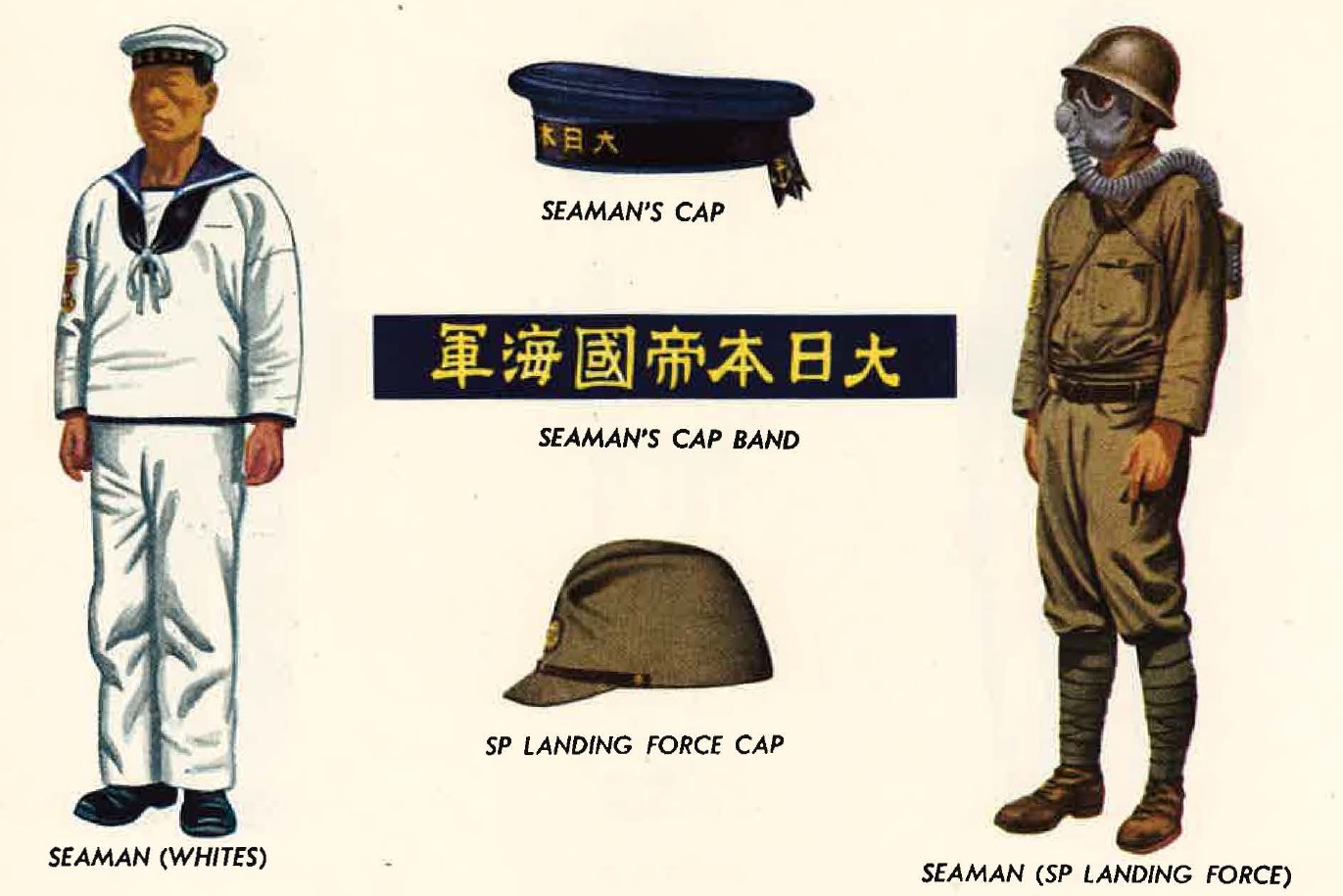
Figure 9. Japanese Seaman and petty officers uniforms. |
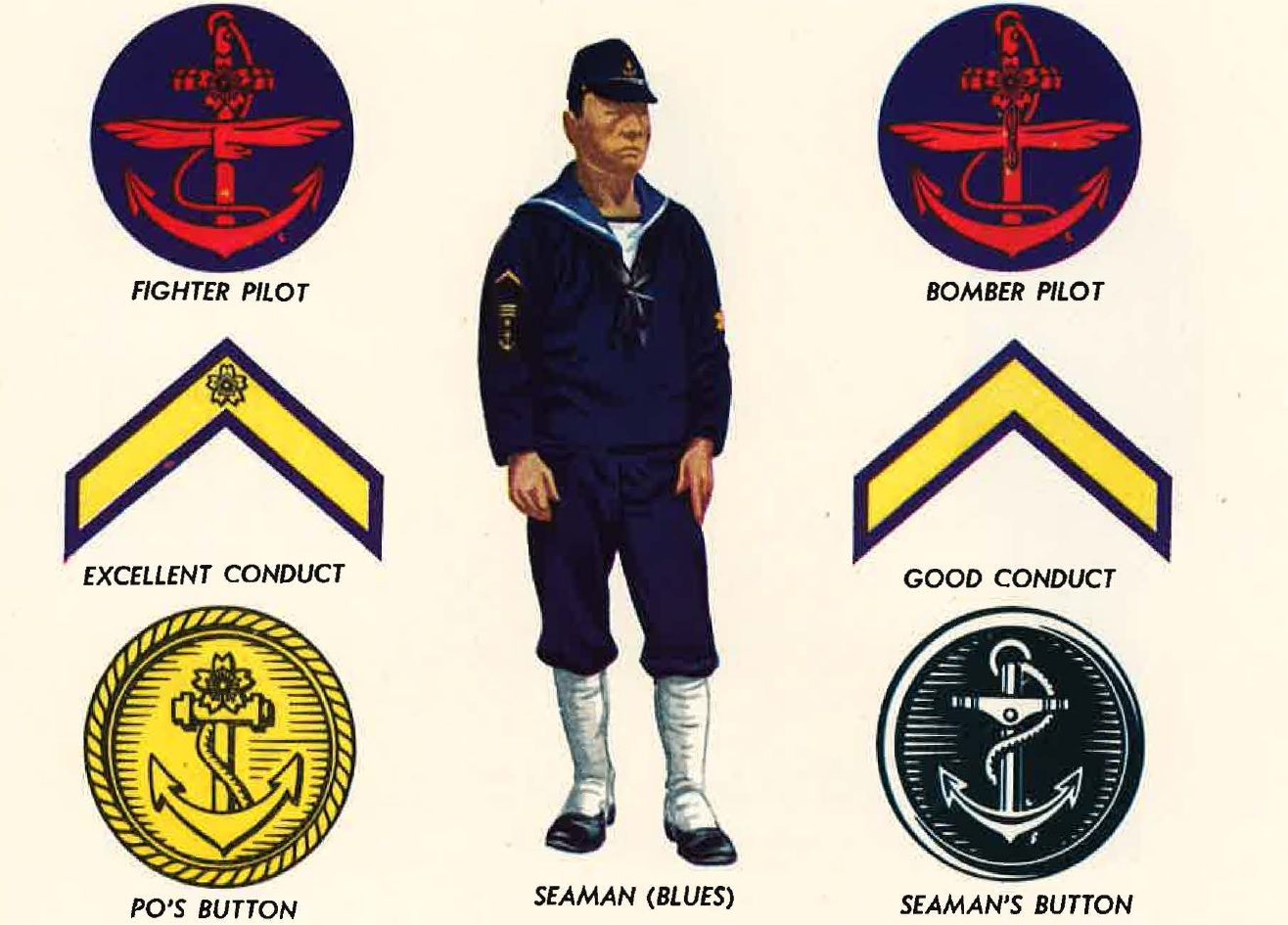
Figure 10. Japanese Navy uniforms. |

4. WWII JAPANESE MILITARY INDIVIDUAL FIELD EQUIPMENT.
a. WWII Japanese military Field equipment.
Generally speaking field equipment consists of the following items:
(1) The WWII Japanese military field pack.
The Japanese have several types of pack, the commonest now is a sack of heavy duck about 13 inches square and 5 inches deep. This is believed to supersede the older pack which was made of cowhide with the hair on. The noncommissioned officers' pack is slightly smaller; a type of officers' pack, with a leather backing is even smaller.
Some of these are made of heavy duck. Others were formerly tnade of leather or a combination of duck and leather, but now a rubberized fabric, not unlike the material used in belting, is being substituted for leather in all field equipment. This new fabric actually has certain advantages, especially in wet tropical regions where leather deteriorates rapidly. Aside from these special bags, many boxes or bags used by the Japanese soldier are designed for ease in carrying.
(3) The WWII Japanese army shelter half.
Although small by American or British standards, the shelter half is very serviceable. As a raincape it provides excellent protection against wetness and is preferred by many Japanese soldiers to the issue raincoat. A cord is attached to the middle of one end so that the shelter half can be suspended from the shoulders and tied under the chin. Loops through the eyelets on one of the sides then may be slipped through the eyelets on the opposite side to close it securely in front.
(4) The WWII Japanese military canteen.
The canteen, which hangs from a shoulder strap and rests on the right hip in a network of webbing straps, is made of aluminum and painted brown. There are 1 pint and 2½ pint sizes. The web straps were made of canvas. The center piece had a leather strap sewn in place which was used to secure the cap of the canteen. It was relatively common for the soldier to write his name on the canteen webbing. In the earlier examples the webbing was made of leather, which did not perform as well in the jungle environment.
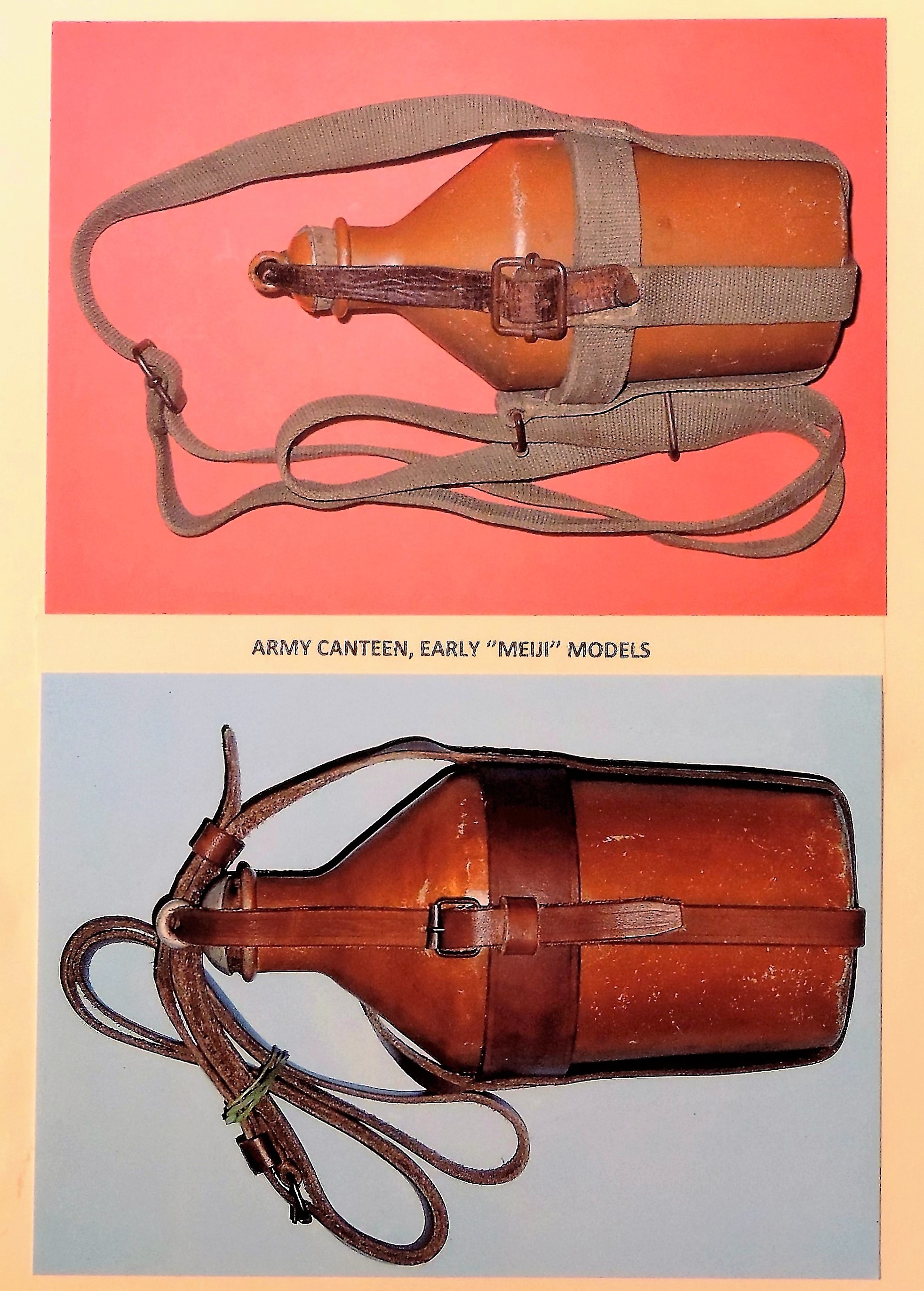
Figure 20. Army canteen early "Meiji" models. |
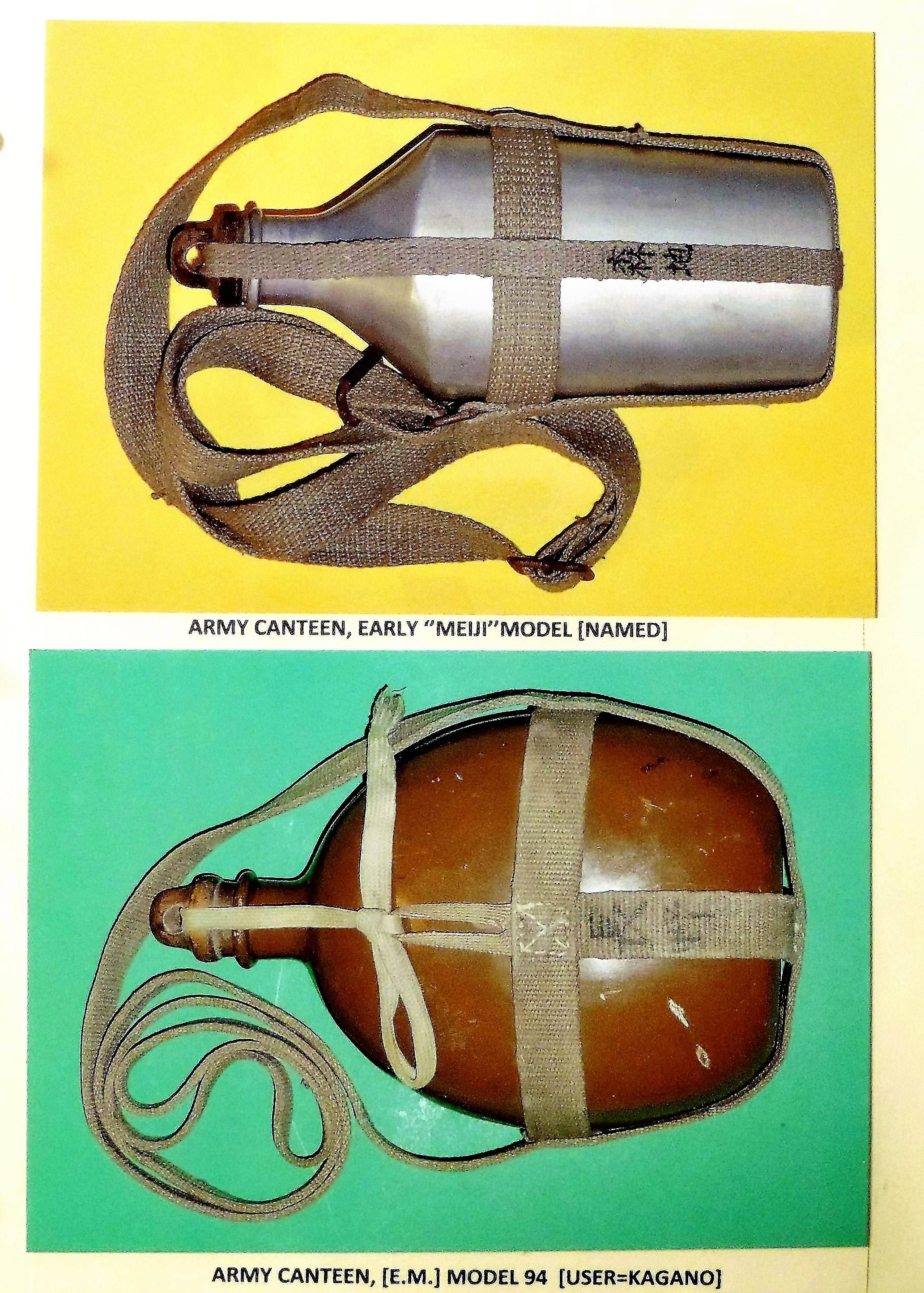
Figure 21. TOP - Army canteen early "Meiji" model (Named). BOTTOM - Army canteen, enlisted man, Model 94, (Named). |
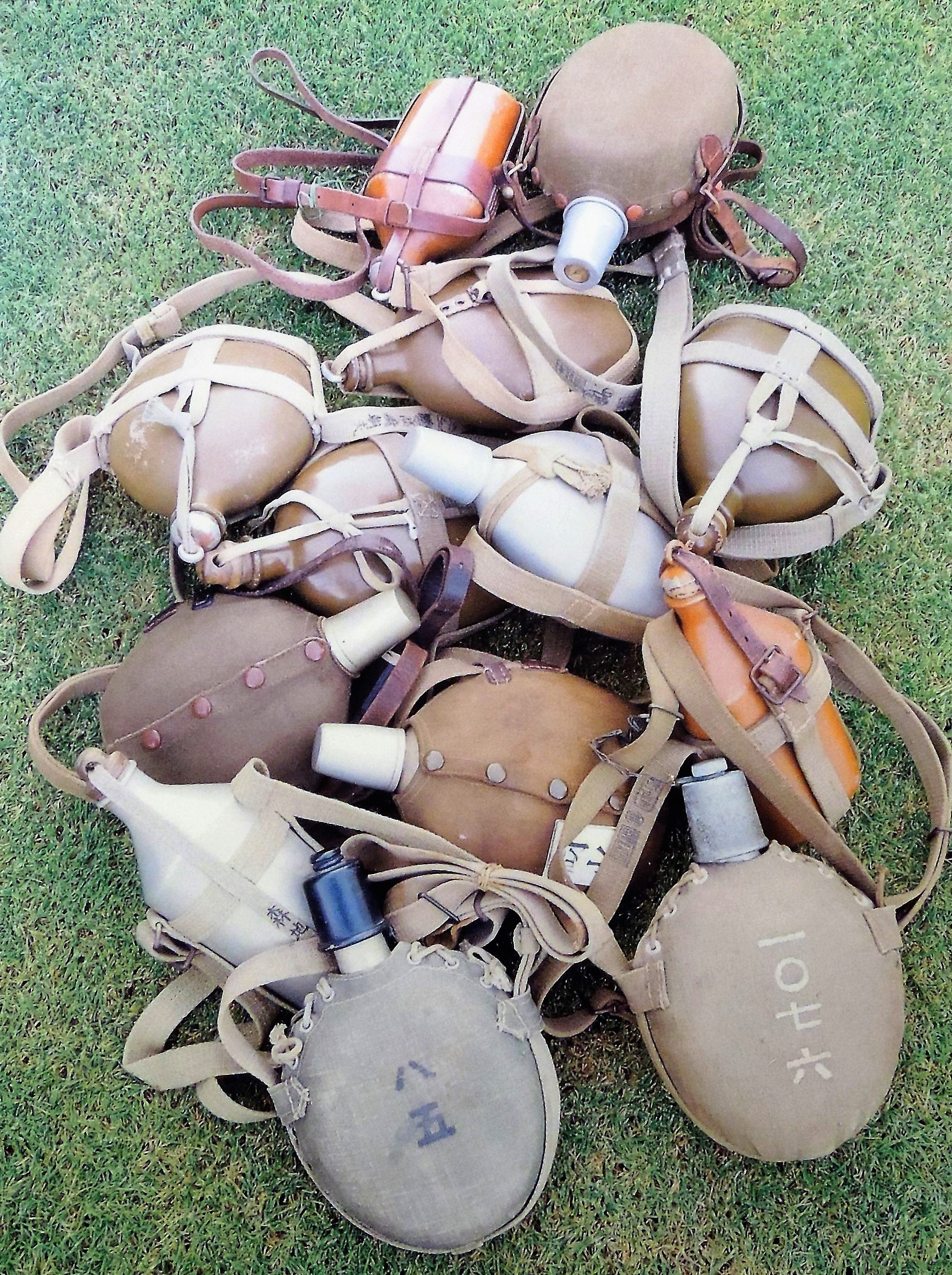
Figure 22. WWII Japanese canteens. |
The canteen cap operated by pressure. It had a loop on top so the leather securing strap could be connected. Some models were issued with an additional cover. Made of aluminum or bakelite. In the shape of a small cup as it would serve as one. A rare model of the cup came with a built-in compass. In similar fashion to the U.S. binocular case which also had a built in compass on top.
b. WWII Japanese Cold weather equipment.
(1) WWII Japanese military sleeping gear.
Even in cold climates the Japanese are unacquainted with the sleeping bag. Instead, woolen blankets which have an exceedingly, high percentage of cotton are used. Tue inefficiency of this sleeping gear is clearly demonstrated by the fact that seven blankets were issued to each Japanese soldier after the landing on Attu. The Japanese also use a cotton filled sleeping pad about 3 x 5 feet in size when sleeping in barracks or tents. This does not however appear to be part of field equipment. In the field Japanese ordinarilly take shelter in foxholes covering themselves merely with their shelter halves.
(2) WWII Mess kit and canteen covers.
Most field equipment used in cold climates is the same as that used elsewhere. However, because of the possibility of food or liquids freezing, snug fitting mess kit and canteen insulation covers, made of insulating material such as kapok or pile are provided.
(3) WWII Japanese military snow skis.
The Japanese use two types of skis, the standard normal length ski and the short glacial ski. Although the standard skis are of orthodox construction, the quality is generally quite poor.
The short glacial skis, averaging about 4 1/2 feet in length, are of fairly heavy construction; they are inflexible but easy to carry. Experienced skiers generally use the loug skis, while novices are given the shorter one. A simple, but rather in efficient metal and leather binding is used with both type of skis.
The Japanese do not issue a special ski boot but simply adopt a standard service shoe by putting steel protector on the edge of the sole and a special plate on the heel to hold Lhe heel-strnp in place. Such improvisation probably gives the skier only limited control over his skis. Ski poles are made of light cane. Plain web straps serve as ski climbers £or uphill traction.
(4) WWII Japanese military snow shoes.
The snow shoes used by the Japanese are of standard European type, oval and smaller than the usual American bearpaw snowshoe.
(c) WWII Japanese insect repellent.
The Japanese insect repellent consists of a cream the essential constituent of which is citronella. Issued in a round tin container with a pressure lid. It is not clear if the product delivered on its promise.
(d) WWII Japanese mosquito bars.
The mosquito bar is used in rear areas. These were rectangular bars made of a chemical designed to repel mosquitos. It is not clear the effectiveness of the product.

5. WWII JAPANESE MILITARY INSIGNIA, DECORATIONS, AND AWARDS.
a. WWII Japanese military rank Insignia.
lnsignia of grade are worn on the collars of coats when coats are worn, or on the collars of shirts when no coats are worn. When wearing heaVy cold weather clothing, insignia of rank generally are wom on either sleeve. Insignia of branch or service usually are worn on the right breast of either coats or shirts. However, in combat areas, neither officers nor men ordinaxily will wear any insignia of rank or branch of service.

Figure 148. WWII Japanese Army rank insignia chart for officer and enlisted men. |
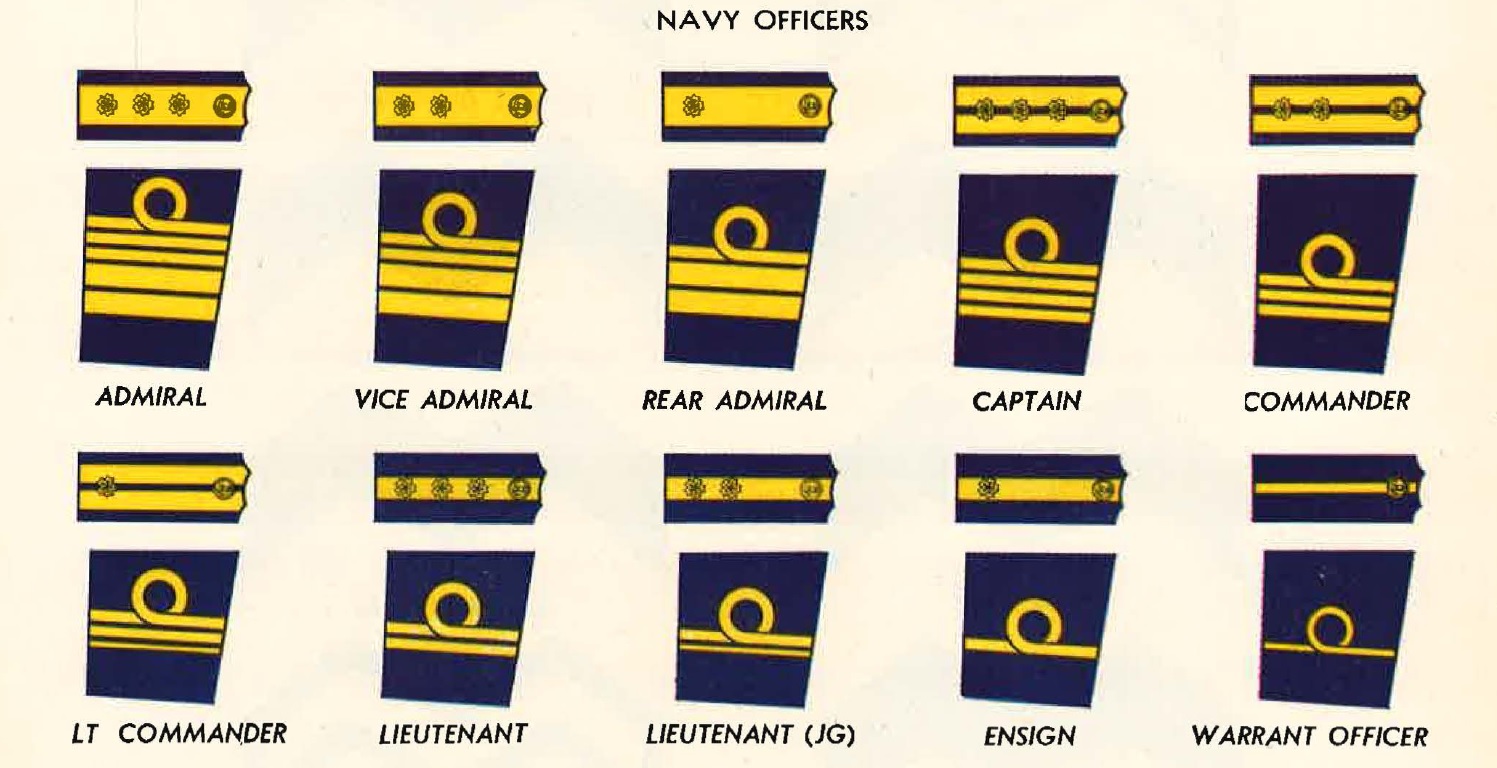
Figure 149. WWII Japanese Navy rank insignia chart for officers. |
b. WWII Japanese military occupation breast insignia.
Commanders of infantry often will wear some special insignia, such as crossed sashes of dark color, to enable their men to distinguish them. Recruits wear a white patch, sewed or pinned on the left breast of coat or shirt, on which is written their name and unit. In combat areas, all enlisted men may wear such a patch eontaining general information and occasionally, some mark of rank.
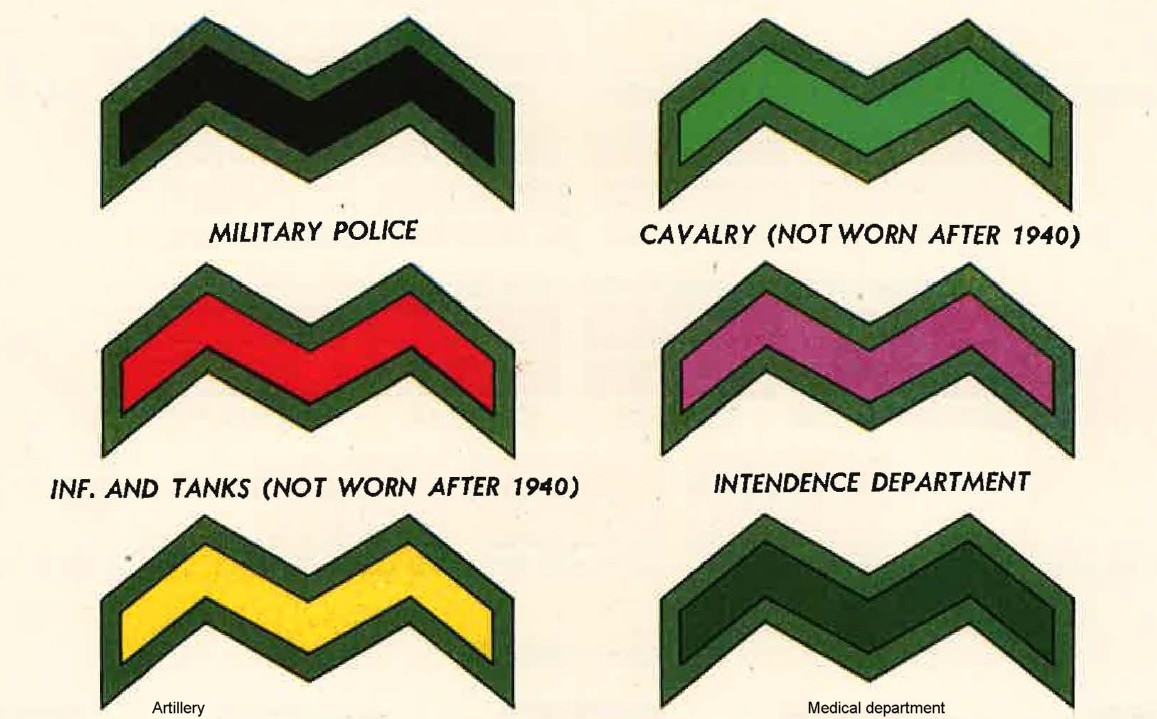
Figure 150. WWII Japanese Army breast insignia. |
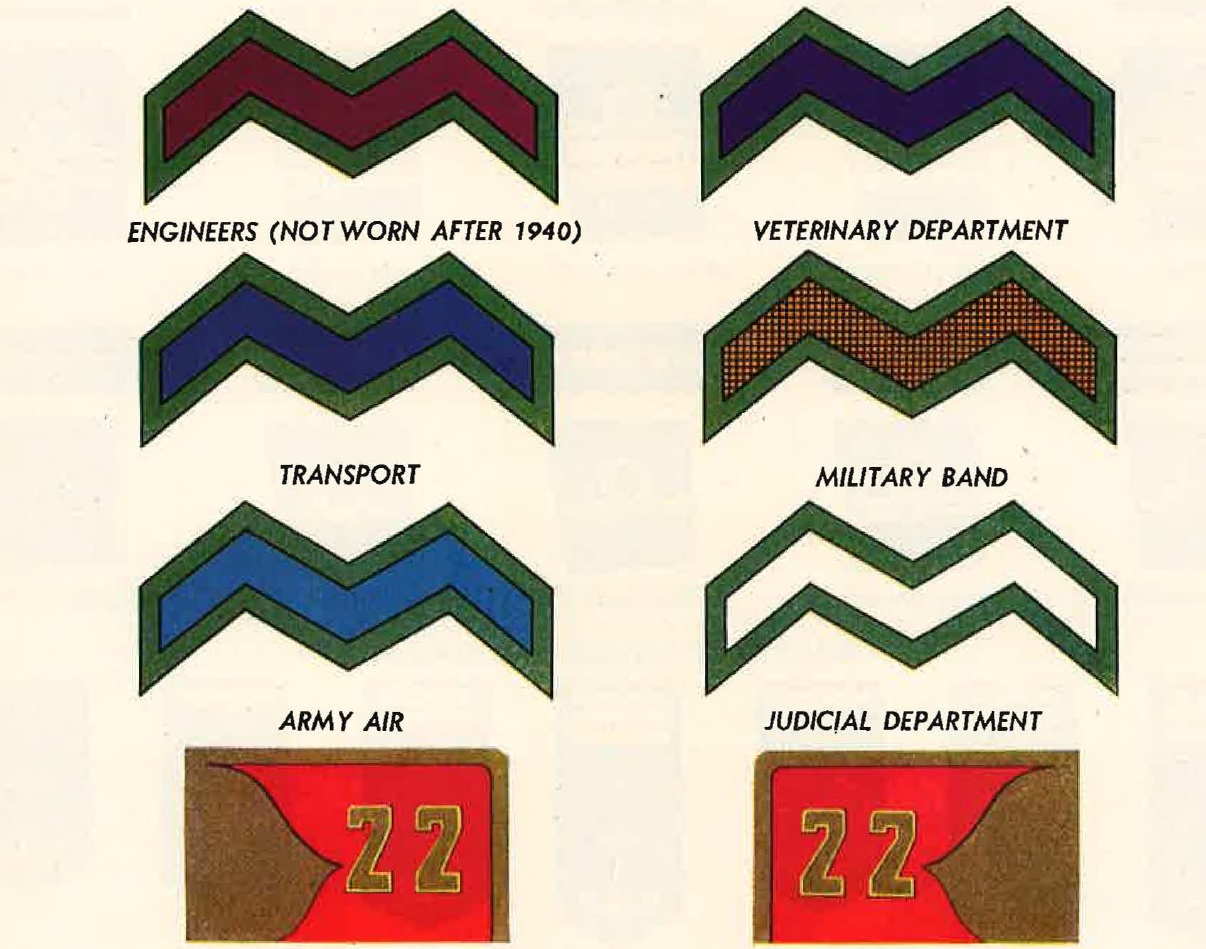
Figure 151. WWII Japanese Navy breast and collar insignia . |
c. WWII Japanese military medals and awards.
Orders of merit and decorations worn created in 1875 and supplemented in later years for the purpose of recognizing and rewarding persons who render distinguished and meritorious services to the state. The principal decorations available to military personnel are as follows:
1) The Order of the Golden Kite.
This decoration is purely military and is awarded for conspicuous service in operations against a foreign country. There are seven classes of this order, each carrying a life annuity. Enlisted personnel may be advanced only to the sixth order.
(2) WWII Japanese The Order of Rising Sun.
This decoration is not limited to the military, and is awarded to those who have rendered meritorious services. There are eight classes of this order, of which two are available to enlisted personnel. Foreigners occassionally are awarded this decoration.
(3) The WWII Japanese Order of the Sacred Treasure.
This decoration is awarded in both peace and war and is not limited to the military. It is awarded for long service with good conduct and does not carry a life annuity. There are eight classes, of which two are for enlisted men.
(4) In addition to these three principal decorations, medals for distinguished service (Kunko Sho), meritorious service (Kunro Sho), and exceptional service (Koro Sho) are issued. For those whose services are "not inconsiderable" but are not qualified for these three medals, a monetary award may be granted. Campaign medals, good conduct medals, and badges for profficiency in different branches of the service also are awarded.
(5) The following awards are made:
(a) Diploma of merit.
This may be awarded to either a unit as a whole or to individuals for distinguished service in front of the enemy.
(b) Wound badge.
This is granted to anyone who, as the result of being wounded in action thereby is entitled to an increase in pension in accordance with pension regulation.
(c) Medal for next of kin of those killed in action.
This is also issued to the next of kin of anyone who has died within three years after contracting an illness resulting from active service.
(d) Other awards available to non-commissioned officers and privates are:
- Good conduct badge (Kinko Sho).
- Good conduct certificate (Zenko Shosho).
- Diligen ·e badge (Seikin Sho),
- Victory medal (Sensho Kisho).
